BMW Company Strategic Management
VerifiedAdded on 2021/09/27
|54
|12213
|690
AI Summary
Contribute Materials
Your contribution can guide someone’s learning journey. Share your
documents today.
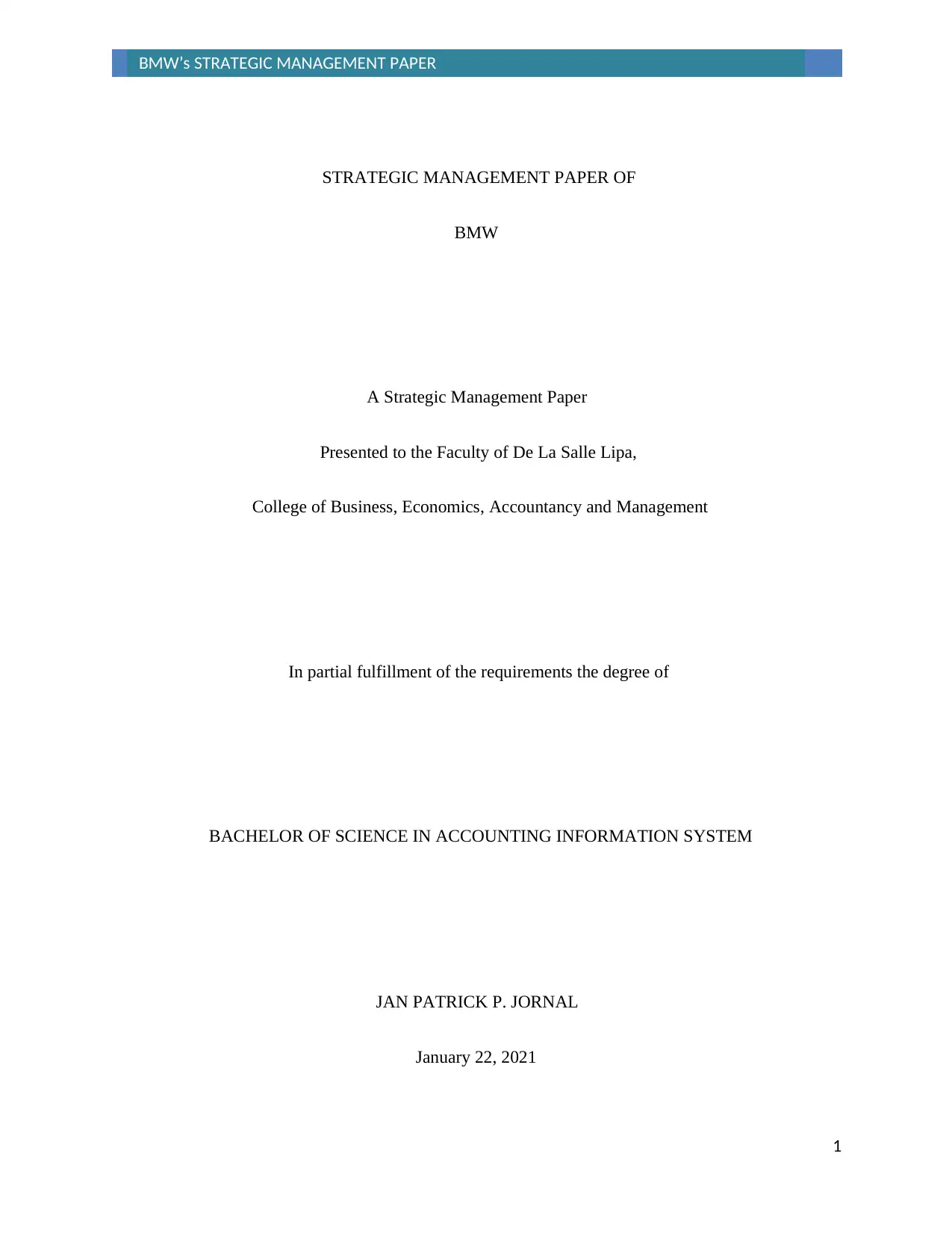
1
BMW’s STRATEGIC MANAGEMENT PAPER
STRATEGIC MANAGEMENT PAPER OF
BMW
A Strategic Management Paper
Presented to the Faculty of De La Salle Lipa,
College of Business, Economics, Accountancy and Management
In partial fulfillment of the requirements the degree of
BACHELOR OF SCIENCE IN ACCOUNTING INFORMATION SYSTEM
JAN PATRICK P. JORNAL
January 22, 2021
BMW’s STRATEGIC MANAGEMENT PAPER
STRATEGIC MANAGEMENT PAPER OF
BMW
A Strategic Management Paper
Presented to the Faculty of De La Salle Lipa,
College of Business, Economics, Accountancy and Management
In partial fulfillment of the requirements the degree of
BACHELOR OF SCIENCE IN ACCOUNTING INFORMATION SYSTEM
JAN PATRICK P. JORNAL
January 22, 2021
Secure Best Marks with AI Grader
Need help grading? Try our AI Grader for instant feedback on your assignments.
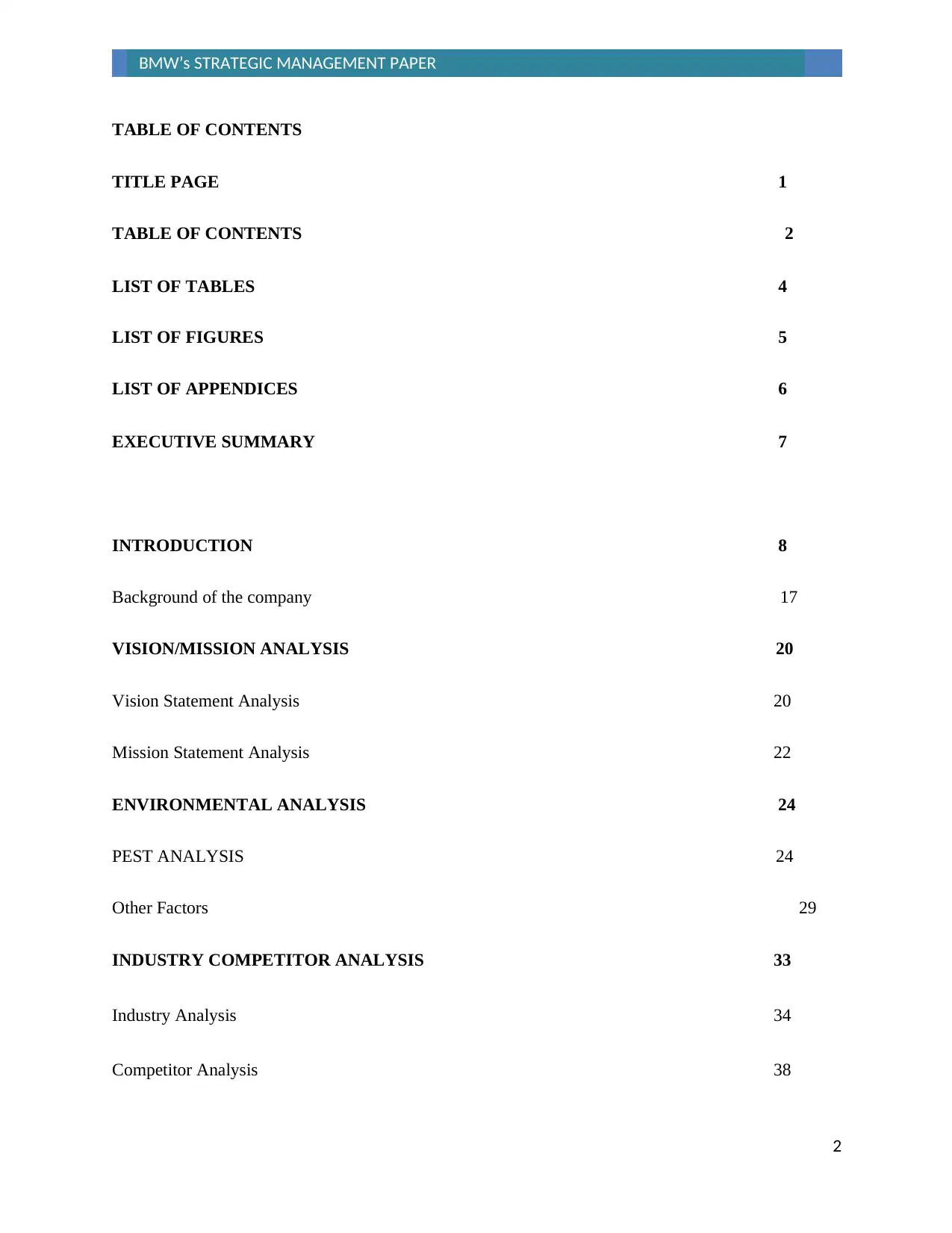
2
BMW’s STRATEGIC MANAGEMENT PAPER
TABLE OF CONTENTS
TITLE PAGE 1
TABLE OF CONTENTS 2
LIST OF TABLES 4
LIST OF FIGURES 5
LIST OF APPENDICES 6
EXECUTIVE SUMMARY 7
INTRODUCTION 8
Background of the company 17
VISION/MISSION ANALYSIS 20
Vision Statement Analysis 20
Mission Statement Analysis 22
ENVIRONMENTAL ANALYSIS 24
PEST ANALYSIS 24
Other Factors 29
INDUSTRY COMPETITOR ANALYSIS 33
Industry Analysis 34
Competitor Analysis 38
BMW’s STRATEGIC MANAGEMENT PAPER
TABLE OF CONTENTS
TITLE PAGE 1
TABLE OF CONTENTS 2
LIST OF TABLES 4
LIST OF FIGURES 5
LIST OF APPENDICES 6
EXECUTIVE SUMMARY 7
INTRODUCTION 8
Background of the company 17
VISION/MISSION ANALYSIS 20
Vision Statement Analysis 20
Mission Statement Analysis 22
ENVIRONMENTAL ANALYSIS 24
PEST ANALYSIS 24
Other Factors 29
INDUSTRY COMPETITOR ANALYSIS 33
Industry Analysis 34
Competitor Analysis 38
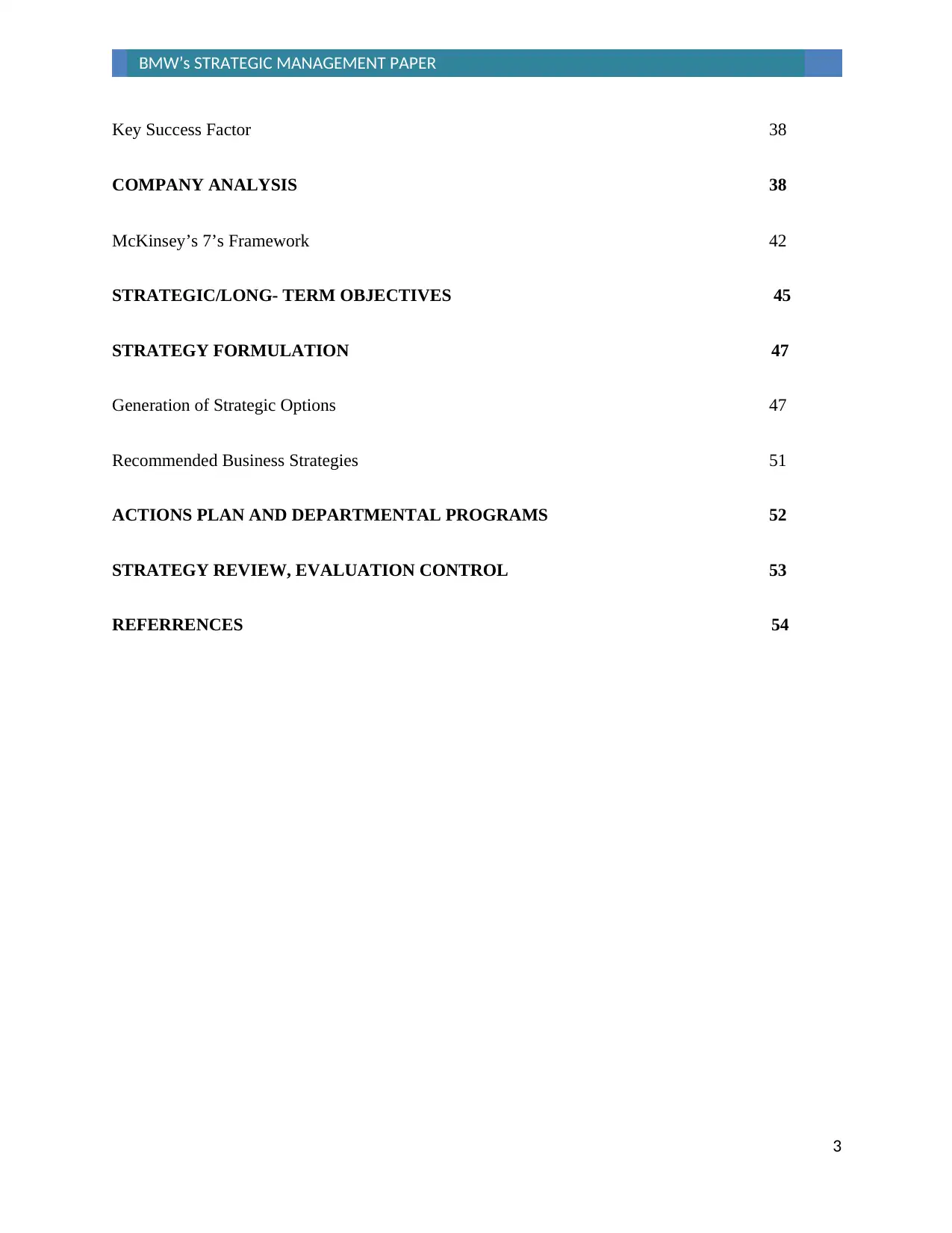
3
BMW’s STRATEGIC MANAGEMENT PAPER
Key Success Factor 38
COMPANY ANALYSIS 38
McKinsey’s 7’s Framework 42
STRATEGIC/LONG- TERM OBJECTIVES 45
STRATEGY FORMULATION 47
Generation of Strategic Options 47
Recommended Business Strategies 51
ACTIONS PLAN AND DEPARTMENTAL PROGRAMS 52
STRATEGY REVIEW, EVALUATION CONTROL 53
REFERRENCES 54
BMW’s STRATEGIC MANAGEMENT PAPER
Key Success Factor 38
COMPANY ANALYSIS 38
McKinsey’s 7’s Framework 42
STRATEGIC/LONG- TERM OBJECTIVES 45
STRATEGY FORMULATION 47
Generation of Strategic Options 47
Recommended Business Strategies 51
ACTIONS PLAN AND DEPARTMENTAL PROGRAMS 52
STRATEGY REVIEW, EVALUATION CONTROL 53
REFERRENCES 54
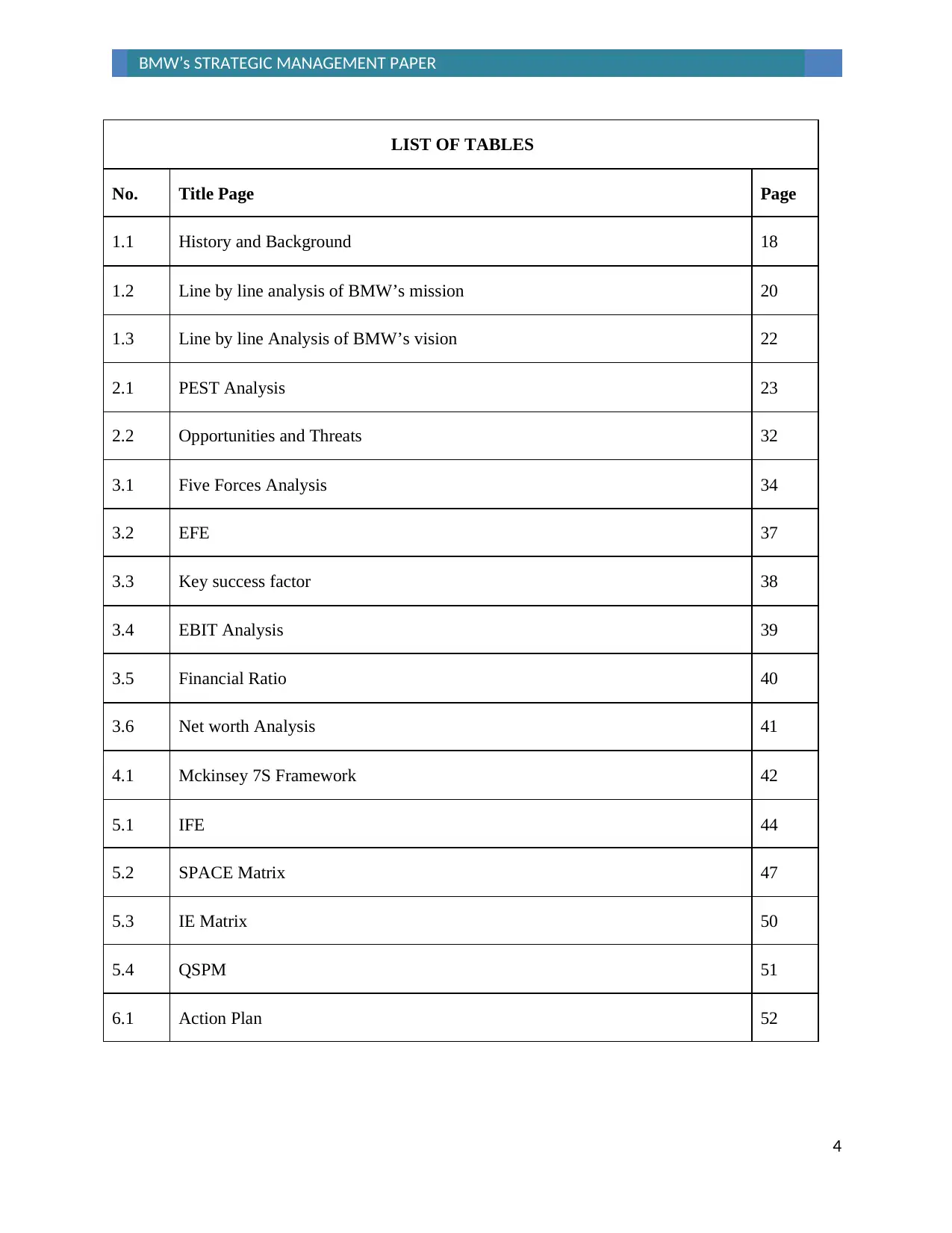
4
BMW’s STRATEGIC MANAGEMENT PAPER
LIST OF TABLES
No. Title Page Page
1.1 History and Background 18
1.2 Line by line analysis of BMW’s mission 20
1.3 Line by line Analysis of BMW’s vision 22
2.1 PEST Analysis 23
2.2 Opportunities and Threats 32
3.1 Five Forces Analysis 34
3.2 EFE 37
3.3 Key success factor 38
3.4 EBIT Analysis 39
3.5 Financial Ratio 40
3.6 Net worth Analysis 41
4.1 Mckinsey 7S Framework 42
5.1 IFE 44
5.2 SPACE Matrix 47
5.3 IE Matrix 50
5.4 QSPM 51
6.1 Action Plan 52
BMW’s STRATEGIC MANAGEMENT PAPER
LIST OF TABLES
No. Title Page Page
1.1 History and Background 18
1.2 Line by line analysis of BMW’s mission 20
1.3 Line by line Analysis of BMW’s vision 22
2.1 PEST Analysis 23
2.2 Opportunities and Threats 32
3.1 Five Forces Analysis 34
3.2 EFE 37
3.3 Key success factor 38
3.4 EBIT Analysis 39
3.5 Financial Ratio 40
3.6 Net worth Analysis 41
4.1 Mckinsey 7S Framework 42
5.1 IFE 44
5.2 SPACE Matrix 47
5.3 IE Matrix 50
5.4 QSPM 51
6.1 Action Plan 52
Secure Best Marks with AI Grader
Need help grading? Try our AI Grader for instant feedback on your assignments.
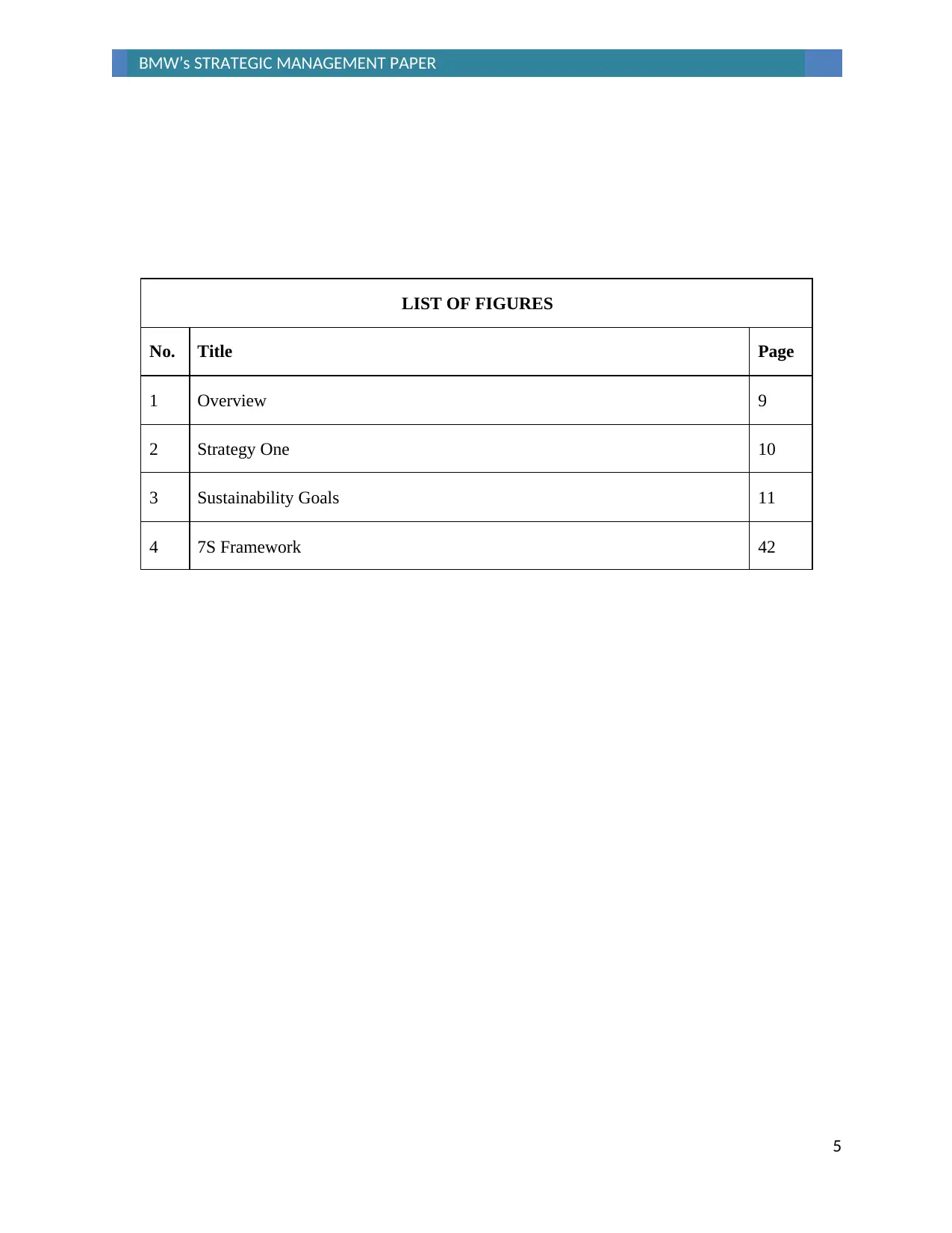
5
BMW’s STRATEGIC MANAGEMENT PAPER
LIST OF FIGURES
No. Title Page
1 Overview 9
2 Strategy One 10
3 Sustainability Goals 11
4 7S Framework 42
BMW’s STRATEGIC MANAGEMENT PAPER
LIST OF FIGURES
No. Title Page
1 Overview 9
2 Strategy One 10
3 Sustainability Goals 11
4 7S Framework 42
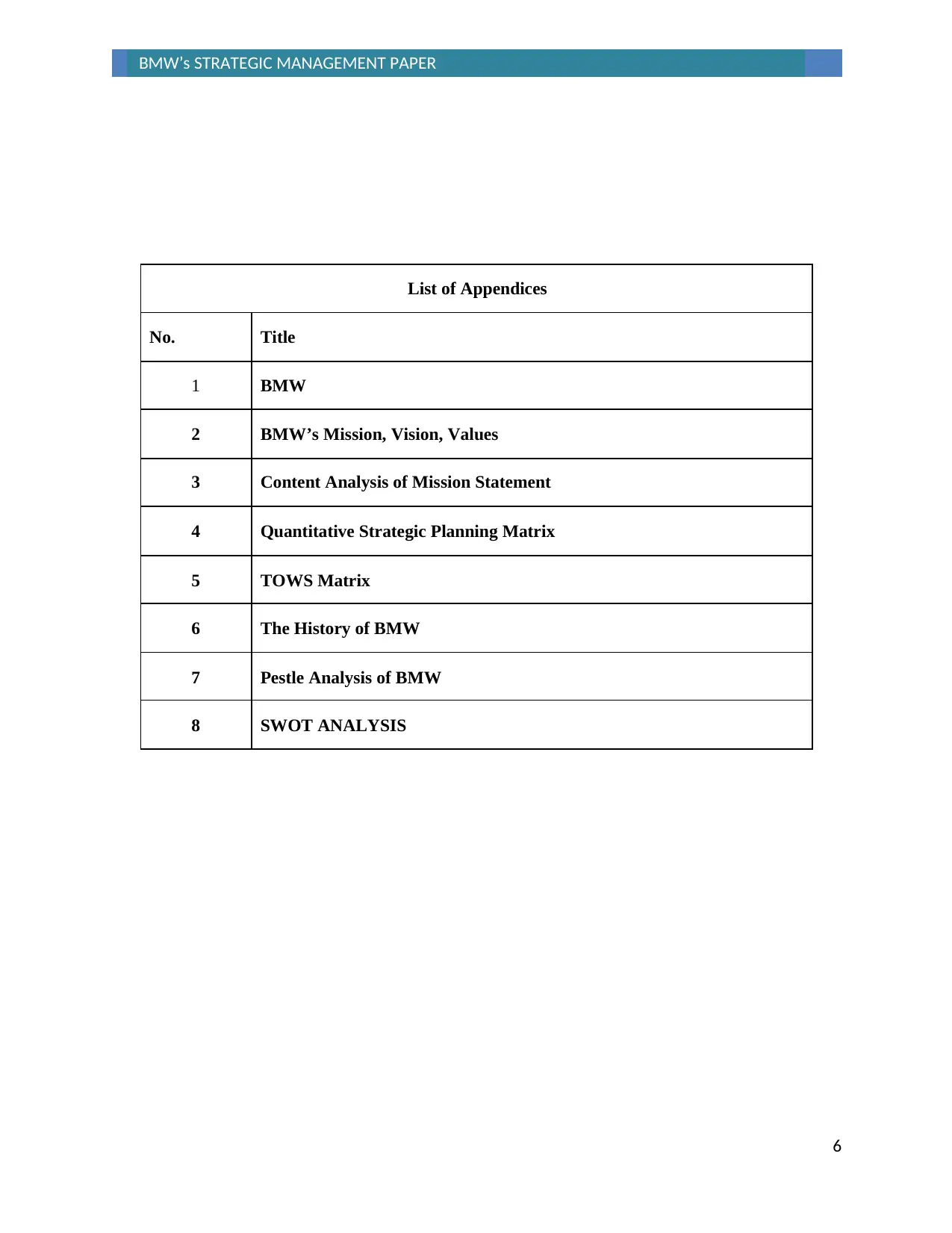
6
BMW’s STRATEGIC MANAGEMENT PAPER
List of Appendices
No. Title
1 BMW
2 BMW’s Mission, Vision, Values
3 Content Analysis of Mission Statement
4 Quantitative Strategic Planning Matrix
5 TOWS Matrix
6 The History of BMW
7 Pestle Analysis of BMW
8 SWOT ANALYSIS
BMW’s STRATEGIC MANAGEMENT PAPER
List of Appendices
No. Title
1 BMW
2 BMW’s Mission, Vision, Values
3 Content Analysis of Mission Statement
4 Quantitative Strategic Planning Matrix
5 TOWS Matrix
6 The History of BMW
7 Pestle Analysis of BMW
8 SWOT ANALYSIS
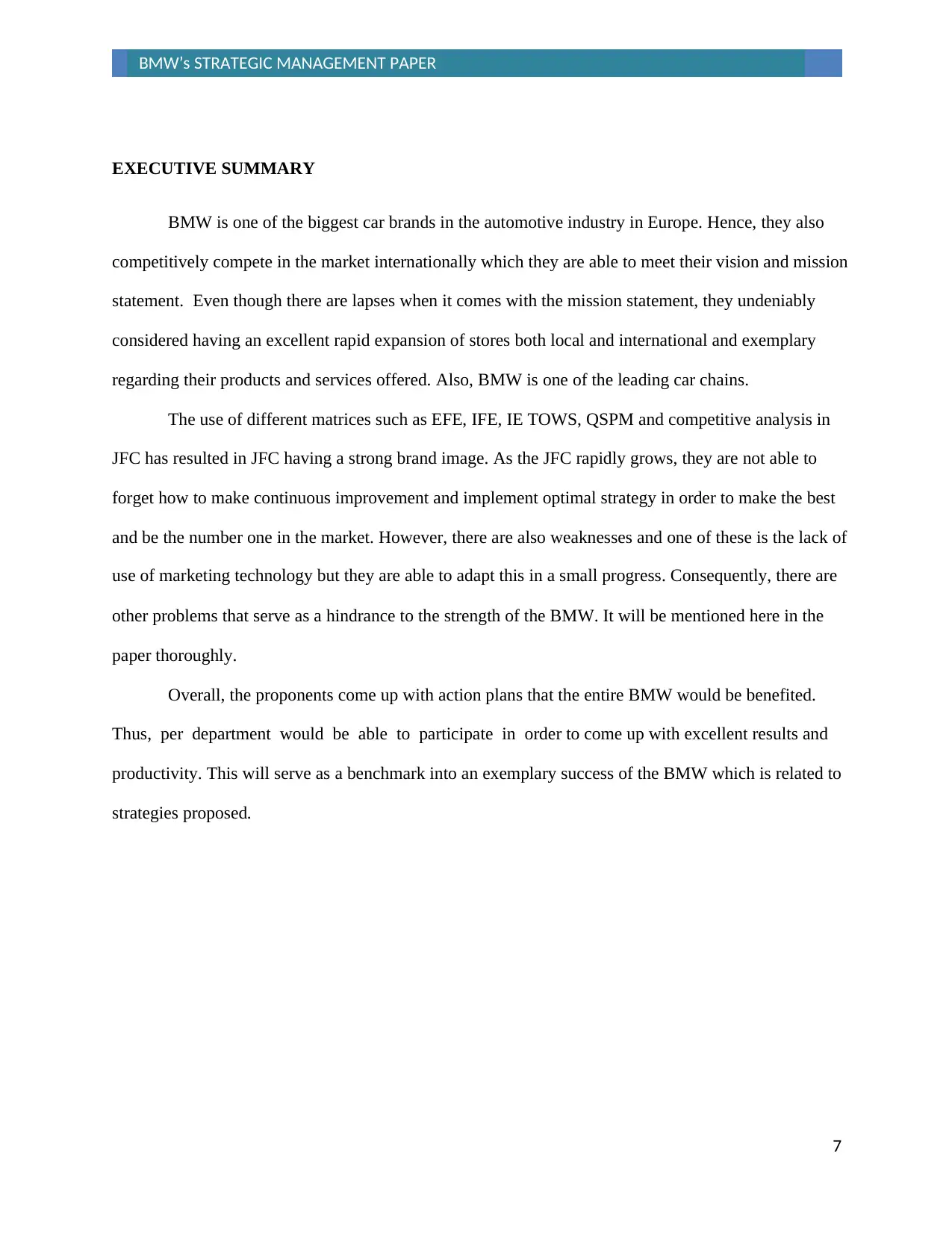
7
BMW’s STRATEGIC MANAGEMENT PAPER
EXECUTIVE SUMMARY
BMW is one of the biggest car brands in the automotive industry in Europe. Hence, they also
competitively compete in the market internationally which they are able to meet their vision and mission
statement. Even though there are lapses when it comes with the mission statement, they undeniably
considered having an excellent rapid expansion of stores both local and international and exemplary
regarding their products and services offered. Also, BMW is one of the leading car chains.
The use of different matrices such as EFE, IFE, IE TOWS, QSPM and competitive analysis in
JFC has resulted in JFC having a strong brand image. As the JFC rapidly grows, they are not able to
forget how to make continuous improvement and implement optimal strategy in order to make the best
and be the number one in the market. However, there are also weaknesses and one of these is the lack of
use of marketing technology but they are able to adapt this in a small progress. Consequently, there are
other problems that serve as a hindrance to the strength of the BMW. It will be mentioned here in the
paper thoroughly.
Overall, the proponents come up with action plans that the entire BMW would be benefited.
Thus, per department would be able to participate in order to come up with excellent results and
productivity. This will serve as a benchmark into an exemplary success of the BMW which is related to
strategies proposed.
BMW’s STRATEGIC MANAGEMENT PAPER
EXECUTIVE SUMMARY
BMW is one of the biggest car brands in the automotive industry in Europe. Hence, they also
competitively compete in the market internationally which they are able to meet their vision and mission
statement. Even though there are lapses when it comes with the mission statement, they undeniably
considered having an excellent rapid expansion of stores both local and international and exemplary
regarding their products and services offered. Also, BMW is one of the leading car chains.
The use of different matrices such as EFE, IFE, IE TOWS, QSPM and competitive analysis in
JFC has resulted in JFC having a strong brand image. As the JFC rapidly grows, they are not able to
forget how to make continuous improvement and implement optimal strategy in order to make the best
and be the number one in the market. However, there are also weaknesses and one of these is the lack of
use of marketing technology but they are able to adapt this in a small progress. Consequently, there are
other problems that serve as a hindrance to the strength of the BMW. It will be mentioned here in the
paper thoroughly.
Overall, the proponents come up with action plans that the entire BMW would be benefited.
Thus, per department would be able to participate in order to come up with excellent results and
productivity. This will serve as a benchmark into an exemplary success of the BMW which is related to
strategies proposed.
Paraphrase This Document
Need a fresh take? Get an instant paraphrase of this document with our AI Paraphraser
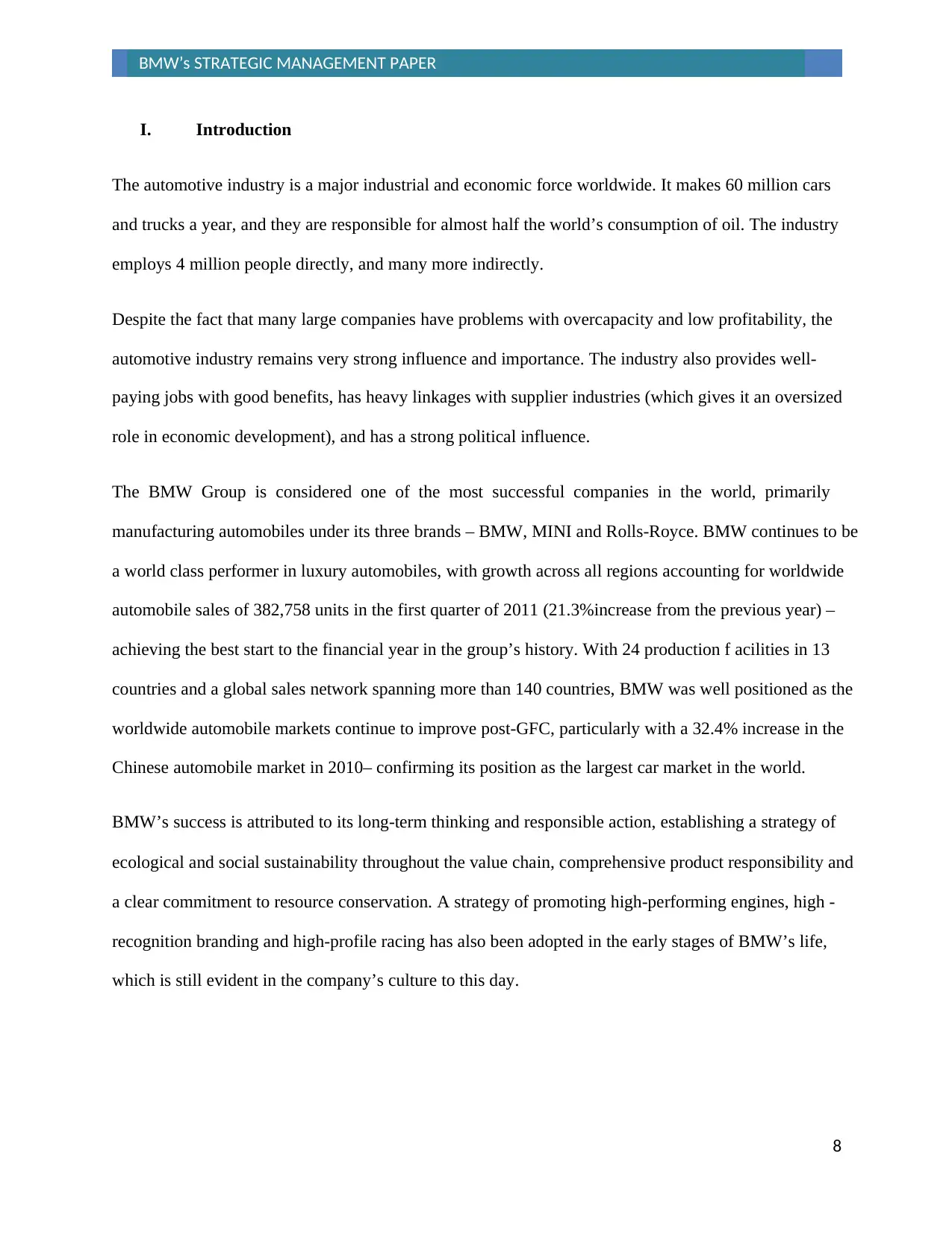
8
BMW’s STRATEGIC MANAGEMENT PAPER
I. Introduction
The automotive industry is a major industrial and economic force worldwide. It makes 60 million cars
and trucks a year, and they are responsible for almost half the world’s consumption of oil. The industry
employs 4 million people directly, and many more indirectly.
Despite the fact that many large companies have problems with overcapacity and low profitability, the
automotive industry remains very strong influence and importance. The industry also provides well-
paying jobs with good benefits, has heavy linkages with supplier industries (which gives it an oversized
role in economic development), and has a strong political influence.
The BMW Group is considered one of the most successful companies in the world, primarily
manufacturing automobiles under its three brands – BMW, MINI and Rolls-Royce. BMW continues to be
a world class performer in luxury automobiles, with growth across all regions accounting for worldwide
automobile sales of 382,758 units in the first quarter of 2011 (21.3%increase from the previous year) –
achieving the best start to the financial year in the group’s history. With 24 production f acilities in 13
countries and a global sales network spanning more than 140 countries, BMW was well positioned as the
worldwide automobile markets continue to improve post-GFC, particularly with a 32.4% increase in the
Chinese automobile market in 2010– confirming its position as the largest car market in the world.
BMW’s success is attributed to its long-term thinking and responsible action, establishing a strategy of
ecological and social sustainability throughout the value chain, comprehensive product responsibility and
a clear commitment to resource conservation. A strategy of promoting high-performing engines, high -
recognition branding and high-profile racing has also been adopted in the early stages of BMW’s life,
which is still evident in the company’s culture to this day.
BMW’s STRATEGIC MANAGEMENT PAPER
I. Introduction
The automotive industry is a major industrial and economic force worldwide. It makes 60 million cars
and trucks a year, and they are responsible for almost half the world’s consumption of oil. The industry
employs 4 million people directly, and many more indirectly.
Despite the fact that many large companies have problems with overcapacity and low profitability, the
automotive industry remains very strong influence and importance. The industry also provides well-
paying jobs with good benefits, has heavy linkages with supplier industries (which gives it an oversized
role in economic development), and has a strong political influence.
The BMW Group is considered one of the most successful companies in the world, primarily
manufacturing automobiles under its three brands – BMW, MINI and Rolls-Royce. BMW continues to be
a world class performer in luxury automobiles, with growth across all regions accounting for worldwide
automobile sales of 382,758 units in the first quarter of 2011 (21.3%increase from the previous year) –
achieving the best start to the financial year in the group’s history. With 24 production f acilities in 13
countries and a global sales network spanning more than 140 countries, BMW was well positioned as the
worldwide automobile markets continue to improve post-GFC, particularly with a 32.4% increase in the
Chinese automobile market in 2010– confirming its position as the largest car market in the world.
BMW’s success is attributed to its long-term thinking and responsible action, establishing a strategy of
ecological and social sustainability throughout the value chain, comprehensive product responsibility and
a clear commitment to resource conservation. A strategy of promoting high-performing engines, high -
recognition branding and high-profile racing has also been adopted in the early stages of BMW’s life,
which is still evident in the company’s culture to this day.
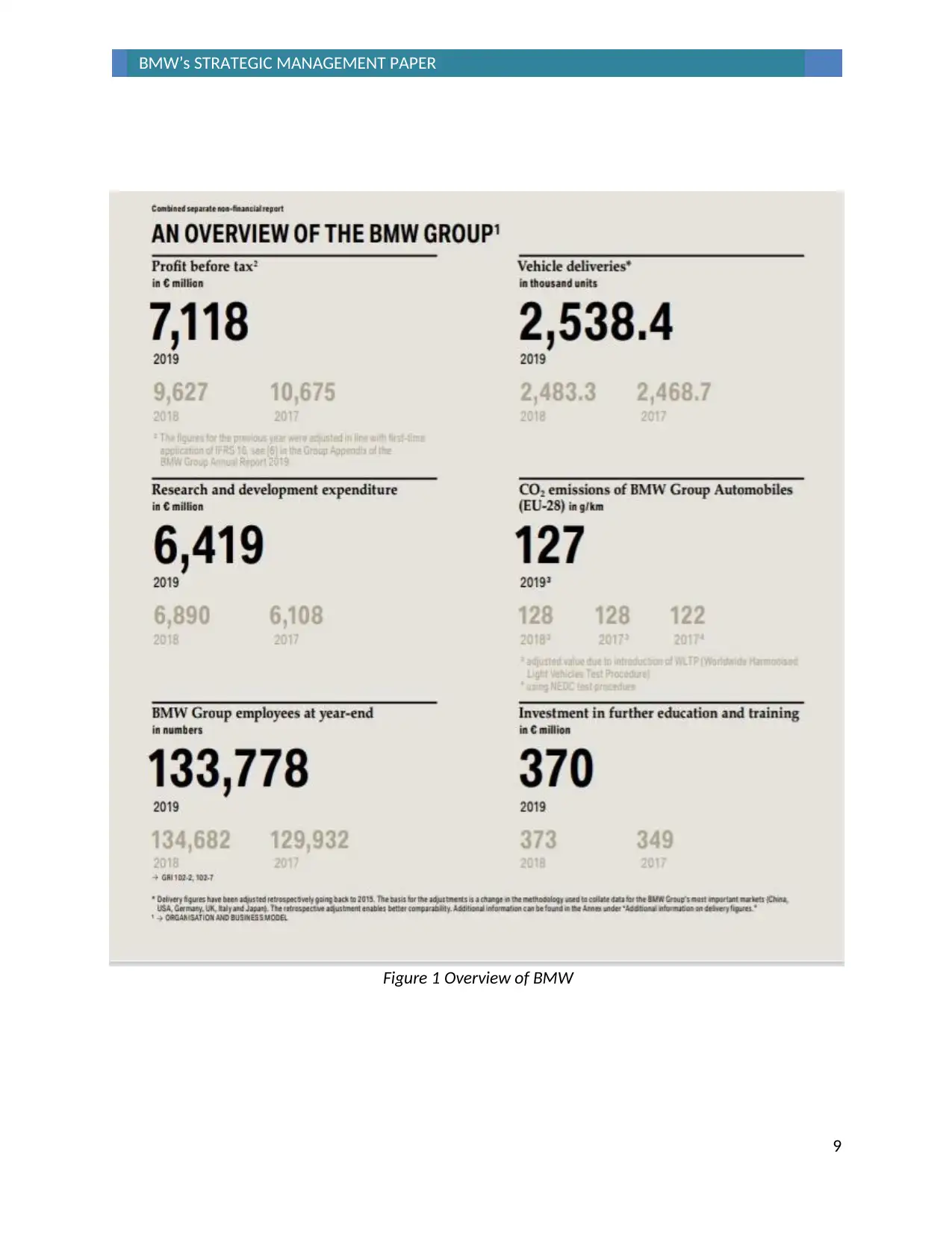
9
BMW’s STRATEGIC MANAGEMENT PAPER
Figure 1 Overview of BMW
BMW’s STRATEGIC MANAGEMENT PAPER
Figure 1 Overview of BMW
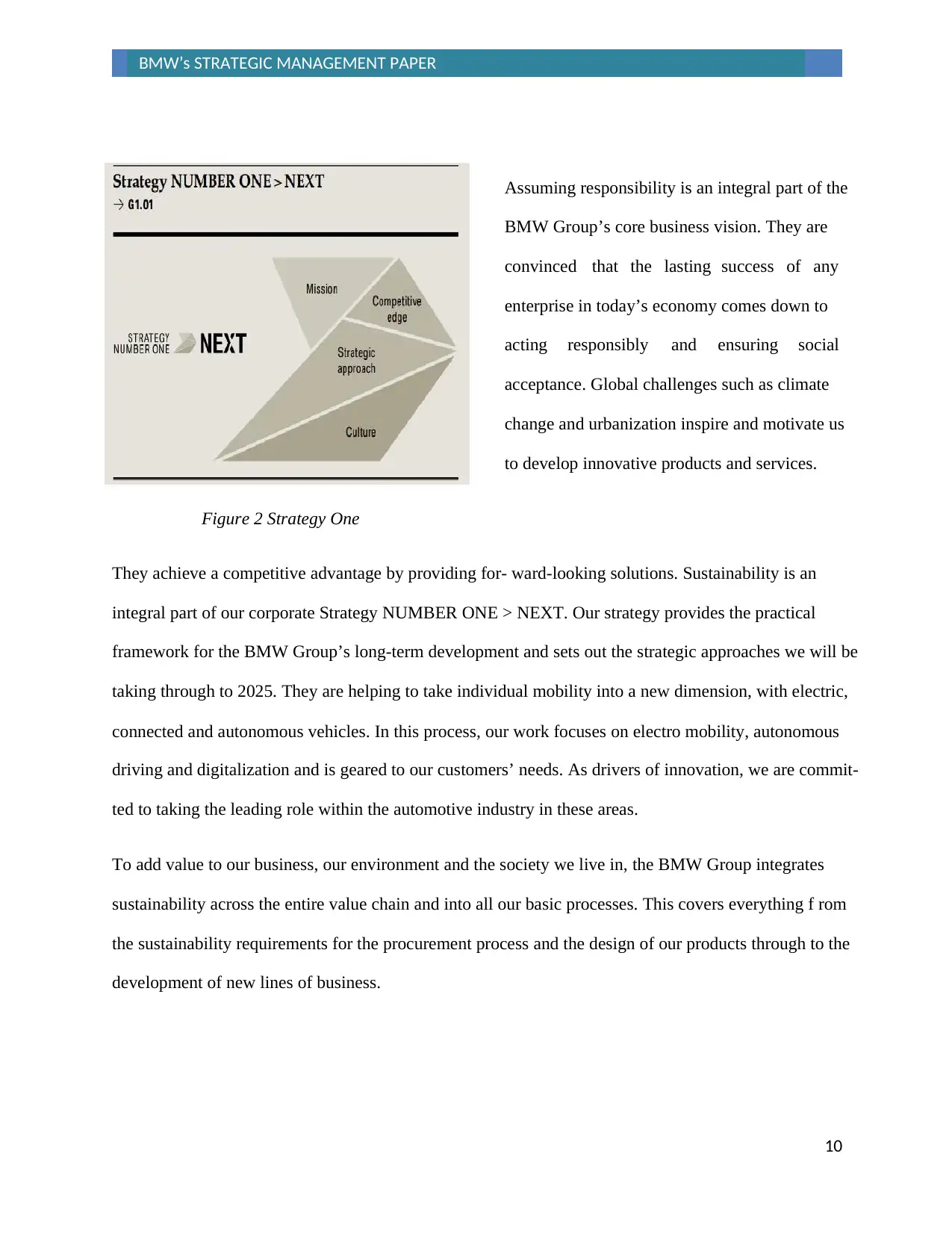
10
BMW’s STRATEGIC MANAGEMENT PAPER
Assuming responsibility is an integral part of the
BMW Group’s core business vision. They are
convinced that the lasting success of any
enterprise in today’s economy comes down to
acting responsibly and ensuring social
acceptance. Global challenges such as climate
change and urbanization inspire and motivate us
to develop innovative products and services.
Figure 2 Strategy One
They achieve a competitive advantage by providing for- ward-looking solutions. Sustainability is an
integral part of our corporate Strategy NUMBER ONE > NEXT. Our strategy provides the practical
framework for the BMW Group’s long-term development and sets out the strategic approaches we will be
taking through to 2025. They are helping to take individual mobility into a new dimension, with electric,
connected and autonomous vehicles. In this process, our work focuses on electro mobility, autonomous
driving and digitalization and is geared to our customers’ needs. As drivers of innovation, we are commit-
ted to taking the leading role within the automotive industry in these areas.
To add value to our business, our environment and the society we live in, the BMW Group integrates
sustainability across the entire value chain and into all our basic processes. This covers everything f rom
the sustainability requirements for the procurement process and the design of our products through to the
development of new lines of business.
BMW’s STRATEGIC MANAGEMENT PAPER
Assuming responsibility is an integral part of the
BMW Group’s core business vision. They are
convinced that the lasting success of any
enterprise in today’s economy comes down to
acting responsibly and ensuring social
acceptance. Global challenges such as climate
change and urbanization inspire and motivate us
to develop innovative products and services.
Figure 2 Strategy One
They achieve a competitive advantage by providing for- ward-looking solutions. Sustainability is an
integral part of our corporate Strategy NUMBER ONE > NEXT. Our strategy provides the practical
framework for the BMW Group’s long-term development and sets out the strategic approaches we will be
taking through to 2025. They are helping to take individual mobility into a new dimension, with electric,
connected and autonomous vehicles. In this process, our work focuses on electro mobility, autonomous
driving and digitalization and is geared to our customers’ needs. As drivers of innovation, we are commit-
ted to taking the leading role within the automotive industry in these areas.
To add value to our business, our environment and the society we live in, the BMW Group integrates
sustainability across the entire value chain and into all our basic processes. This covers everything f rom
the sustainability requirements for the procurement process and the design of our products through to the
development of new lines of business.
Secure Best Marks with AI Grader
Need help grading? Try our AI Grader for instant feedback on your assignments.
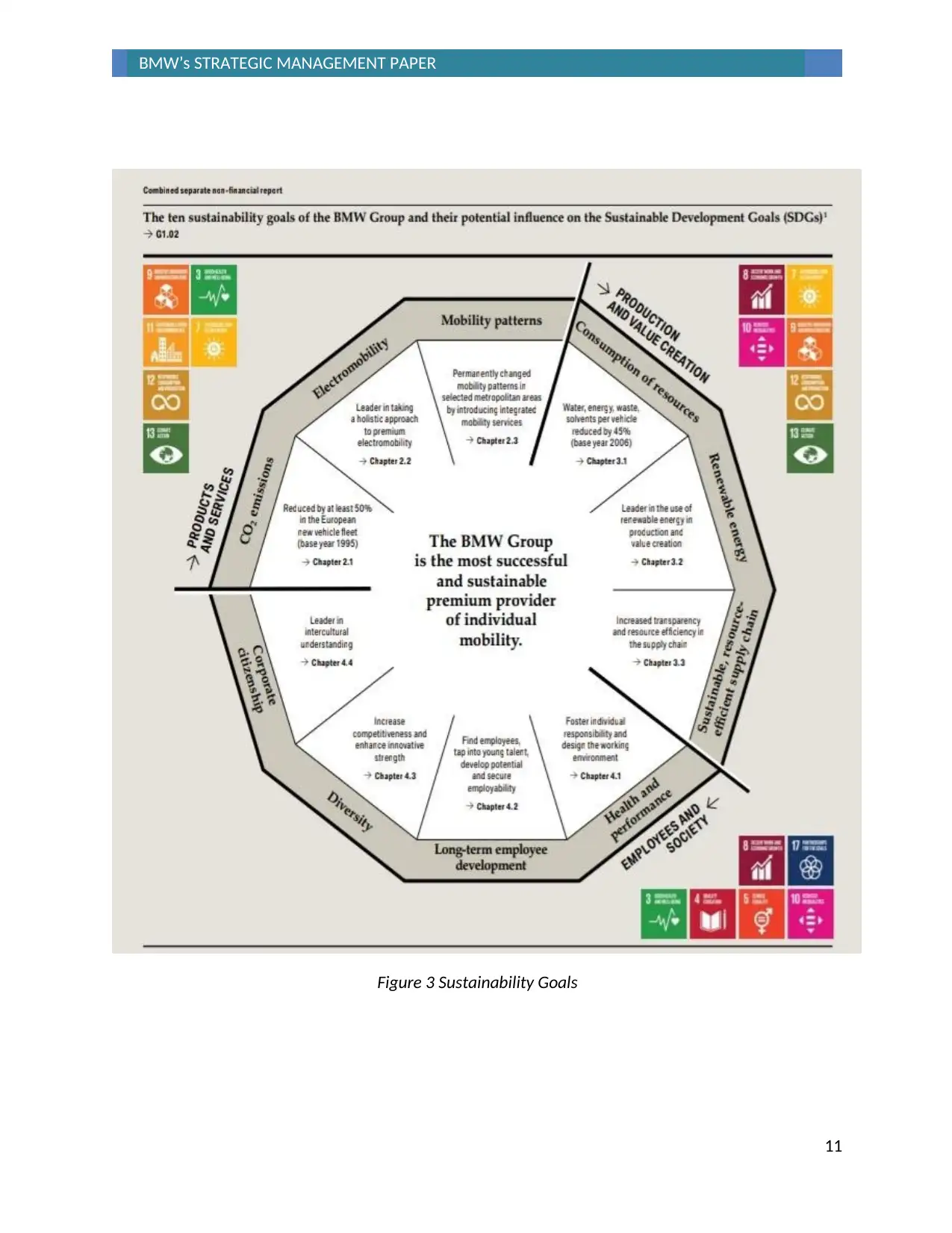
11
BMW’s STRATEGIC MANAGEMENT PAPER
Figure 3 Sustainability Goals
BMW’s STRATEGIC MANAGEMENT PAPER
Figure 3 Sustainability Goals
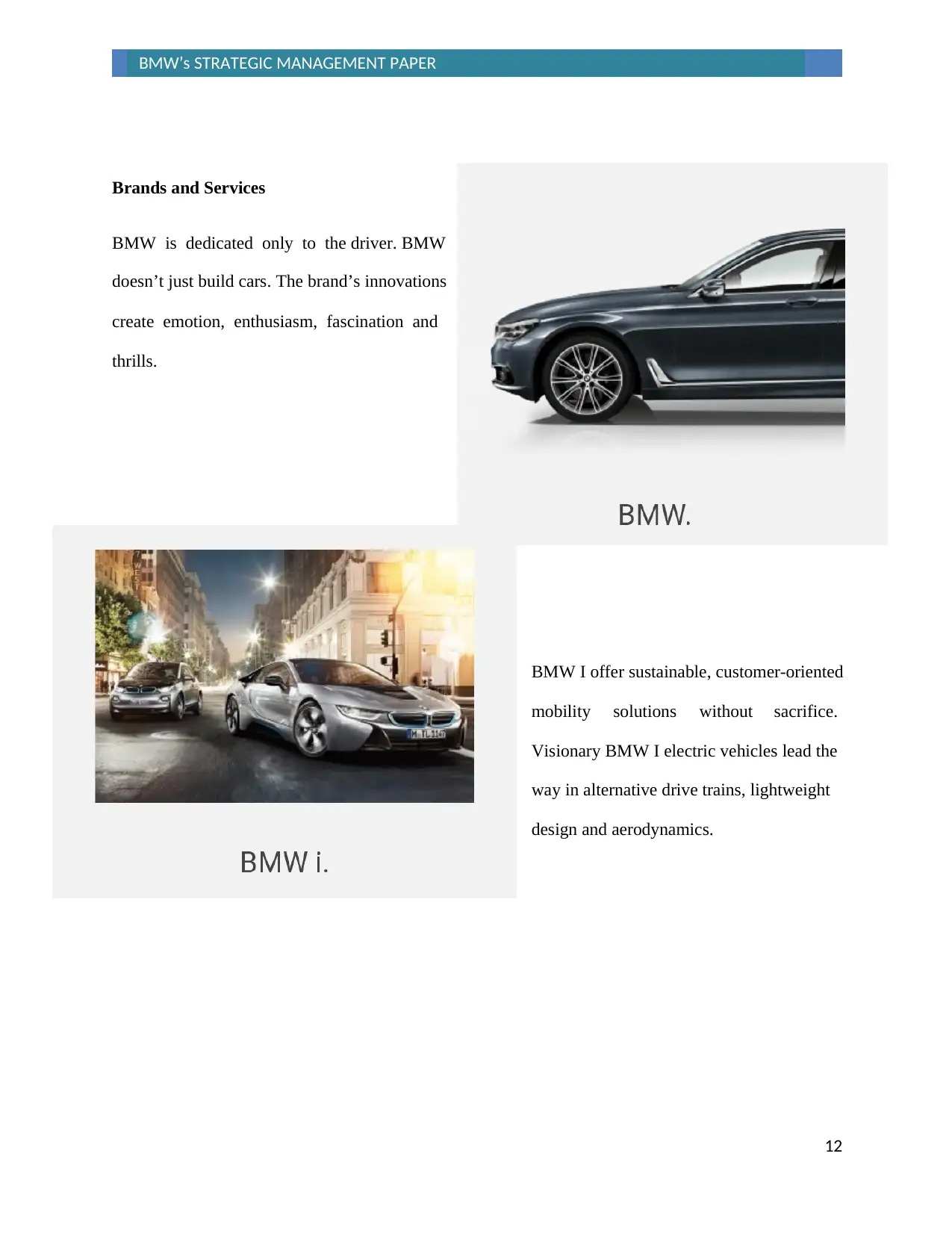
12
BMW’s STRATEGIC MANAGEMENT PAPER
Brands and Services
BMW is dedicated only to the driver. BMW
doesn’t just build cars. The brand’s innovations
create emotion, enthusiasm, fascination and
thrills.
BMW I offer sustainable, customer-oriented
mobility solutions without sacrifice.
Visionary BMW I electric vehicles lead the
way in alternative drive trains, lightweight
design and aerodynamics.
BMW’s STRATEGIC MANAGEMENT PAPER
Brands and Services
BMW is dedicated only to the driver. BMW
doesn’t just build cars. The brand’s innovations
create emotion, enthusiasm, fascination and
thrills.
BMW I offer sustainable, customer-oriented
mobility solutions without sacrifice.
Visionary BMW I electric vehicles lead the
way in alternative drive trains, lightweight
design and aerodynamics.
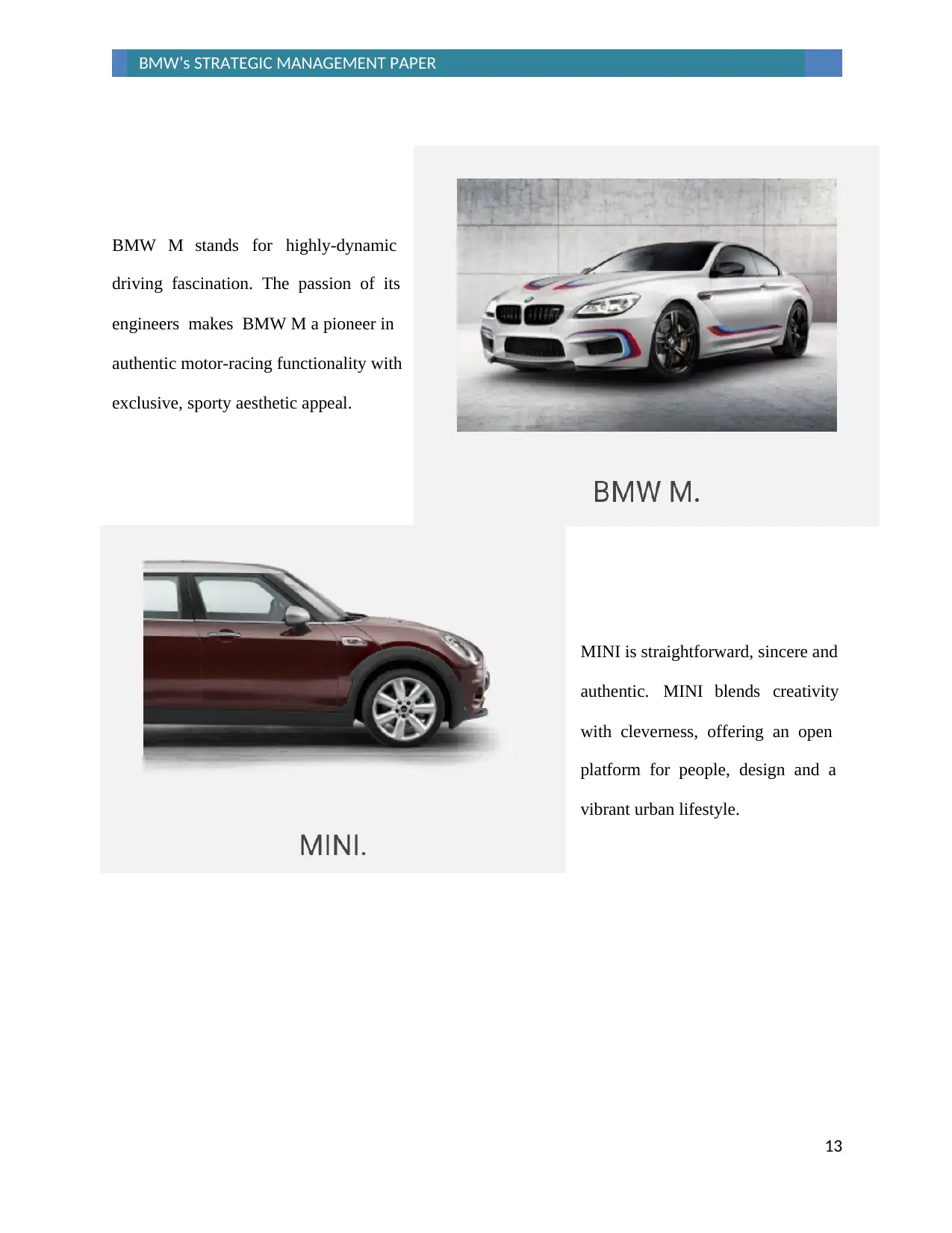
13
BMW’s STRATEGIC MANAGEMENT PAPER
BMW M stands for highly-dynamic
driving fascination. The passion of its
engineers makes BMW M a pioneer in
authentic motor-racing functionality with
exclusive, sporty aesthetic appeal.
MINI is straightforward, sincere and
authentic. MINI blends creativity
with cleverness, offering an open
platform for people, design and a
vibrant urban lifestyle.
BMW’s STRATEGIC MANAGEMENT PAPER
BMW M stands for highly-dynamic
driving fascination. The passion of its
engineers makes BMW M a pioneer in
authentic motor-racing functionality with
exclusive, sporty aesthetic appeal.
MINI is straightforward, sincere and
authentic. MINI blends creativity
with cleverness, offering an open
platform for people, design and a
vibrant urban lifestyle.
Paraphrase This Document
Need a fresh take? Get an instant paraphrase of this document with our AI Paraphraser
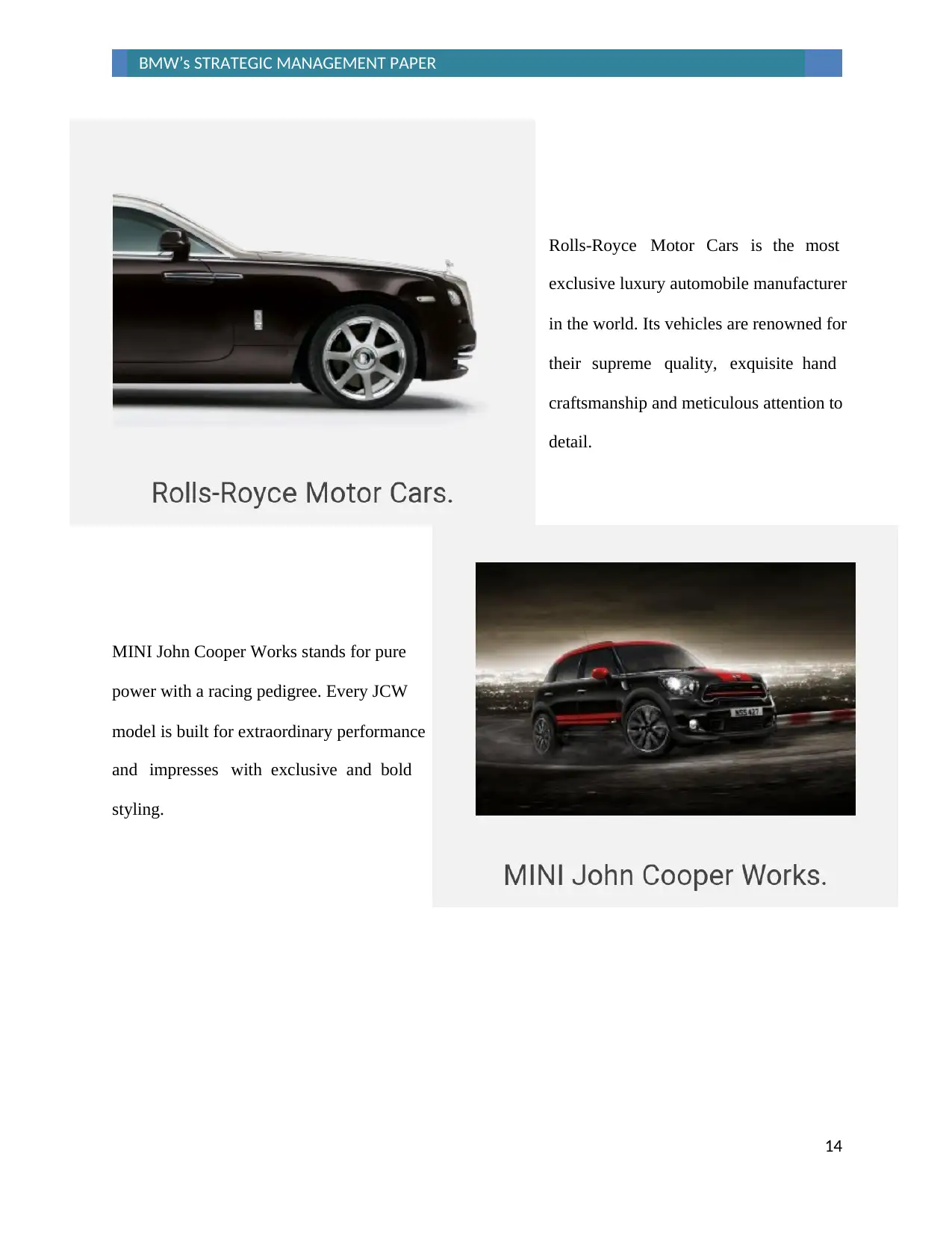
14
BMW’s STRATEGIC MANAGEMENT PAPER
Rolls-Royce Motor Cars is the most
exclusive luxury automobile manufacturer
in the world. Its vehicles are renowned for
their supreme quality, exquisite hand
craftsmanship and meticulous attention to
detail.
MINI John Cooper Works stands for pure
power with a racing pedigree. Every JCW
model is built for extraordinary performance
and impresses with exclusive and bold
styling.
BMW’s STRATEGIC MANAGEMENT PAPER
Rolls-Royce Motor Cars is the most
exclusive luxury automobile manufacturer
in the world. Its vehicles are renowned for
their supreme quality, exquisite hand
craftsmanship and meticulous attention to
detail.
MINI John Cooper Works stands for pure
power with a racing pedigree. Every JCW
model is built for extraordinary performance
and impresses with exclusive and bold
styling.
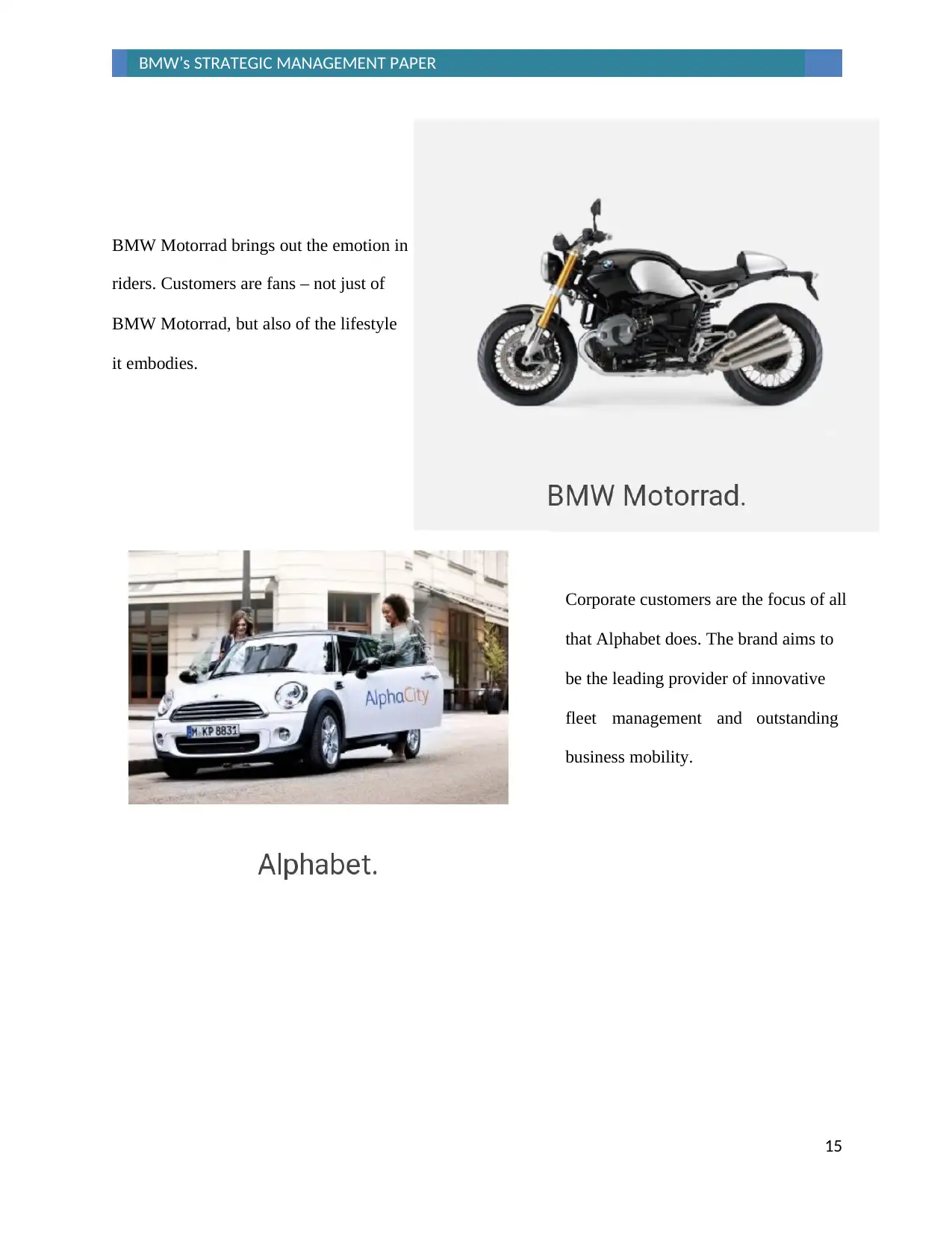
15
BMW’s STRATEGIC MANAGEMENT PAPER
BMW Motorrad brings out the emotion in
riders. Customers are fans – not just of
BMW Motorrad, but also of the lifestyle
it embodies.
Corporate customers are the focus of all
that Alphabet does. The brand aims to
be the leading provider of innovative
fleet management and outstanding
business mobility.
BMW’s STRATEGIC MANAGEMENT PAPER
BMW Motorrad brings out the emotion in
riders. Customers are fans – not just of
BMW Motorrad, but also of the lifestyle
it embodies.
Corporate customers are the focus of all
that Alphabet does. The brand aims to
be the leading provider of innovative
fleet management and outstanding
business mobility.
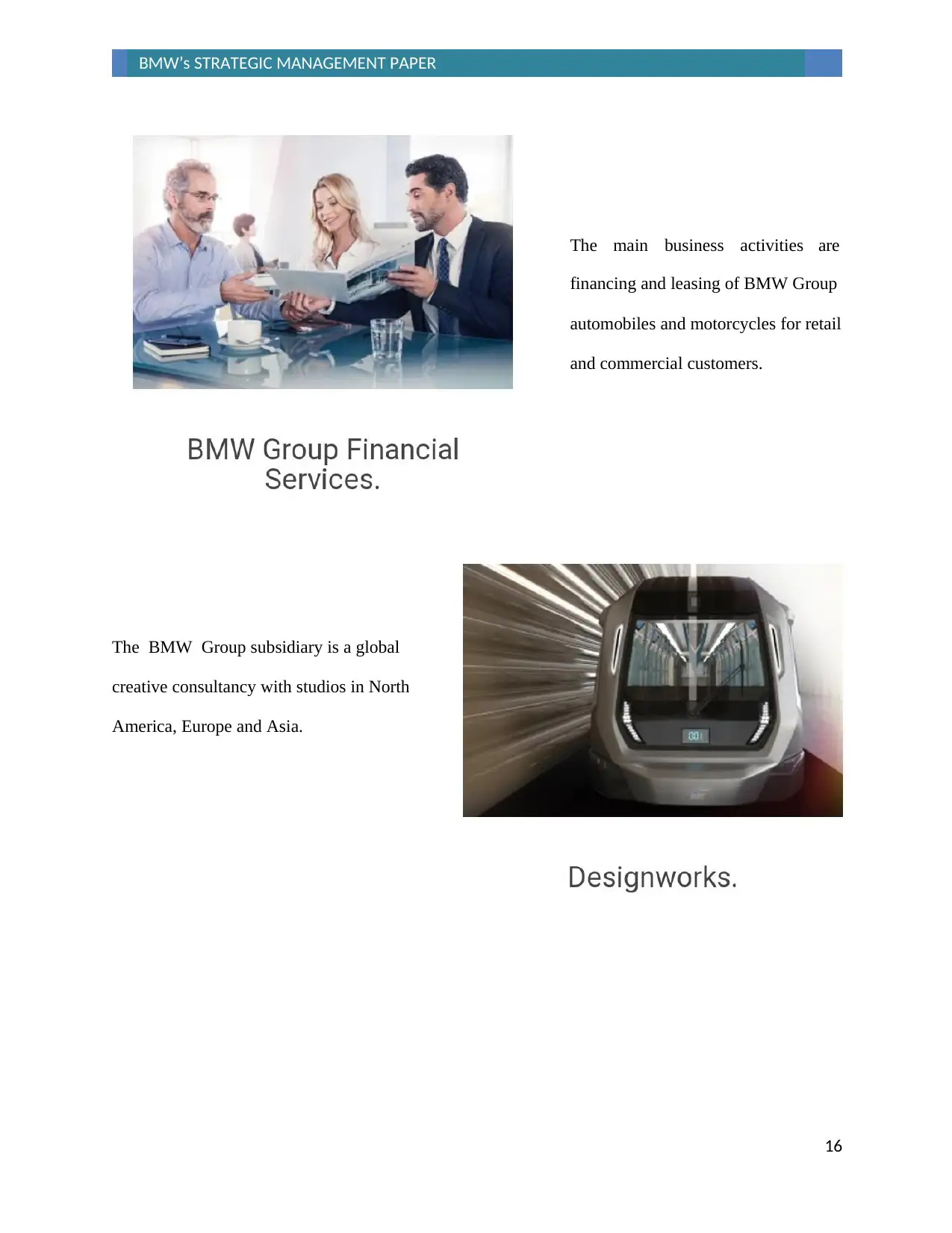
16
BMW’s STRATEGIC MANAGEMENT PAPER
The main business activities are
financing and leasing of BMW Group
automobiles and motorcycles for retail
and commercial customers.
The BMW Group subsidiary is a global
creative consultancy with studios in North
America, Europe and Asia.
BMW’s STRATEGIC MANAGEMENT PAPER
The main business activities are
financing and leasing of BMW Group
automobiles and motorcycles for retail
and commercial customers.
The BMW Group subsidiary is a global
creative consultancy with studios in North
America, Europe and Asia.
Secure Best Marks with AI Grader
Need help grading? Try our AI Grader for instant feedback on your assignments.
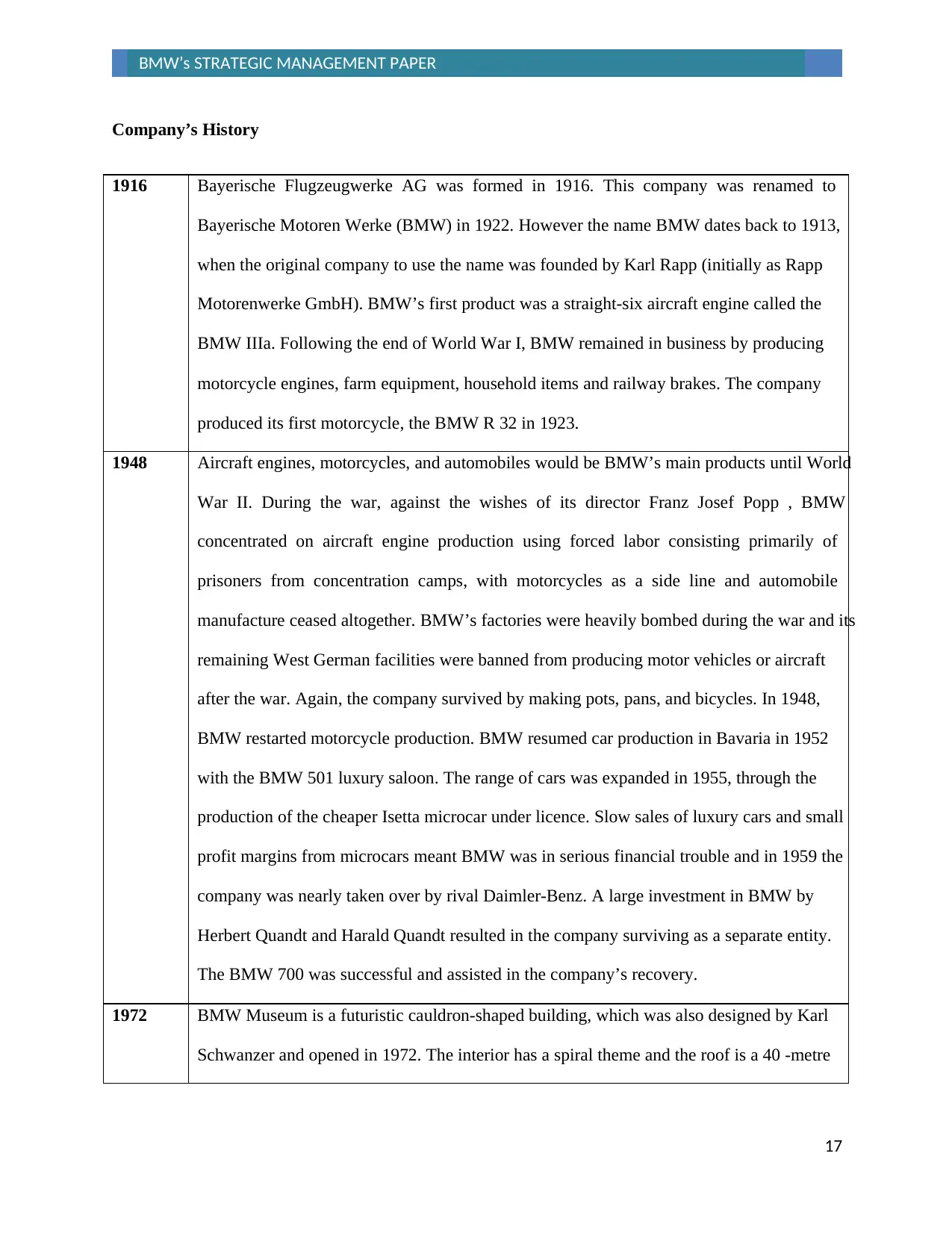
17
BMW’s STRATEGIC MANAGEMENT PAPER
Company’s History
1916 Bayerische Flugzeugwerke AG was formed in 1916. This company was renamed to
Bayerische Motoren Werke (BMW) in 1922. However the name BMW dates back to 1913,
when the original company to use the name was founded by Karl Rapp (initially as Rapp
Motorenwerke GmbH). BMW’s first product was a straight-six aircraft engine called the
BMW IIIa. Following the end of World War I, BMW remained in business by producing
motorcycle engines, farm equipment, household items and railway brakes. The company
produced its first motorcycle, the BMW R 32 in 1923.
1948 Aircraft engines, motorcycles, and automobiles would be BMW’s main products until World
War II. During the war, against the wishes of its director Franz Josef Popp , BMW
concentrated on aircraft engine production using forced labor consisting primarily of
prisoners from concentration camps, with motorcycles as a side line and automobile
manufacture ceased altogether. BMW’s factories were heavily bombed during the war and its
remaining West German facilities were banned from producing motor vehicles or aircraft
after the war. Again, the company survived by making pots, pans, and bicycles. In 1948,
BMW restarted motorcycle production. BMW resumed car production in Bavaria in 1952
with the BMW 501 luxury saloon. The range of cars was expanded in 1955, through the
production of the cheaper Isetta microcar under licence. Slow sales of luxury cars and small
profit margins from microcars meant BMW was in serious financial trouble and in 1959 the
company was nearly taken over by rival Daimler-Benz. A large investment in BMW by
Herbert Quandt and Harald Quandt resulted in the company surviving as a separate entity.
The BMW 700 was successful and assisted in the company’s recovery.
1972 BMW Museum is a futuristic cauldron-shaped building, which was also designed by Karl
Schwanzer and opened in 1972. The interior has a spiral theme and the roof is a 40 -metre
BMW’s STRATEGIC MANAGEMENT PAPER
Company’s History
1916 Bayerische Flugzeugwerke AG was formed in 1916. This company was renamed to
Bayerische Motoren Werke (BMW) in 1922. However the name BMW dates back to 1913,
when the original company to use the name was founded by Karl Rapp (initially as Rapp
Motorenwerke GmbH). BMW’s first product was a straight-six aircraft engine called the
BMW IIIa. Following the end of World War I, BMW remained in business by producing
motorcycle engines, farm equipment, household items and railway brakes. The company
produced its first motorcycle, the BMW R 32 in 1923.
1948 Aircraft engines, motorcycles, and automobiles would be BMW’s main products until World
War II. During the war, against the wishes of its director Franz Josef Popp , BMW
concentrated on aircraft engine production using forced labor consisting primarily of
prisoners from concentration camps, with motorcycles as a side line and automobile
manufacture ceased altogether. BMW’s factories were heavily bombed during the war and its
remaining West German facilities were banned from producing motor vehicles or aircraft
after the war. Again, the company survived by making pots, pans, and bicycles. In 1948,
BMW restarted motorcycle production. BMW resumed car production in Bavaria in 1952
with the BMW 501 luxury saloon. The range of cars was expanded in 1955, through the
production of the cheaper Isetta microcar under licence. Slow sales of luxury cars and small
profit margins from microcars meant BMW was in serious financial trouble and in 1959 the
company was nearly taken over by rival Daimler-Benz. A large investment in BMW by
Herbert Quandt and Harald Quandt resulted in the company surviving as a separate entity.
The BMW 700 was successful and assisted in the company’s recovery.
1972 BMW Museum is a futuristic cauldron-shaped building, which was also designed by Karl
Schwanzer and opened in 1972. The interior has a spiral theme and the roof is a 40 -metre
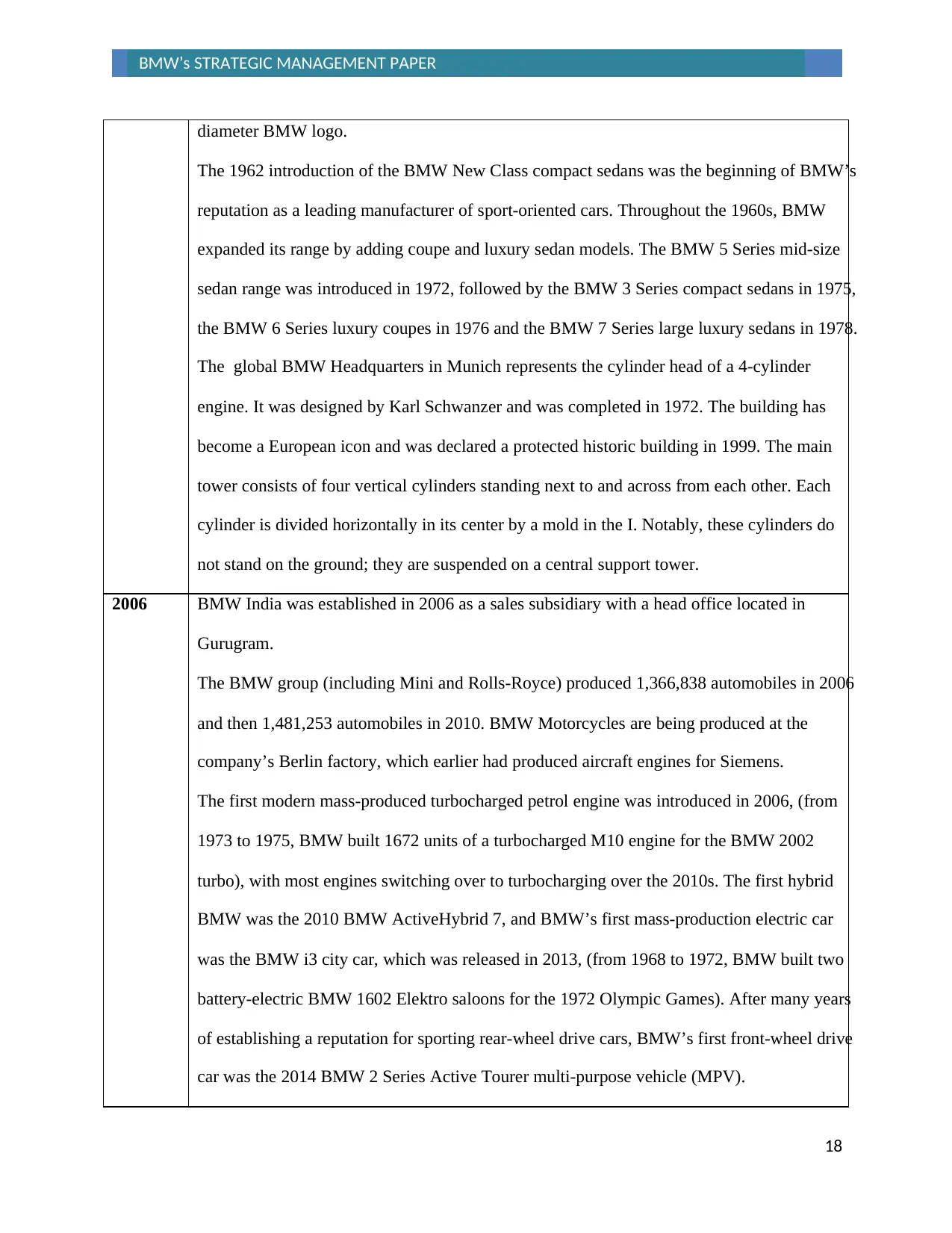
18
BMW’s STRATEGIC MANAGEMENT PAPER
diameter BMW logo.
The 1962 introduction of the BMW New Class compact sedans was the beginning of BMW’s
reputation as a leading manufacturer of sport-oriented cars. Throughout the 1960s, BMW
expanded its range by adding coupe and luxury sedan models. The BMW 5 Series mid-size
sedan range was introduced in 1972, followed by the BMW 3 Series compact sedans in 1975,
the BMW 6 Series luxury coupes in 1976 and the BMW 7 Series large luxury sedans in 1978.
The global BMW Headquarters in Munich represents the cylinder head of a 4-cylinder
engine. It was designed by Karl Schwanzer and was completed in 1972. The building has
become a European icon and was declared a protected historic building in 1999. The main
tower consists of four vertical cylinders standing next to and across from each other. Each
cylinder is divided horizontally in its center by a mold in the I. Notably, these cylinders do
not stand on the ground; they are suspended on a central support tower.
2006 BMW India was established in 2006 as a sales subsidiary with a head office located in
Gurugram.
The BMW group (including Mini and Rolls-Royce) produced 1,366,838 automobiles in 2006
and then 1,481,253 automobiles in 2010. BMW Motorcycles are being produced at the
company’s Berlin factory, which earlier had produced aircraft engines for Siemens.
The first modern mass-produced turbocharged petrol engine was introduced in 2006, (from
1973 to 1975, BMW built 1672 units of a turbocharged M10 engine for the BMW 2002
turbo), with most engines switching over to turbocharging over the 2010s. The first hybrid
BMW was the 2010 BMW ActiveHybrid 7, and BMW’s first mass-production electric car
was the BMW i3 city car, which was released in 2013, (from 1968 to 1972, BMW built two
battery-electric BMW 1602 Elektro saloons for the 1972 Olympic Games). After many years
of establishing a reputation for sporting rear-wheel drive cars, BMW’s first front-wheel drive
car was the 2014 BMW 2 Series Active Tourer multi-purpose vehicle (MPV).
BMW’s STRATEGIC MANAGEMENT PAPER
diameter BMW logo.
The 1962 introduction of the BMW New Class compact sedans was the beginning of BMW’s
reputation as a leading manufacturer of sport-oriented cars. Throughout the 1960s, BMW
expanded its range by adding coupe and luxury sedan models. The BMW 5 Series mid-size
sedan range was introduced in 1972, followed by the BMW 3 Series compact sedans in 1975,
the BMW 6 Series luxury coupes in 1976 and the BMW 7 Series large luxury sedans in 1978.
The global BMW Headquarters in Munich represents the cylinder head of a 4-cylinder
engine. It was designed by Karl Schwanzer and was completed in 1972. The building has
become a European icon and was declared a protected historic building in 1999. The main
tower consists of four vertical cylinders standing next to and across from each other. Each
cylinder is divided horizontally in its center by a mold in the I. Notably, these cylinders do
not stand on the ground; they are suspended on a central support tower.
2006 BMW India was established in 2006 as a sales subsidiary with a head office located in
Gurugram.
The BMW group (including Mini and Rolls-Royce) produced 1,366,838 automobiles in 2006
and then 1,481,253 automobiles in 2010. BMW Motorcycles are being produced at the
company’s Berlin factory, which earlier had produced aircraft engines for Siemens.
The first modern mass-produced turbocharged petrol engine was introduced in 2006, (from
1973 to 1975, BMW built 1672 units of a turbocharged M10 engine for the BMW 2002
turbo), with most engines switching over to turbocharging over the 2010s. The first hybrid
BMW was the 2010 BMW ActiveHybrid 7, and BMW’s first mass-production electric car
was the BMW i3 city car, which was released in 2013, (from 1968 to 1972, BMW built two
battery-electric BMW 1602 Elektro saloons for the 1972 Olympic Games). After many years
of establishing a reputation for sporting rear-wheel drive cars, BMW’s first front-wheel drive
car was the 2014 BMW 2 Series Active Tourer multi-purpose vehicle (MPV).
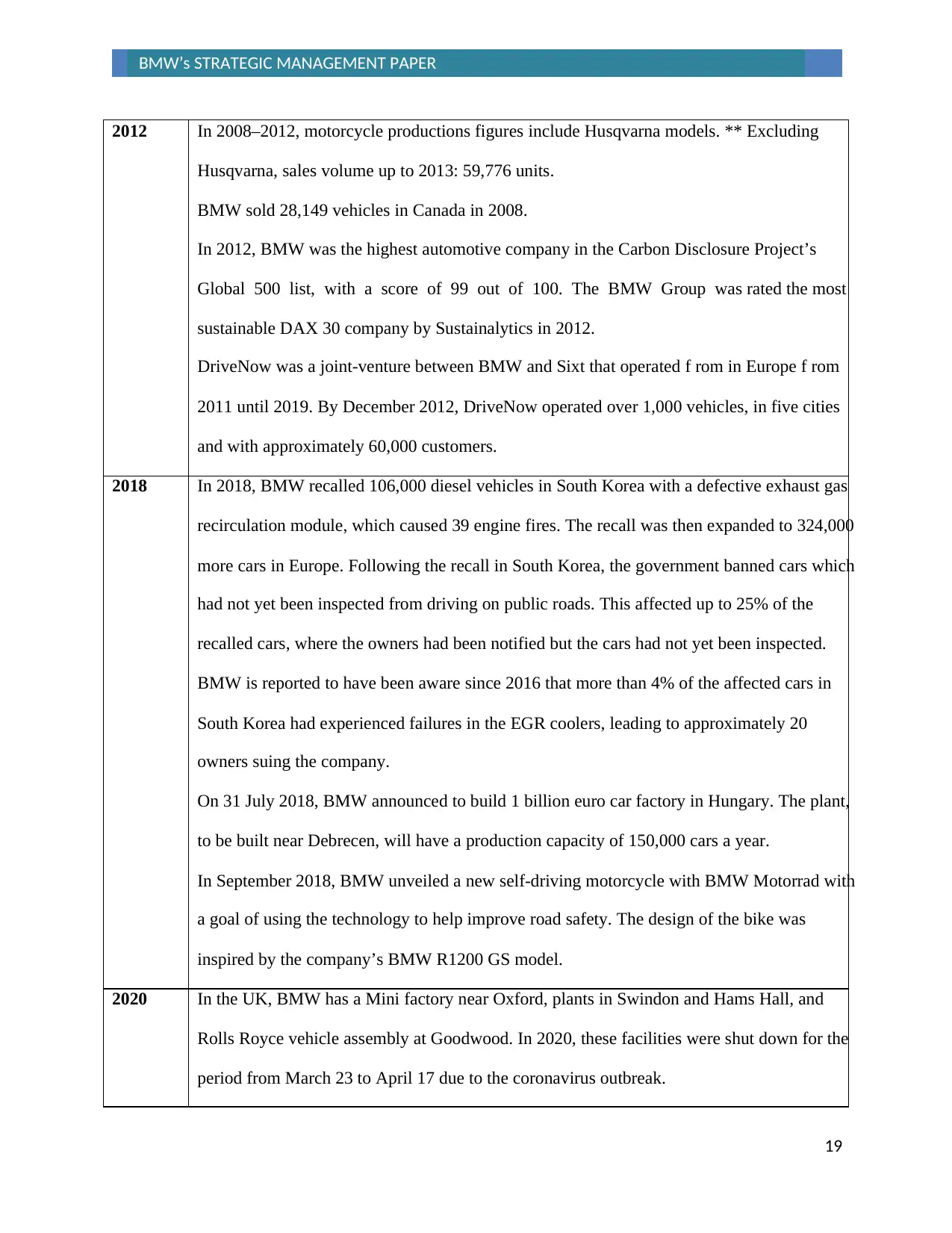
19
BMW’s STRATEGIC MANAGEMENT PAPER
2012 In 2008–2012, motorcycle productions figures include Husqvarna models. ** Excluding
Husqvarna, sales volume up to 2013: 59,776 units.
BMW sold 28,149 vehicles in Canada in 2008.
In 2012, BMW was the highest automotive company in the Carbon Disclosure Project’s
Global 500 list, with a score of 99 out of 100. The BMW Group was rated the most
sustainable DAX 30 company by Sustainalytics in 2012.
DriveNow was a joint-venture between BMW and Sixt that operated f rom in Europe f rom
2011 until 2019. By December 2012, DriveNow operated over 1,000 vehicles, in five cities
and with approximately 60,000 customers.
2018 In 2018, BMW recalled 106,000 diesel vehicles in South Korea with a defective exhaust gas
recirculation module, which caused 39 engine fires. The recall was then expanded to 324,000
more cars in Europe. Following the recall in South Korea, the government banned cars which
had not yet been inspected from driving on public roads. This affected up to 25% of the
recalled cars, where the owners had been notified but the cars had not yet been inspected.
BMW is reported to have been aware since 2016 that more than 4% of the affected cars in
South Korea had experienced failures in the EGR coolers, leading to approximately 20
owners suing the company.
On 31 July 2018, BMW announced to build 1 billion euro car factory in Hungary. The plant,
to be built near Debrecen, will have a production capacity of 150,000 cars a year.
In September 2018, BMW unveiled a new self-driving motorcycle with BMW Motorrad with
a goal of using the technology to help improve road safety. The design of the bike was
inspired by the company’s BMW R1200 GS model.
2020 In the UK, BMW has a Mini factory near Oxford, plants in Swindon and Hams Hall, and
Rolls Royce vehicle assembly at Goodwood. In 2020, these facilities were shut down for the
period from March 23 to April 17 due to the coronavirus outbreak.
BMW’s STRATEGIC MANAGEMENT PAPER
2012 In 2008–2012, motorcycle productions figures include Husqvarna models. ** Excluding
Husqvarna, sales volume up to 2013: 59,776 units.
BMW sold 28,149 vehicles in Canada in 2008.
In 2012, BMW was the highest automotive company in the Carbon Disclosure Project’s
Global 500 list, with a score of 99 out of 100. The BMW Group was rated the most
sustainable DAX 30 company by Sustainalytics in 2012.
DriveNow was a joint-venture between BMW and Sixt that operated f rom in Europe f rom
2011 until 2019. By December 2012, DriveNow operated over 1,000 vehicles, in five cities
and with approximately 60,000 customers.
2018 In 2018, BMW recalled 106,000 diesel vehicles in South Korea with a defective exhaust gas
recirculation module, which caused 39 engine fires. The recall was then expanded to 324,000
more cars in Europe. Following the recall in South Korea, the government banned cars which
had not yet been inspected from driving on public roads. This affected up to 25% of the
recalled cars, where the owners had been notified but the cars had not yet been inspected.
BMW is reported to have been aware since 2016 that more than 4% of the affected cars in
South Korea had experienced failures in the EGR coolers, leading to approximately 20
owners suing the company.
On 31 July 2018, BMW announced to build 1 billion euro car factory in Hungary. The plant,
to be built near Debrecen, will have a production capacity of 150,000 cars a year.
In September 2018, BMW unveiled a new self-driving motorcycle with BMW Motorrad with
a goal of using the technology to help improve road safety. The design of the bike was
inspired by the company’s BMW R1200 GS model.
2020 In the UK, BMW has a Mini factory near Oxford, plants in Swindon and Hams Hall, and
Rolls Royce vehicle assembly at Goodwood. In 2020, these facilities were shut down for the
period from March 23 to April 17 due to the coronavirus outbreak.
Paraphrase This Document
Need a fresh take? Get an instant paraphrase of this document with our AI Paraphraser
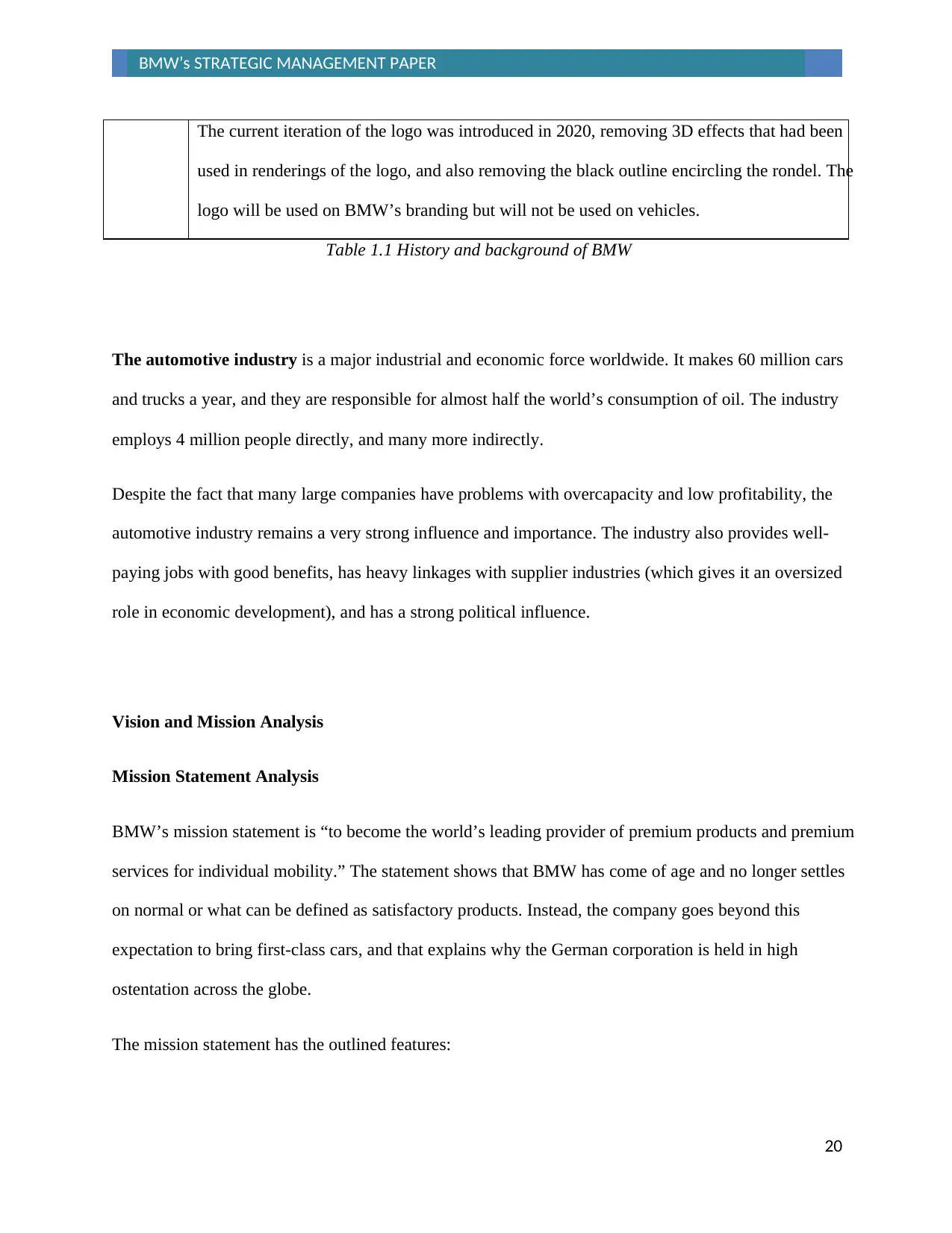
20
BMW’s STRATEGIC MANAGEMENT PAPER
The current iteration of the logo was introduced in 2020, removing 3D effects that had been
used in renderings of the logo, and also removing the black outline encircling the rondel. The
logo will be used on BMW’s branding but will not be used on vehicles.
Table 1.1 History and background of BMW
The automotive industry is a major industrial and economic force worldwide. It makes 60 million cars
and trucks a year, and they are responsible for almost half the world’s consumption of oil. The industry
employs 4 million people directly, and many more indirectly.
Despite the fact that many large companies have problems with overcapacity and low profitability, the
automotive industry remains a very strong influence and importance. The industry also provides well-
paying jobs with good benefits, has heavy linkages with supplier industries (which gives it an oversized
role in economic development), and has a strong political influence.
Vision and Mission Analysis
Mission Statement Analysis
BMW’s mission statement is “to become the world’s leading provider of premium products and premium
services for individual mobility.” The statement shows that BMW has come of age and no longer settles
on normal or what can be defined as satisfactory products. Instead, the company goes beyond this
expectation to bring first-class cars, and that explains why the German corporation is held in high
ostentation across the globe.
The mission statement has the outlined features:
BMW’s STRATEGIC MANAGEMENT PAPER
The current iteration of the logo was introduced in 2020, removing 3D effects that had been
used in renderings of the logo, and also removing the black outline encircling the rondel. The
logo will be used on BMW’s branding but will not be used on vehicles.
Table 1.1 History and background of BMW
The automotive industry is a major industrial and economic force worldwide. It makes 60 million cars
and trucks a year, and they are responsible for almost half the world’s consumption of oil. The industry
employs 4 million people directly, and many more indirectly.
Despite the fact that many large companies have problems with overcapacity and low profitability, the
automotive industry remains a very strong influence and importance. The industry also provides well-
paying jobs with good benefits, has heavy linkages with supplier industries (which gives it an oversized
role in economic development), and has a strong political influence.
Vision and Mission Analysis
Mission Statement Analysis
BMW’s mission statement is “to become the world’s leading provider of premium products and premium
services for individual mobility.” The statement shows that BMW has come of age and no longer settles
on normal or what can be defined as satisfactory products. Instead, the company goes beyond this
expectation to bring first-class cars, and that explains why the German corporation is held in high
ostentation across the globe.
The mission statement has the outlined features:
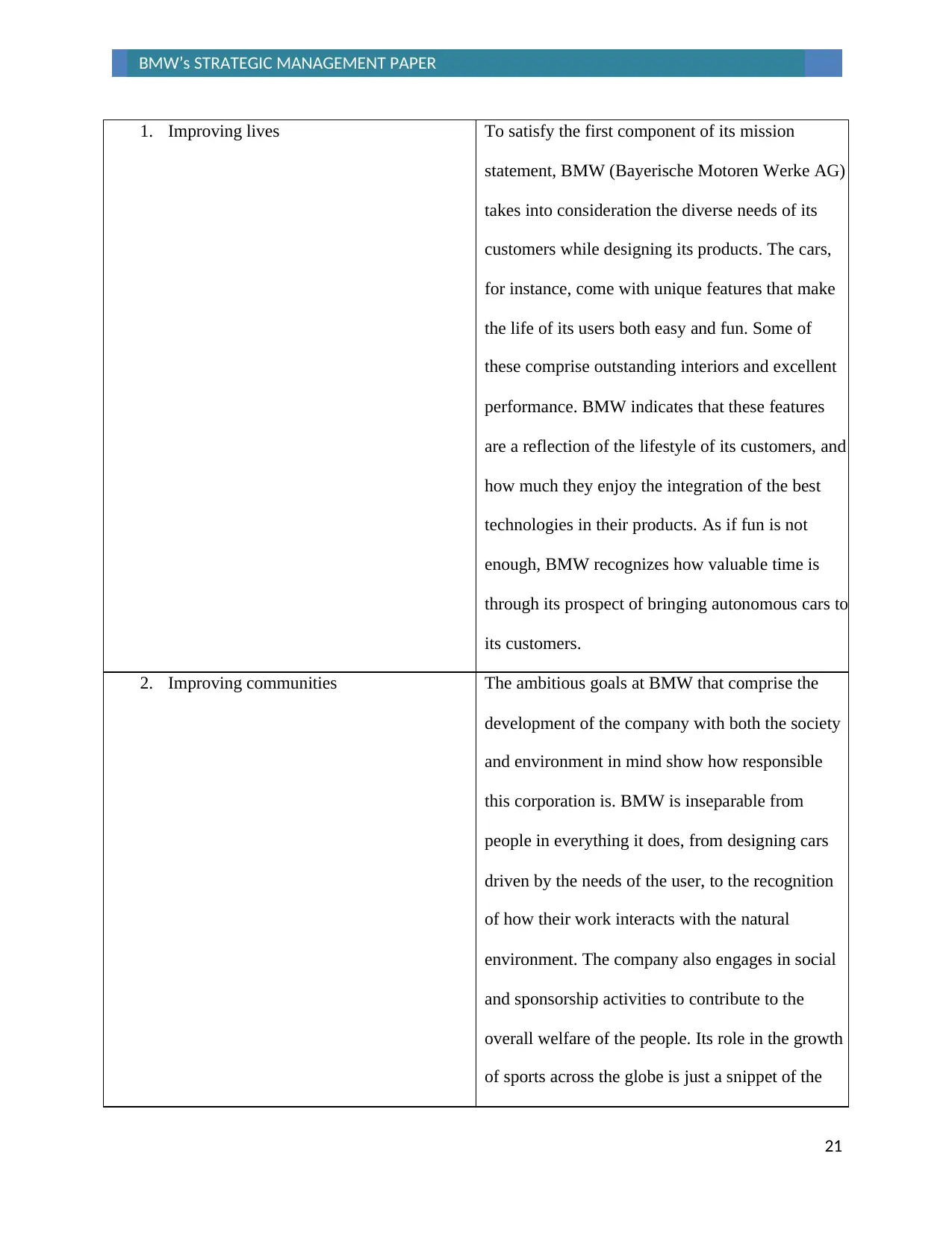
21
BMW’s STRATEGIC MANAGEMENT PAPER
1. Improving lives To satisfy the first component of its mission
statement, BMW (Bayerische Motoren Werke AG)
takes into consideration the diverse needs of its
customers while designing its products. The cars,
for instance, come with unique features that make
the life of its users both easy and fun. Some of
these comprise outstanding interiors and excellent
performance. BMW indicates that these features
are a reflection of the lifestyle of its customers, and
how much they enjoy the integration of the best
technologies in their products. As if fun is not
enough, BMW recognizes how valuable time is
through its prospect of bringing autonomous cars to
its customers.
2. Improving communities The ambitious goals at BMW that comprise the
development of the company with both the society
and environment in mind show how responsible
this corporation is. BMW is inseparable from
people in everything it does, from designing cars
driven by the needs of the user, to the recognition
of how their work interacts with the natural
environment. The company also engages in social
and sponsorship activities to contribute to the
overall welfare of the people. Its role in the growth
of sports across the globe is just a snippet of the
BMW’s STRATEGIC MANAGEMENT PAPER
1. Improving lives To satisfy the first component of its mission
statement, BMW (Bayerische Motoren Werke AG)
takes into consideration the diverse needs of its
customers while designing its products. The cars,
for instance, come with unique features that make
the life of its users both easy and fun. Some of
these comprise outstanding interiors and excellent
performance. BMW indicates that these features
are a reflection of the lifestyle of its customers, and
how much they enjoy the integration of the best
technologies in their products. As if fun is not
enough, BMW recognizes how valuable time is
through its prospect of bringing autonomous cars to
its customers.
2. Improving communities The ambitious goals at BMW that comprise the
development of the company with both the society
and environment in mind show how responsible
this corporation is. BMW is inseparable from
people in everything it does, from designing cars
driven by the needs of the user, to the recognition
of how their work interacts with the natural
environment. The company also engages in social
and sponsorship activities to contribute to the
overall welfare of the people. Its role in the growth
of sports across the globe is just a snippet of the
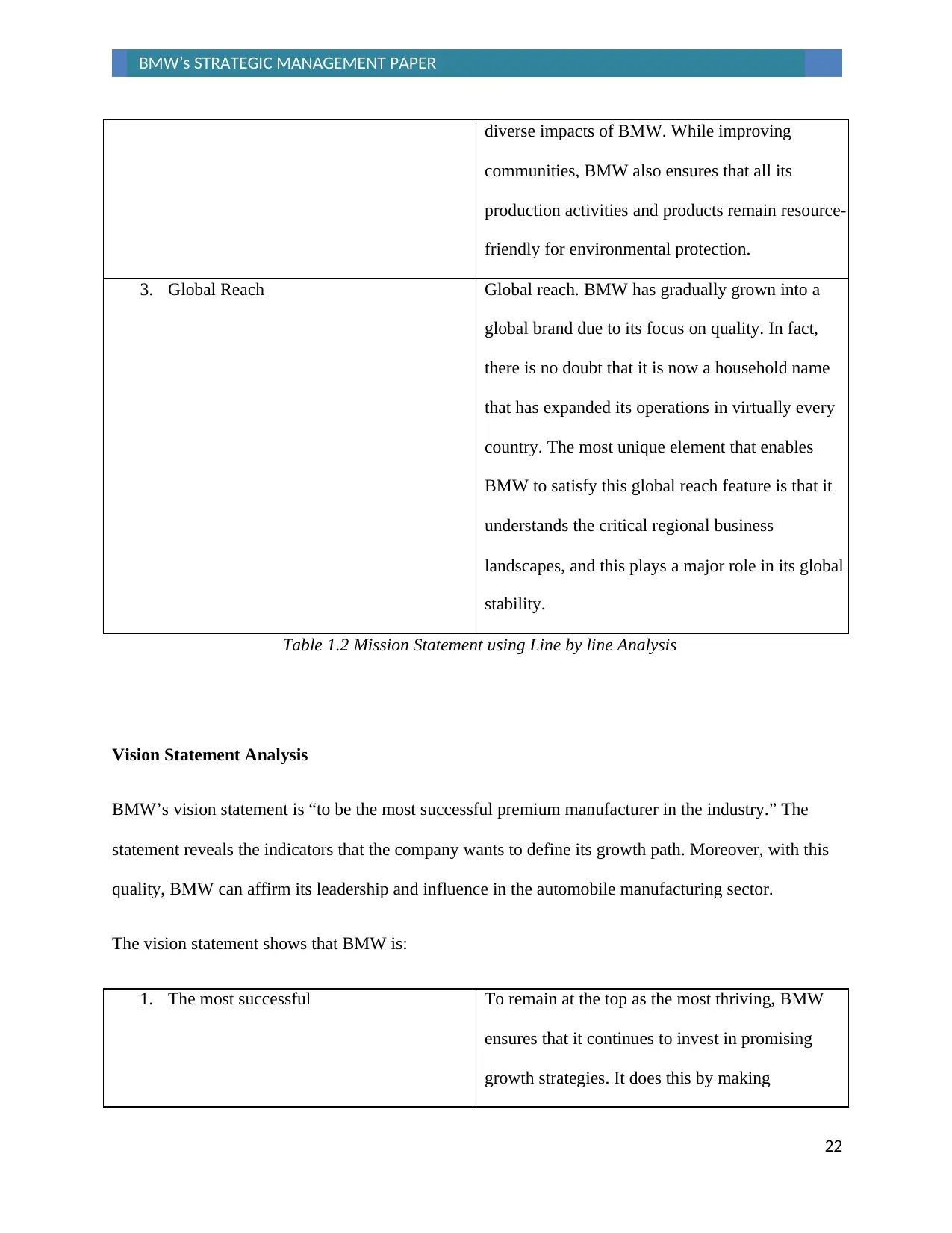
22
BMW’s STRATEGIC MANAGEMENT PAPER
diverse impacts of BMW. While improving
communities, BMW also ensures that all its
production activities and products remain resource-
friendly for environmental protection.
3. Global Reach Global reach. BMW has gradually grown into a
global brand due to its focus on quality. In fact,
there is no doubt that it is now a household name
that has expanded its operations in virtually every
country. The most unique element that enables
BMW to satisfy this global reach feature is that it
understands the critical regional business
landscapes, and this plays a major role in its global
stability.
Table 1.2 Mission Statement using Line by line Analysis
Vision Statement Analysis
BMW’s vision statement is “to be the most successful premium manufacturer in the industry.” The
statement reveals the indicators that the company wants to define its growth path. Moreover, with this
quality, BMW can affirm its leadership and influence in the automobile manufacturing sector.
The vision statement shows that BMW is:
1. The most successful To remain at the top as the most thriving, BMW
ensures that it continues to invest in promising
growth strategies. It does this by making
BMW’s STRATEGIC MANAGEMENT PAPER
diverse impacts of BMW. While improving
communities, BMW also ensures that all its
production activities and products remain resource-
friendly for environmental protection.
3. Global Reach Global reach. BMW has gradually grown into a
global brand due to its focus on quality. In fact,
there is no doubt that it is now a household name
that has expanded its operations in virtually every
country. The most unique element that enables
BMW to satisfy this global reach feature is that it
understands the critical regional business
landscapes, and this plays a major role in its global
stability.
Table 1.2 Mission Statement using Line by line Analysis
Vision Statement Analysis
BMW’s vision statement is “to be the most successful premium manufacturer in the industry.” The
statement reveals the indicators that the company wants to define its growth path. Moreover, with this
quality, BMW can affirm its leadership and influence in the automobile manufacturing sector.
The vision statement shows that BMW is:
1. The most successful To remain at the top as the most thriving, BMW
ensures that it continues to invest in promising
growth strategies. It does this by making
Secure Best Marks with AI Grader
Need help grading? Try our AI Grader for instant feedback on your assignments.
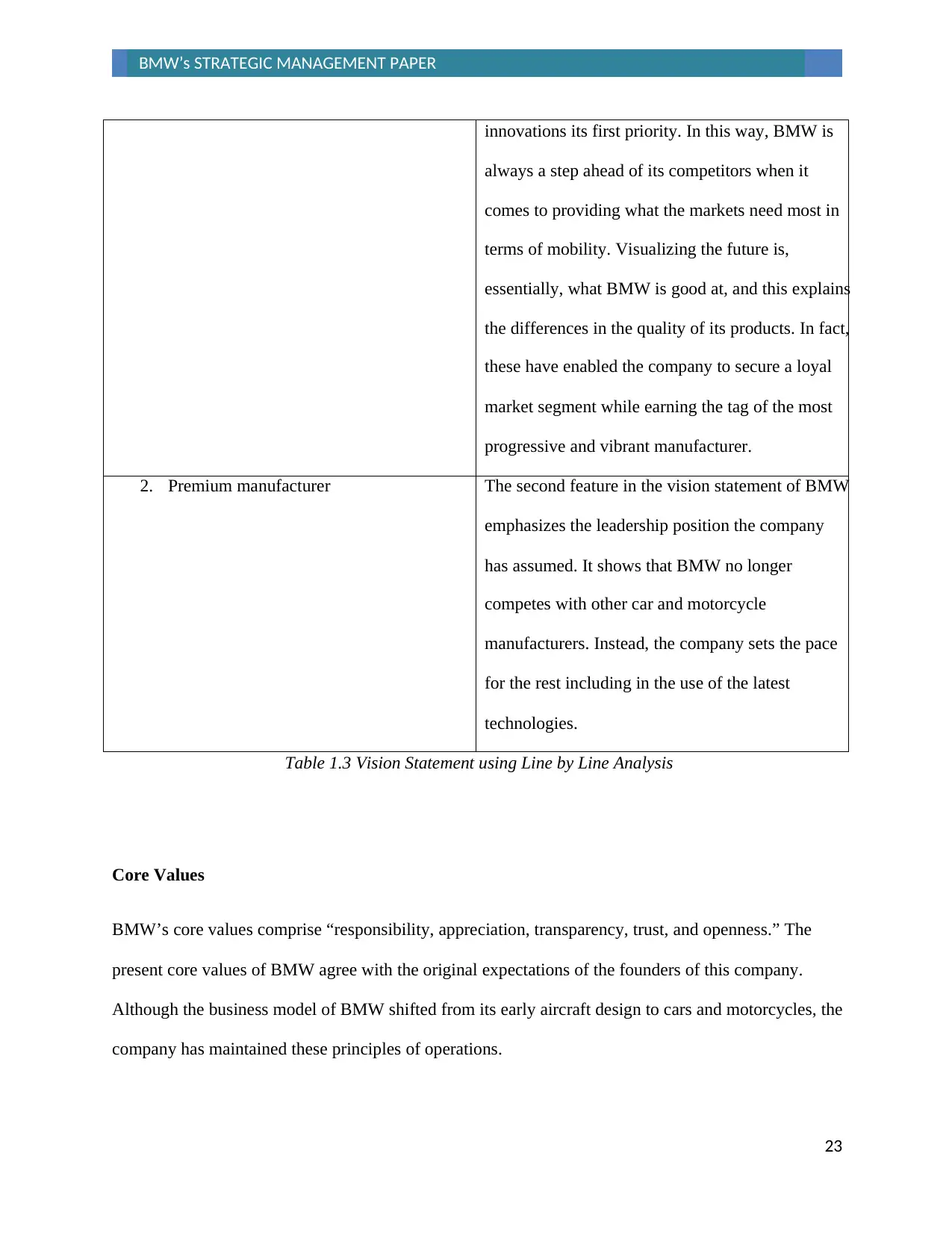
23
BMW’s STRATEGIC MANAGEMENT PAPER
innovations its first priority. In this way, BMW is
always a step ahead of its competitors when it
comes to providing what the markets need most in
terms of mobility. Visualizing the future is,
essentially, what BMW is good at, and this explains
the differences in the quality of its products. In fact,
these have enabled the company to secure a loyal
market segment while earning the tag of the most
progressive and vibrant manufacturer.
2. Premium manufacturer The second feature in the vision statement of BMW
emphasizes the leadership position the company
has assumed. It shows that BMW no longer
competes with other car and motorcycle
manufacturers. Instead, the company sets the pace
for the rest including in the use of the latest
technologies.
Table 1.3 Vision Statement using Line by Line Analysis
Core Values
BMW’s core values comprise “responsibility, appreciation, transparency, trust, and openness.” The
present core values of BMW agree with the original expectations of the founders of this company.
Although the business model of BMW shifted from its early aircraft design to cars and motorcycles, the
company has maintained these principles of operations.
BMW’s STRATEGIC MANAGEMENT PAPER
innovations its first priority. In this way, BMW is
always a step ahead of its competitors when it
comes to providing what the markets need most in
terms of mobility. Visualizing the future is,
essentially, what BMW is good at, and this explains
the differences in the quality of its products. In fact,
these have enabled the company to secure a loyal
market segment while earning the tag of the most
progressive and vibrant manufacturer.
2. Premium manufacturer The second feature in the vision statement of BMW
emphasizes the leadership position the company
has assumed. It shows that BMW no longer
competes with other car and motorcycle
manufacturers. Instead, the company sets the pace
for the rest including in the use of the latest
technologies.
Table 1.3 Vision Statement using Line by Line Analysis
Core Values
BMW’s core values comprise “responsibility, appreciation, transparency, trust, and openness.” The
present core values of BMW agree with the original expectations of the founders of this company.
Although the business model of BMW shifted from its early aircraft design to cars and motorcycles, the
company has maintained these principles of operations.
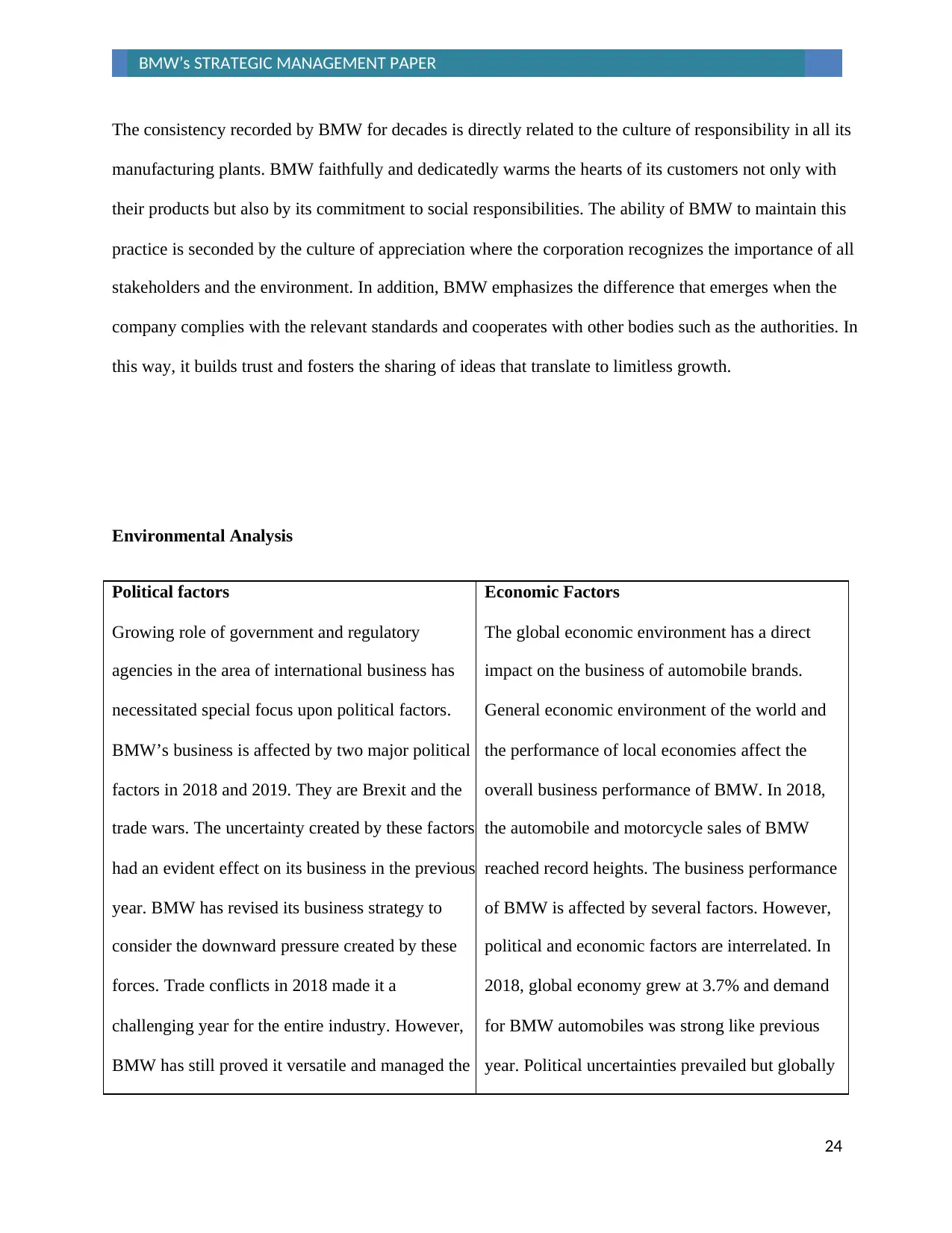
24
BMW’s STRATEGIC MANAGEMENT PAPER
The consistency recorded by BMW for decades is directly related to the culture of responsibility in all its
manufacturing plants. BMW faithfully and dedicatedly warms the hearts of its customers not only with
their products but also by its commitment to social responsibilities. The ability of BMW to maintain this
practice is seconded by the culture of appreciation where the corporation recognizes the importance of all
stakeholders and the environment. In addition, BMW emphasizes the difference that emerges when the
company complies with the relevant standards and cooperates with other bodies such as the authorities. In
this way, it builds trust and fosters the sharing of ideas that translate to limitless growth.
Environmental Analysis
Political factors
Growing role of government and regulatory
agencies in the area of international business has
necessitated special focus upon political factors.
BMW’s business is affected by two major political
factors in 2018 and 2019. They are Brexit and the
trade wars. The uncertainty created by these factors
had an evident effect on its business in the previous
year. BMW has revised its business strategy to
consider the downward pressure created by these
forces. Trade conflicts in 2018 made it a
challenging year for the entire industry. However,
BMW has still proved it versatile and managed the
Economic Factors
The global economic environment has a direct
impact on the business of automobile brands.
General economic environment of the world and
the performance of local economies affect the
overall business performance of BMW. In 2018,
the automobile and motorcycle sales of BMW
reached record heights. The business performance
of BMW is affected by several factors. However,
political and economic factors are interrelated. In
2018, global economy grew at 3.7% and demand
for BMW automobiles was strong like previous
year. Political uncertainties prevailed but globally
BMW’s STRATEGIC MANAGEMENT PAPER
The consistency recorded by BMW for decades is directly related to the culture of responsibility in all its
manufacturing plants. BMW faithfully and dedicatedly warms the hearts of its customers not only with
their products but also by its commitment to social responsibilities. The ability of BMW to maintain this
practice is seconded by the culture of appreciation where the corporation recognizes the importance of all
stakeholders and the environment. In addition, BMW emphasizes the difference that emerges when the
company complies with the relevant standards and cooperates with other bodies such as the authorities. In
this way, it builds trust and fosters the sharing of ideas that translate to limitless growth.
Environmental Analysis
Political factors
Growing role of government and regulatory
agencies in the area of international business has
necessitated special focus upon political factors.
BMW’s business is affected by two major political
factors in 2018 and 2019. They are Brexit and the
trade wars. The uncertainty created by these factors
had an evident effect on its business in the previous
year. BMW has revised its business strategy to
consider the downward pressure created by these
forces. Trade conflicts in 2018 made it a
challenging year for the entire industry. However,
BMW has still proved it versatile and managed the
Economic Factors
The global economic environment has a direct
impact on the business of automobile brands.
General economic environment of the world and
the performance of local economies affect the
overall business performance of BMW. In 2018,
the automobile and motorcycle sales of BMW
reached record heights. The business performance
of BMW is affected by several factors. However,
political and economic factors are interrelated. In
2018, global economy grew at 3.7% and demand
for BMW automobiles was strong like previous
year. Political uncertainties prevailed but globally
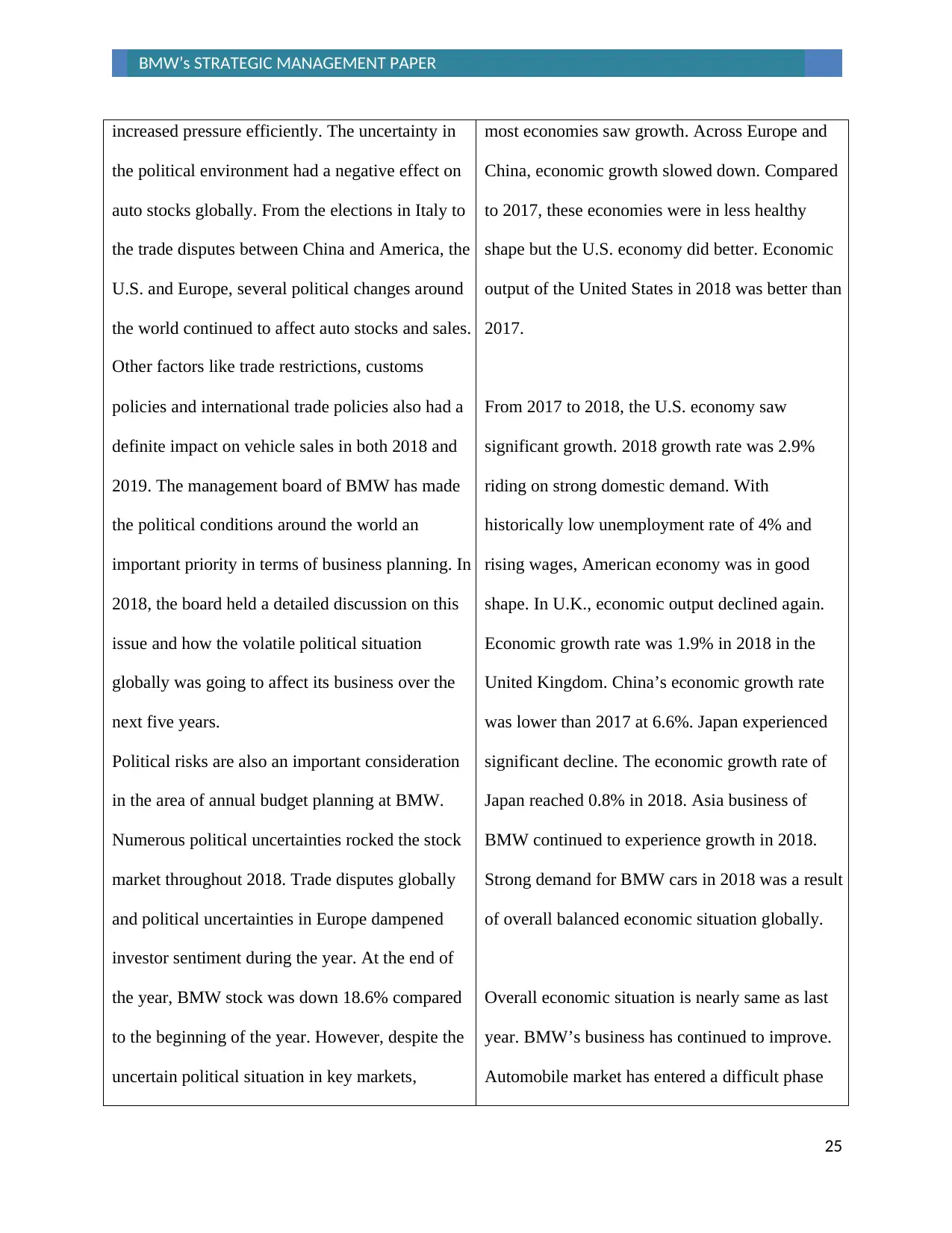
25
BMW’s STRATEGIC MANAGEMENT PAPER
increased pressure efficiently. The uncertainty in
the political environment had a negative effect on
auto stocks globally. From the elections in Italy to
the trade disputes between China and America, the
U.S. and Europe, several political changes around
the world continued to affect auto stocks and sales.
Other factors like trade restrictions, customs
policies and international trade policies also had a
definite impact on vehicle sales in both 2018 and
2019. The management board of BMW has made
the political conditions around the world an
important priority in terms of business planning. In
2018, the board held a detailed discussion on this
issue and how the volatile political situation
globally was going to affect its business over the
next five years.
Political risks are also an important consideration
in the area of annual budget planning at BMW.
Numerous political uncertainties rocked the stock
market throughout 2018. Trade disputes globally
and political uncertainties in Europe dampened
investor sentiment during the year. At the end of
the year, BMW stock was down 18.6% compared
to the beginning of the year. However, despite the
uncertain political situation in key markets,
most economies saw growth. Across Europe and
China, economic growth slowed down. Compared
to 2017, these economies were in less healthy
shape but the U.S. economy did better. Economic
output of the United States in 2018 was better than
2017.
From 2017 to 2018, the U.S. economy saw
significant growth. 2018 growth rate was 2.9%
riding on strong domestic demand. With
historically low unemployment rate of 4% and
rising wages, American economy was in good
shape. In U.K., economic output declined again.
Economic growth rate was 1.9% in 2018 in the
United Kingdom. China’s economic growth rate
was lower than 2017 at 6.6%. Japan experienced
significant decline. The economic growth rate of
Japan reached 0.8% in 2018. Asia business of
BMW continued to experience growth in 2018.
Strong demand for BMW cars in 2018 was a result
of overall balanced economic situation globally.
Overall economic situation is nearly same as last
year. BMW’s business has continued to improve.
Automobile market has entered a difficult phase
BMW’s STRATEGIC MANAGEMENT PAPER
increased pressure efficiently. The uncertainty in
the political environment had a negative effect on
auto stocks globally. From the elections in Italy to
the trade disputes between China and America, the
U.S. and Europe, several political changes around
the world continued to affect auto stocks and sales.
Other factors like trade restrictions, customs
policies and international trade policies also had a
definite impact on vehicle sales in both 2018 and
2019. The management board of BMW has made
the political conditions around the world an
important priority in terms of business planning. In
2018, the board held a detailed discussion on this
issue and how the volatile political situation
globally was going to affect its business over the
next five years.
Political risks are also an important consideration
in the area of annual budget planning at BMW.
Numerous political uncertainties rocked the stock
market throughout 2018. Trade disputes globally
and political uncertainties in Europe dampened
investor sentiment during the year. At the end of
the year, BMW stock was down 18.6% compared
to the beginning of the year. However, despite the
uncertain political situation in key markets,
most economies saw growth. Across Europe and
China, economic growth slowed down. Compared
to 2017, these economies were in less healthy
shape but the U.S. economy did better. Economic
output of the United States in 2018 was better than
2017.
From 2017 to 2018, the U.S. economy saw
significant growth. 2018 growth rate was 2.9%
riding on strong domestic demand. With
historically low unemployment rate of 4% and
rising wages, American economy was in good
shape. In U.K., economic output declined again.
Economic growth rate was 1.9% in 2018 in the
United Kingdom. China’s economic growth rate
was lower than 2017 at 6.6%. Japan experienced
significant decline. The economic growth rate of
Japan reached 0.8% in 2018. Asia business of
BMW continued to experience growth in 2018.
Strong demand for BMW cars in 2018 was a result
of overall balanced economic situation globally.
Overall economic situation is nearly same as last
year. BMW’s business has continued to improve.
Automobile market has entered a difficult phase
Paraphrase This Document
Need a fresh take? Get an instant paraphrase of this document with our AI Paraphraser
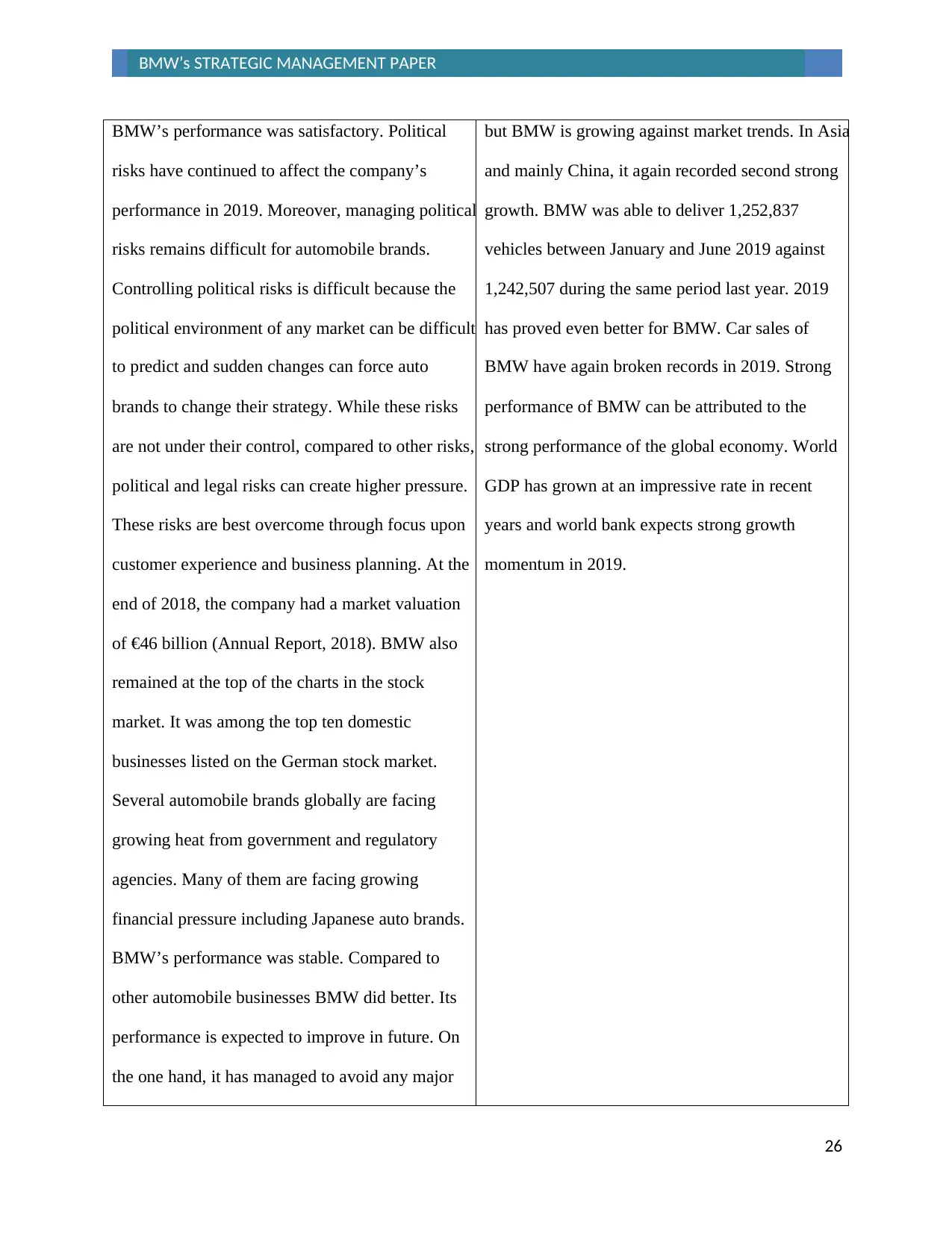
26
BMW’s STRATEGIC MANAGEMENT PAPER
BMW’s performance was satisfactory. Political
risks have continued to affect the company’s
performance in 2019. Moreover, managing political
risks remains difficult for automobile brands.
Controlling political risks is difficult because the
political environment of any market can be difficult
to predict and sudden changes can force auto
brands to change their strategy. While these risks
are not under their control, compared to other risks,
political and legal risks can create higher pressure.
These risks are best overcome through focus upon
customer experience and business planning. At the
end of 2018, the company had a market valuation
of €46 billion (Annual Report, 2018). BMW also
remained at the top of the charts in the stock
market. It was among the top ten domestic
businesses listed on the German stock market.
Several automobile brands globally are facing
growing heat from government and regulatory
agencies. Many of them are facing growing
financial pressure including Japanese auto brands.
BMW’s performance was stable. Compared to
other automobile businesses BMW did better. Its
performance is expected to improve in future. On
the one hand, it has managed to avoid any major
but BMW is growing against market trends. In Asia
and mainly China, it again recorded second strong
growth. BMW was able to deliver 1,252,837
vehicles between January and June 2019 against
1,242,507 during the same period last year. 2019
has proved even better for BMW. Car sales of
BMW have again broken records in 2019. Strong
performance of BMW can be attributed to the
strong performance of the global economy. World
GDP has grown at an impressive rate in recent
years and world bank expects strong growth
momentum in 2019.
BMW’s STRATEGIC MANAGEMENT PAPER
BMW’s performance was satisfactory. Political
risks have continued to affect the company’s
performance in 2019. Moreover, managing political
risks remains difficult for automobile brands.
Controlling political risks is difficult because the
political environment of any market can be difficult
to predict and sudden changes can force auto
brands to change their strategy. While these risks
are not under their control, compared to other risks,
political and legal risks can create higher pressure.
These risks are best overcome through focus upon
customer experience and business planning. At the
end of 2018, the company had a market valuation
of €46 billion (Annual Report, 2018). BMW also
remained at the top of the charts in the stock
market. It was among the top ten domestic
businesses listed on the German stock market.
Several automobile brands globally are facing
growing heat from government and regulatory
agencies. Many of them are facing growing
financial pressure including Japanese auto brands.
BMW’s performance was stable. Compared to
other automobile businesses BMW did better. Its
performance is expected to improve in future. On
the one hand, it has managed to avoid any major
but BMW is growing against market trends. In Asia
and mainly China, it again recorded second strong
growth. BMW was able to deliver 1,252,837
vehicles between January and June 2019 against
1,242,507 during the same period last year. 2019
has proved even better for BMW. Car sales of
BMW have again broken records in 2019. Strong
performance of BMW can be attributed to the
strong performance of the global economy. World
GDP has grown at an impressive rate in recent
years and world bank expects strong growth
momentum in 2019.
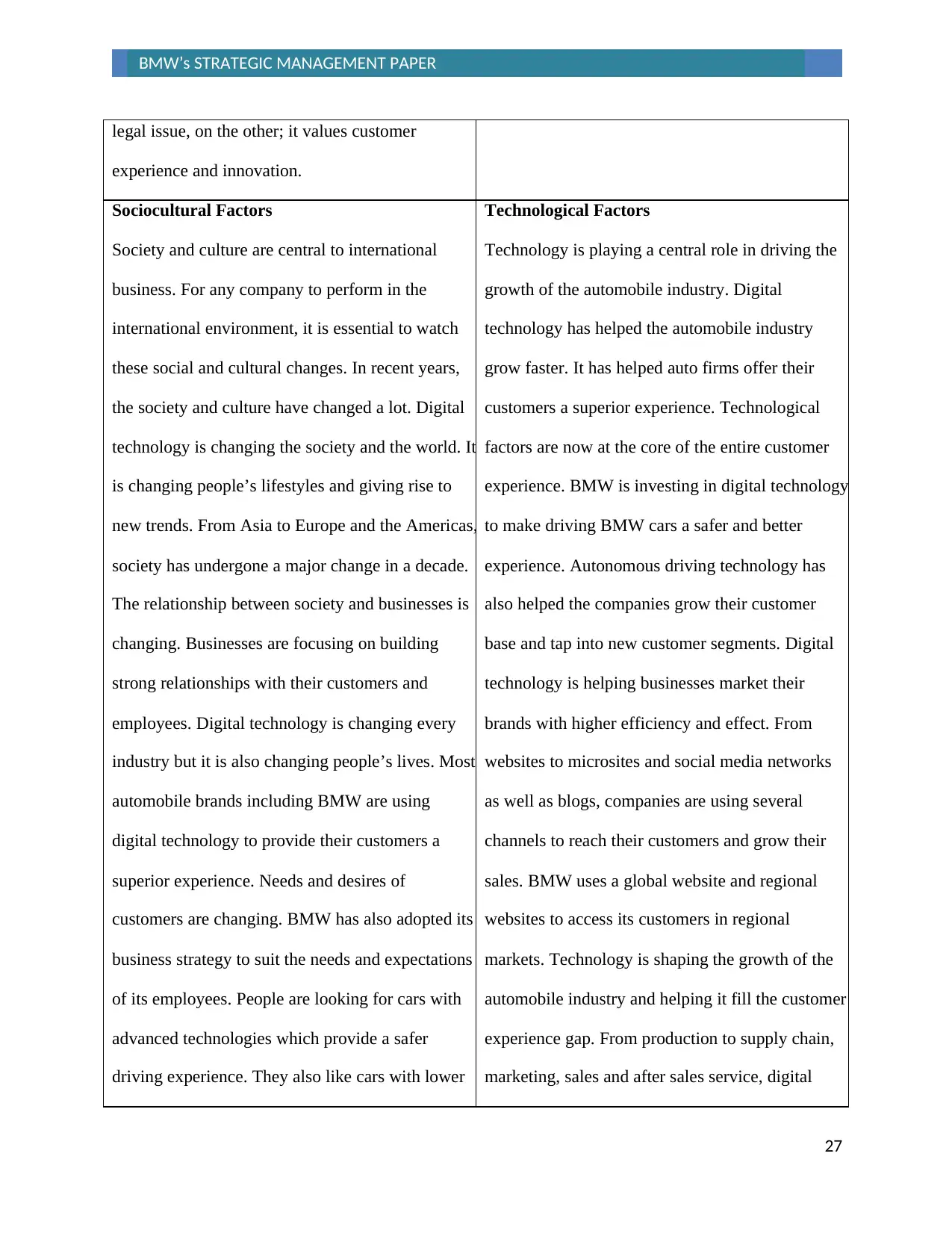
27
BMW’s STRATEGIC MANAGEMENT PAPER
legal issue, on the other; it values customer
experience and innovation.
Sociocultural Factors
Society and culture are central to international
business. For any company to perform in the
international environment, it is essential to watch
these social and cultural changes. In recent years,
the society and culture have changed a lot. Digital
technology is changing the society and the world. It
is changing people’s lifestyles and giving rise to
new trends. From Asia to Europe and the Americas,
society has undergone a major change in a decade.
The relationship between society and businesses is
changing. Businesses are focusing on building
strong relationships with their customers and
employees. Digital technology is changing every
industry but it is also changing people’s lives. Most
automobile brands including BMW are using
digital technology to provide their customers a
superior experience. Needs and desires of
customers are changing. BMW has also adopted its
business strategy to suit the needs and expectations
of its employees. People are looking for cars with
advanced technologies which provide a safer
driving experience. They also like cars with lower
Technological Factors
Technology is playing a central role in driving the
growth of the automobile industry. Digital
technology has helped the automobile industry
grow faster. It has helped auto firms offer their
customers a superior experience. Technological
factors are now at the core of the entire customer
experience. BMW is investing in digital technology
to make driving BMW cars a safer and better
experience. Autonomous driving technology has
also helped the companies grow their customer
base and tap into new customer segments. Digital
technology is helping businesses market their
brands with higher efficiency and effect. From
websites to microsites and social media networks
as well as blogs, companies are using several
channels to reach their customers and grow their
sales. BMW uses a global website and regional
websites to access its customers in regional
markets. Technology is shaping the growth of the
automobile industry and helping it fill the customer
experience gap. From production to supply chain,
marketing, sales and after sales service, digital
BMW’s STRATEGIC MANAGEMENT PAPER
legal issue, on the other; it values customer
experience and innovation.
Sociocultural Factors
Society and culture are central to international
business. For any company to perform in the
international environment, it is essential to watch
these social and cultural changes. In recent years,
the society and culture have changed a lot. Digital
technology is changing the society and the world. It
is changing people’s lifestyles and giving rise to
new trends. From Asia to Europe and the Americas,
society has undergone a major change in a decade.
The relationship between society and businesses is
changing. Businesses are focusing on building
strong relationships with their customers and
employees. Digital technology is changing every
industry but it is also changing people’s lives. Most
automobile brands including BMW are using
digital technology to provide their customers a
superior experience. Needs and desires of
customers are changing. BMW has also adopted its
business strategy to suit the needs and expectations
of its employees. People are looking for cars with
advanced technologies which provide a safer
driving experience. They also like cars with lower
Technological Factors
Technology is playing a central role in driving the
growth of the automobile industry. Digital
technology has helped the automobile industry
grow faster. It has helped auto firms offer their
customers a superior experience. Technological
factors are now at the core of the entire customer
experience. BMW is investing in digital technology
to make driving BMW cars a safer and better
experience. Autonomous driving technology has
also helped the companies grow their customer
base and tap into new customer segments. Digital
technology is helping businesses market their
brands with higher efficiency and effect. From
websites to microsites and social media networks
as well as blogs, companies are using several
channels to reach their customers and grow their
sales. BMW uses a global website and regional
websites to access its customers in regional
markets. Technology is shaping the growth of the
automobile industry and helping it fill the customer
experience gap. From production to supply chain,
marketing, sales and after sales service, digital
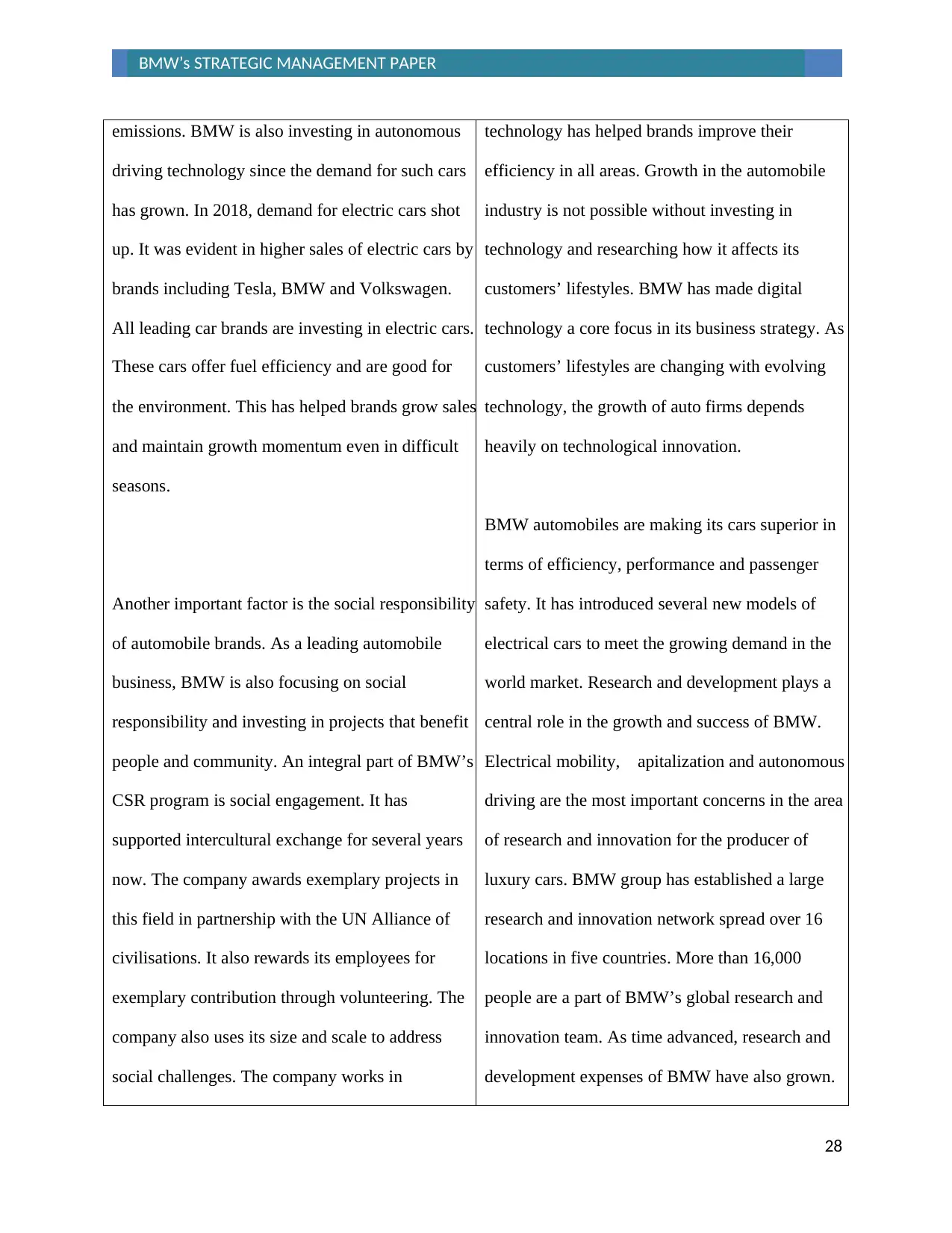
28
BMW’s STRATEGIC MANAGEMENT PAPER
emissions. BMW is also investing in autonomous
driving technology since the demand for such cars
has grown. In 2018, demand for electric cars shot
up. It was evident in higher sales of electric cars by
brands including Tesla, BMW and Volkswagen.
All leading car brands are investing in electric cars.
These cars offer fuel efficiency and are good for
the environment. This has helped brands grow sales
and maintain growth momentum even in difficult
seasons.
Another important factor is the social responsibility
of automobile brands. As a leading automobile
business, BMW is also focusing on social
responsibility and investing in projects that benefit
people and community. An integral part of BMW’s
CSR program is social engagement. It has
supported intercultural exchange for several years
now. The company awards exemplary projects in
this field in partnership with the UN Alliance of
civilisations. It also rewards its employees for
exemplary contribution through volunteering. The
company also uses its size and scale to address
social challenges. The company works in
technology has helped brands improve their
efficiency in all areas. Growth in the automobile
industry is not possible without investing in
technology and researching how it affects its
customers’ lifestyles. BMW has made digital
technology a core focus in its business strategy. As
customers’ lifestyles are changing with evolving
technology, the growth of auto firms depends
heavily on technological innovation.
BMW automobiles are making its cars superior in
terms of efficiency, performance and passenger
safety. It has introduced several new models of
electrical cars to meet the growing demand in the
world market. Research and development plays a
central role in the growth and success of BMW.
Electrical mobility, apitalization and autonomous
driving are the most important concerns in the area
of research and innovation for the producer of
luxury cars. BMW group has established a large
research and innovation network spread over 16
locations in five countries. More than 16,000
people are a part of BMW’s global research and
innovation team. As time advanced, research and
development expenses of BMW have also grown.
BMW’s STRATEGIC MANAGEMENT PAPER
emissions. BMW is also investing in autonomous
driving technology since the demand for such cars
has grown. In 2018, demand for electric cars shot
up. It was evident in higher sales of electric cars by
brands including Tesla, BMW and Volkswagen.
All leading car brands are investing in electric cars.
These cars offer fuel efficiency and are good for
the environment. This has helped brands grow sales
and maintain growth momentum even in difficult
seasons.
Another important factor is the social responsibility
of automobile brands. As a leading automobile
business, BMW is also focusing on social
responsibility and investing in projects that benefit
people and community. An integral part of BMW’s
CSR program is social engagement. It has
supported intercultural exchange for several years
now. The company awards exemplary projects in
this field in partnership with the UN Alliance of
civilisations. It also rewards its employees for
exemplary contribution through volunteering. The
company also uses its size and scale to address
social challenges. The company works in
technology has helped brands improve their
efficiency in all areas. Growth in the automobile
industry is not possible without investing in
technology and researching how it affects its
customers’ lifestyles. BMW has made digital
technology a core focus in its business strategy. As
customers’ lifestyles are changing with evolving
technology, the growth of auto firms depends
heavily on technological innovation.
BMW automobiles are making its cars superior in
terms of efficiency, performance and passenger
safety. It has introduced several new models of
electrical cars to meet the growing demand in the
world market. Research and development plays a
central role in the growth and success of BMW.
Electrical mobility, apitalization and autonomous
driving are the most important concerns in the area
of research and innovation for the producer of
luxury cars. BMW group has established a large
research and innovation network spread over 16
locations in five countries. More than 16,000
people are a part of BMW’s global research and
innovation team. As time advanced, research and
development expenses of BMW have also grown.
Secure Best Marks with AI Grader
Need help grading? Try our AI Grader for instant feedback on your assignments.
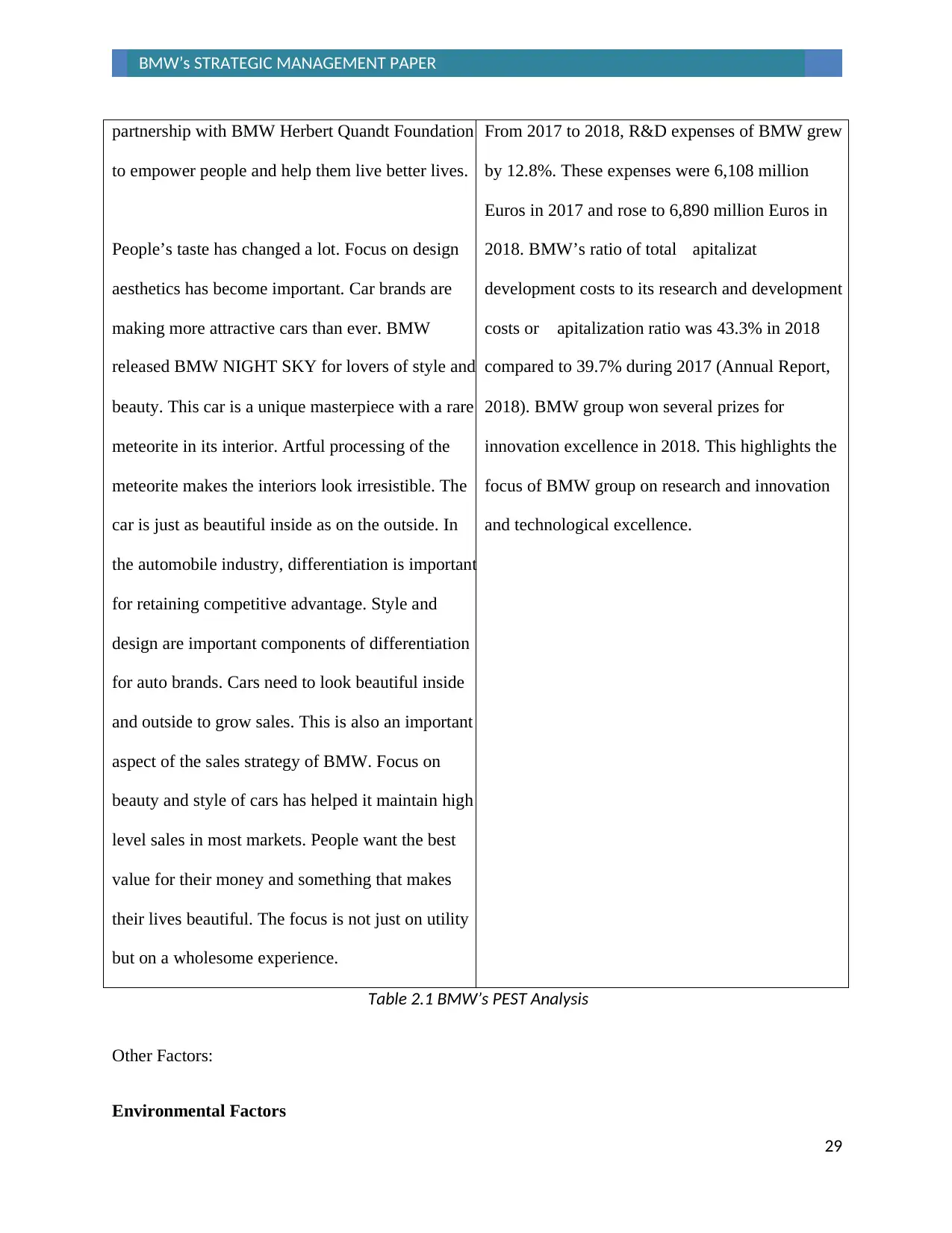
29
BMW’s STRATEGIC MANAGEMENT PAPER
partnership with BMW Herbert Quandt Foundation
to empower people and help them live better lives.
People’s taste has changed a lot. Focus on design
aesthetics has become important. Car brands are
making more attractive cars than ever. BMW
released BMW NIGHT SKY for lovers of style and
beauty. This car is a unique masterpiece with a rare
meteorite in its interior. Artful processing of the
meteorite makes the interiors look irresistible. The
car is just as beautiful inside as on the outside. In
the automobile industry, differentiation is important
for retaining competitive advantage. Style and
design are important components of differentiation
for auto brands. Cars need to look beautiful inside
and outside to grow sales. This is also an important
aspect of the sales strategy of BMW. Focus on
beauty and style of cars has helped it maintain high
level sales in most markets. People want the best
value for their money and something that makes
their lives beautiful. The focus is not just on utility
but on a wholesome experience.
From 2017 to 2018, R&D expenses of BMW grew
by 12.8%. These expenses were 6,108 million
Euros in 2017 and rose to 6,890 million Euros in
2018. BMW’s ratio of total apitalizat
development costs to its research and development
costs or apitalization ratio was 43.3% in 2018
compared to 39.7% during 2017 (Annual Report,
2018). BMW group won several prizes for
innovation excellence in 2018. This highlights the
focus of BMW group on research and innovation
and technological excellence.
Table 2.1 BMW’s PEST Analysis
Other Factors:
Environmental Factors
BMW’s STRATEGIC MANAGEMENT PAPER
partnership with BMW Herbert Quandt Foundation
to empower people and help them live better lives.
People’s taste has changed a lot. Focus on design
aesthetics has become important. Car brands are
making more attractive cars than ever. BMW
released BMW NIGHT SKY for lovers of style and
beauty. This car is a unique masterpiece with a rare
meteorite in its interior. Artful processing of the
meteorite makes the interiors look irresistible. The
car is just as beautiful inside as on the outside. In
the automobile industry, differentiation is important
for retaining competitive advantage. Style and
design are important components of differentiation
for auto brands. Cars need to look beautiful inside
and outside to grow sales. This is also an important
aspect of the sales strategy of BMW. Focus on
beauty and style of cars has helped it maintain high
level sales in most markets. People want the best
value for their money and something that makes
their lives beautiful. The focus is not just on utility
but on a wholesome experience.
From 2017 to 2018, R&D expenses of BMW grew
by 12.8%. These expenses were 6,108 million
Euros in 2017 and rose to 6,890 million Euros in
2018. BMW’s ratio of total apitalizat
development costs to its research and development
costs or apitalization ratio was 43.3% in 2018
compared to 39.7% during 2017 (Annual Report,
2018). BMW group won several prizes for
innovation excellence in 2018. This highlights the
focus of BMW group on research and innovation
and technological excellence.
Table 2.1 BMW’s PEST Analysis
Other Factors:
Environmental Factors
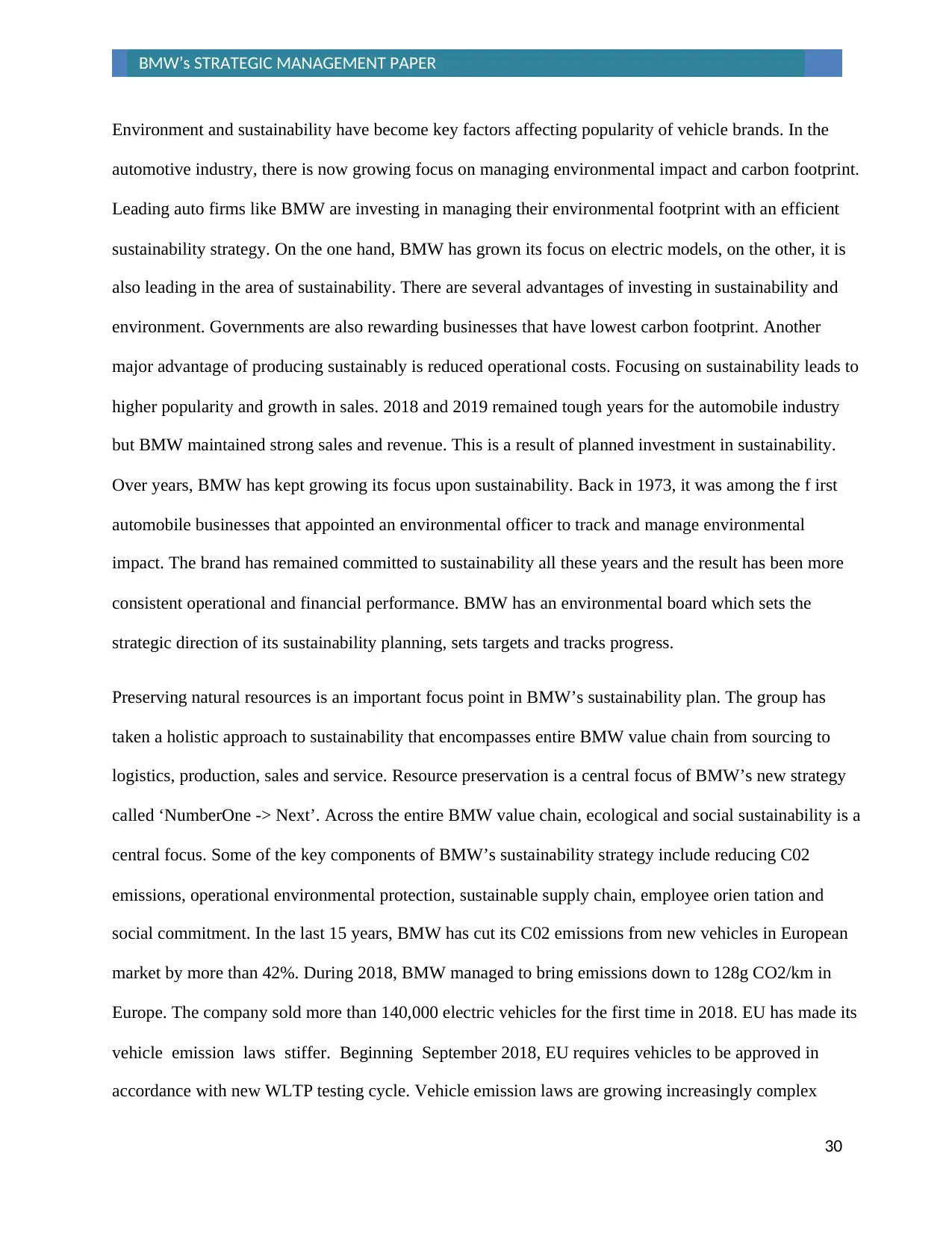
30
BMW’s STRATEGIC MANAGEMENT PAPER
Environment and sustainability have become key factors affecting popularity of vehicle brands. In the
automotive industry, there is now growing focus on managing environmental impact and carbon footprint.
Leading auto firms like BMW are investing in managing their environmental footprint with an efficient
sustainability strategy. On the one hand, BMW has grown its focus on electric models, on the other, it is
also leading in the area of sustainability. There are several advantages of investing in sustainability and
environment. Governments are also rewarding businesses that have lowest carbon footprint. Another
major advantage of producing sustainably is reduced operational costs. Focusing on sustainability leads to
higher popularity and growth in sales. 2018 and 2019 remained tough years for the automobile industry
but BMW maintained strong sales and revenue. This is a result of planned investment in sustainability.
Over years, BMW has kept growing its focus upon sustainability. Back in 1973, it was among the f irst
automobile businesses that appointed an environmental officer to track and manage environmental
impact. The brand has remained committed to sustainability all these years and the result has been more
consistent operational and financial performance. BMW has an environmental board which sets the
strategic direction of its sustainability planning, sets targets and tracks progress.
Preserving natural resources is an important focus point in BMW’s sustainability plan. The group has
taken a holistic approach to sustainability that encompasses entire BMW value chain from sourcing to
logistics, production, sales and service. Resource preservation is a central focus of BMW’s new strategy
called ‘NumberOne -> Next’. Across the entire BMW value chain, ecological and social sustainability is a
central focus. Some of the key components of BMW’s sustainability strategy include reducing C02
emissions, operational environmental protection, sustainable supply chain, employee orien tation and
social commitment. In the last 15 years, BMW has cut its C02 emissions from new vehicles in European
market by more than 42%. During 2018, BMW managed to bring emissions down to 128g CO2/km in
Europe. The company sold more than 140,000 electric vehicles for the first time in 2018. EU has made its
vehicle emission laws stiffer. Beginning September 2018, EU requires vehicles to be approved in
accordance with new WLTP testing cycle. Vehicle emission laws are growing increasingly complex
BMW’s STRATEGIC MANAGEMENT PAPER
Environment and sustainability have become key factors affecting popularity of vehicle brands. In the
automotive industry, there is now growing focus on managing environmental impact and carbon footprint.
Leading auto firms like BMW are investing in managing their environmental footprint with an efficient
sustainability strategy. On the one hand, BMW has grown its focus on electric models, on the other, it is
also leading in the area of sustainability. There are several advantages of investing in sustainability and
environment. Governments are also rewarding businesses that have lowest carbon footprint. Another
major advantage of producing sustainably is reduced operational costs. Focusing on sustainability leads to
higher popularity and growth in sales. 2018 and 2019 remained tough years for the automobile industry
but BMW maintained strong sales and revenue. This is a result of planned investment in sustainability.
Over years, BMW has kept growing its focus upon sustainability. Back in 1973, it was among the f irst
automobile businesses that appointed an environmental officer to track and manage environmental
impact. The brand has remained committed to sustainability all these years and the result has been more
consistent operational and financial performance. BMW has an environmental board which sets the
strategic direction of its sustainability planning, sets targets and tracks progress.
Preserving natural resources is an important focus point in BMW’s sustainability plan. The group has
taken a holistic approach to sustainability that encompasses entire BMW value chain from sourcing to
logistics, production, sales and service. Resource preservation is a central focus of BMW’s new strategy
called ‘NumberOne -> Next’. Across the entire BMW value chain, ecological and social sustainability is a
central focus. Some of the key components of BMW’s sustainability strategy include reducing C02
emissions, operational environmental protection, sustainable supply chain, employee orien tation and
social commitment. In the last 15 years, BMW has cut its C02 emissions from new vehicles in European
market by more than 42%. During 2018, BMW managed to bring emissions down to 128g CO2/km in
Europe. The company sold more than 140,000 electric vehicles for the first time in 2018. EU has made its
vehicle emission laws stiffer. Beginning September 2018, EU requires vehicles to be approved in
accordance with new WLTP testing cycle. Vehicle emission laws are growing increasingly complex
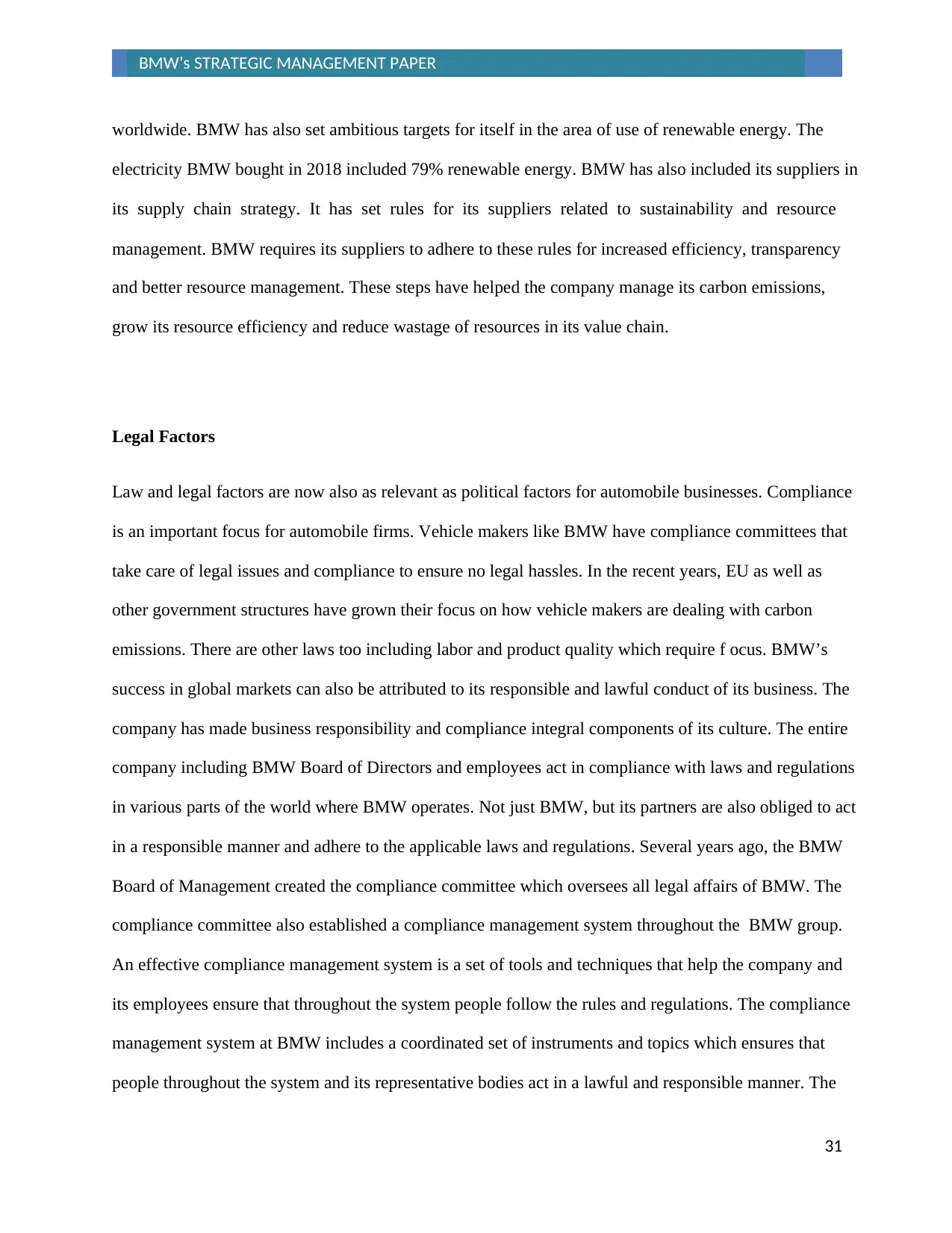
31
BMW’s STRATEGIC MANAGEMENT PAPER
worldwide. BMW has also set ambitious targets for itself in the area of use of renewable energy. The
electricity BMW bought in 2018 included 79% renewable energy. BMW has also included its suppliers in
its supply chain strategy. It has set rules for its suppliers related to sustainability and resource
management. BMW requires its suppliers to adhere to these rules for increased efficiency, transparency
and better resource management. These steps have helped the company manage its carbon emissions,
grow its resource efficiency and reduce wastage of resources in its value chain.
Legal Factors
Law and legal factors are now also as relevant as political factors for automobile businesses. Compliance
is an important focus for automobile firms. Vehicle makers like BMW have compliance committees that
take care of legal issues and compliance to ensure no legal hassles. In the recent years, EU as well as
other government structures have grown their focus on how vehicle makers are dealing with carbon
emissions. There are other laws too including labor and product quality which require f ocus. BMW’s
success in global markets can also be attributed to its responsible and lawful conduct of its business. The
company has made business responsibility and compliance integral components of its culture. The entire
company including BMW Board of Directors and employees act in compliance with laws and regulations
in various parts of the world where BMW operates. Not just BMW, but its partners are also obliged to act
in a responsible manner and adhere to the applicable laws and regulations. Several years ago, the BMW
Board of Management created the compliance committee which oversees all legal affairs of BMW. The
compliance committee also established a compliance management system throughout the BMW group.
An effective compliance management system is a set of tools and techniques that help the company and
its employees ensure that throughout the system people follow the rules and regulations. The compliance
management system at BMW includes a coordinated set of instruments and topics which ensures that
people throughout the system and its representative bodies act in a lawful and responsible manner. The
BMW’s STRATEGIC MANAGEMENT PAPER
worldwide. BMW has also set ambitious targets for itself in the area of use of renewable energy. The
electricity BMW bought in 2018 included 79% renewable energy. BMW has also included its suppliers in
its supply chain strategy. It has set rules for its suppliers related to sustainability and resource
management. BMW requires its suppliers to adhere to these rules for increased efficiency, transparency
and better resource management. These steps have helped the company manage its carbon emissions,
grow its resource efficiency and reduce wastage of resources in its value chain.
Legal Factors
Law and legal factors are now also as relevant as political factors for automobile businesses. Compliance
is an important focus for automobile firms. Vehicle makers like BMW have compliance committees that
take care of legal issues and compliance to ensure no legal hassles. In the recent years, EU as well as
other government structures have grown their focus on how vehicle makers are dealing with carbon
emissions. There are other laws too including labor and product quality which require f ocus. BMW’s
success in global markets can also be attributed to its responsible and lawful conduct of its business. The
company has made business responsibility and compliance integral components of its culture. The entire
company including BMW Board of Directors and employees act in compliance with laws and regulations
in various parts of the world where BMW operates. Not just BMW, but its partners are also obliged to act
in a responsible manner and adhere to the applicable laws and regulations. Several years ago, the BMW
Board of Management created the compliance committee which oversees all legal affairs of BMW. The
compliance committee also established a compliance management system throughout the BMW group.
An effective compliance management system is a set of tools and techniques that help the company and
its employees ensure that throughout the system people follow the rules and regulations. The compliance
management system at BMW includes a coordinated set of instruments and topics which ensures that
people throughout the system and its representative bodies act in a lawful and responsible manner. The
Paraphrase This Document
Need a fresh take? Get an instant paraphrase of this document with our AI Paraphraser
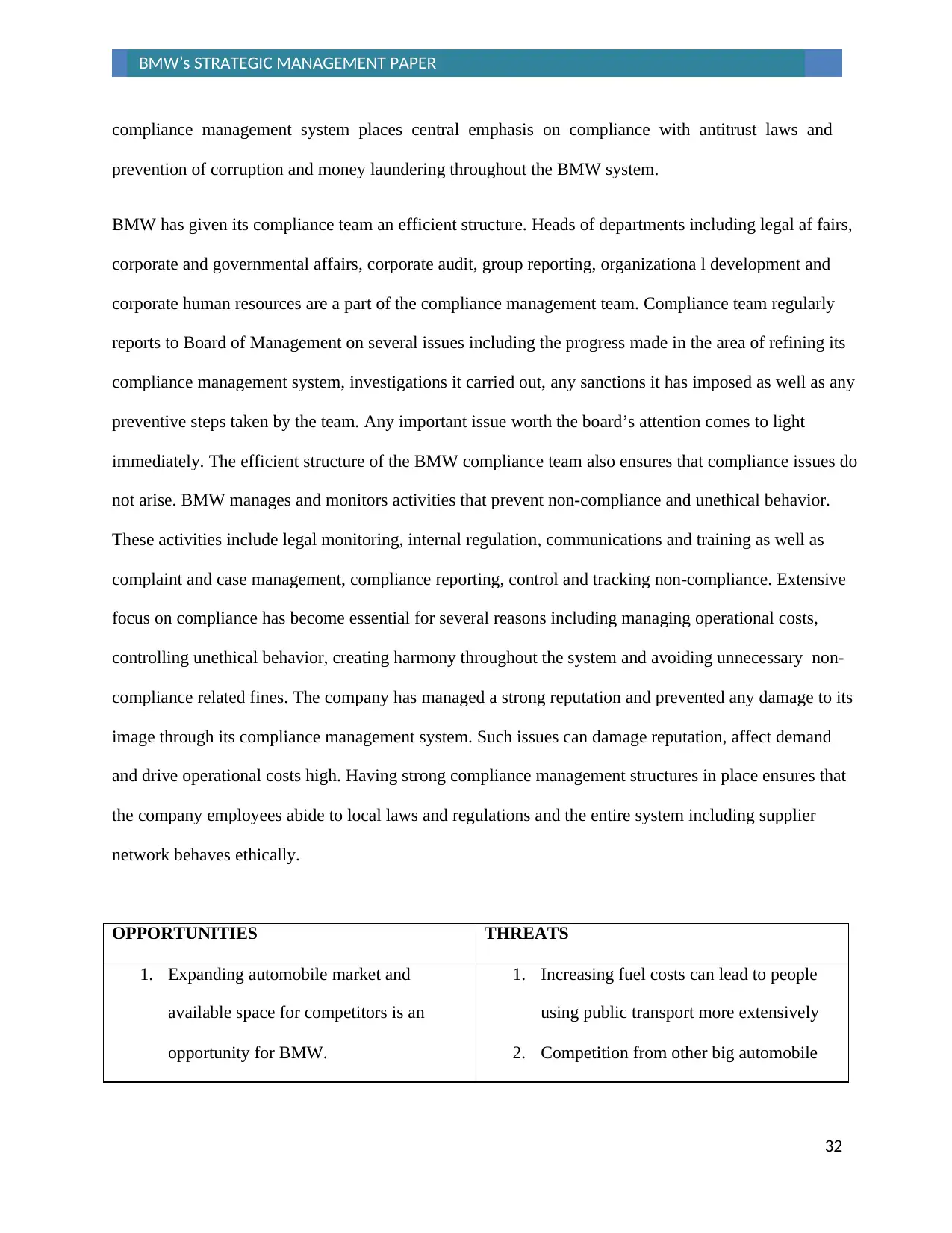
32
BMW’s STRATEGIC MANAGEMENT PAPER
compliance management system places central emphasis on compliance with antitrust laws and
prevention of corruption and money laundering throughout the BMW system.
BMW has given its compliance team an efficient structure. Heads of departments including legal af fairs,
corporate and governmental affairs, corporate audit, group reporting, organizationa l development and
corporate human resources are a part of the compliance management team. Compliance team regularly
reports to Board of Management on several issues including the progress made in the area of refining its
compliance management system, investigations it carried out, any sanctions it has imposed as well as any
preventive steps taken by the team. Any important issue worth the board’s attention comes to light
immediately. The efficient structure of the BMW compliance team also ensures that compliance issues do
not arise. BMW manages and monitors activities that prevent non-compliance and unethical behavior.
These activities include legal monitoring, internal regulation, communications and training as well as
complaint and case management, compliance reporting, control and tracking non-compliance. Extensive
focus on compliance has become essential for several reasons including managing operational costs,
controlling unethical behavior, creating harmony throughout the system and avoiding unnecessary non-
compliance related fines. The company has managed a strong reputation and prevented any damage to its
image through its compliance management system. Such issues can damage reputation, affect demand
and drive operational costs high. Having strong compliance management structures in place ensures that
the company employees abide to local laws and regulations and the entire system including supplier
network behaves ethically.
OPPORTUNITIES THREATS
1. Expanding automobile market and
available space for competitors is an
opportunity for BMW.
1. Increasing fuel costs can lead to people
using public transport more extensively
2. Competition from other big automobile
BMW’s STRATEGIC MANAGEMENT PAPER
compliance management system places central emphasis on compliance with antitrust laws and
prevention of corruption and money laundering throughout the BMW system.
BMW has given its compliance team an efficient structure. Heads of departments including legal af fairs,
corporate and governmental affairs, corporate audit, group reporting, organizationa l development and
corporate human resources are a part of the compliance management team. Compliance team regularly
reports to Board of Management on several issues including the progress made in the area of refining its
compliance management system, investigations it carried out, any sanctions it has imposed as well as any
preventive steps taken by the team. Any important issue worth the board’s attention comes to light
immediately. The efficient structure of the BMW compliance team also ensures that compliance issues do
not arise. BMW manages and monitors activities that prevent non-compliance and unethical behavior.
These activities include legal monitoring, internal regulation, communications and training as well as
complaint and case management, compliance reporting, control and tracking non-compliance. Extensive
focus on compliance has become essential for several reasons including managing operational costs,
controlling unethical behavior, creating harmony throughout the system and avoiding unnecessary non-
compliance related fines. The company has managed a strong reputation and prevented any damage to its
image through its compliance management system. Such issues can damage reputation, affect demand
and drive operational costs high. Having strong compliance management structures in place ensures that
the company employees abide to local laws and regulations and the entire system including supplier
network behaves ethically.
OPPORTUNITIES THREATS
1. Expanding automobile market and
available space for competitors is an
opportunity for BMW.
1. Increasing fuel costs can lead to people
using public transport more extensively
2. Competition from other big automobile
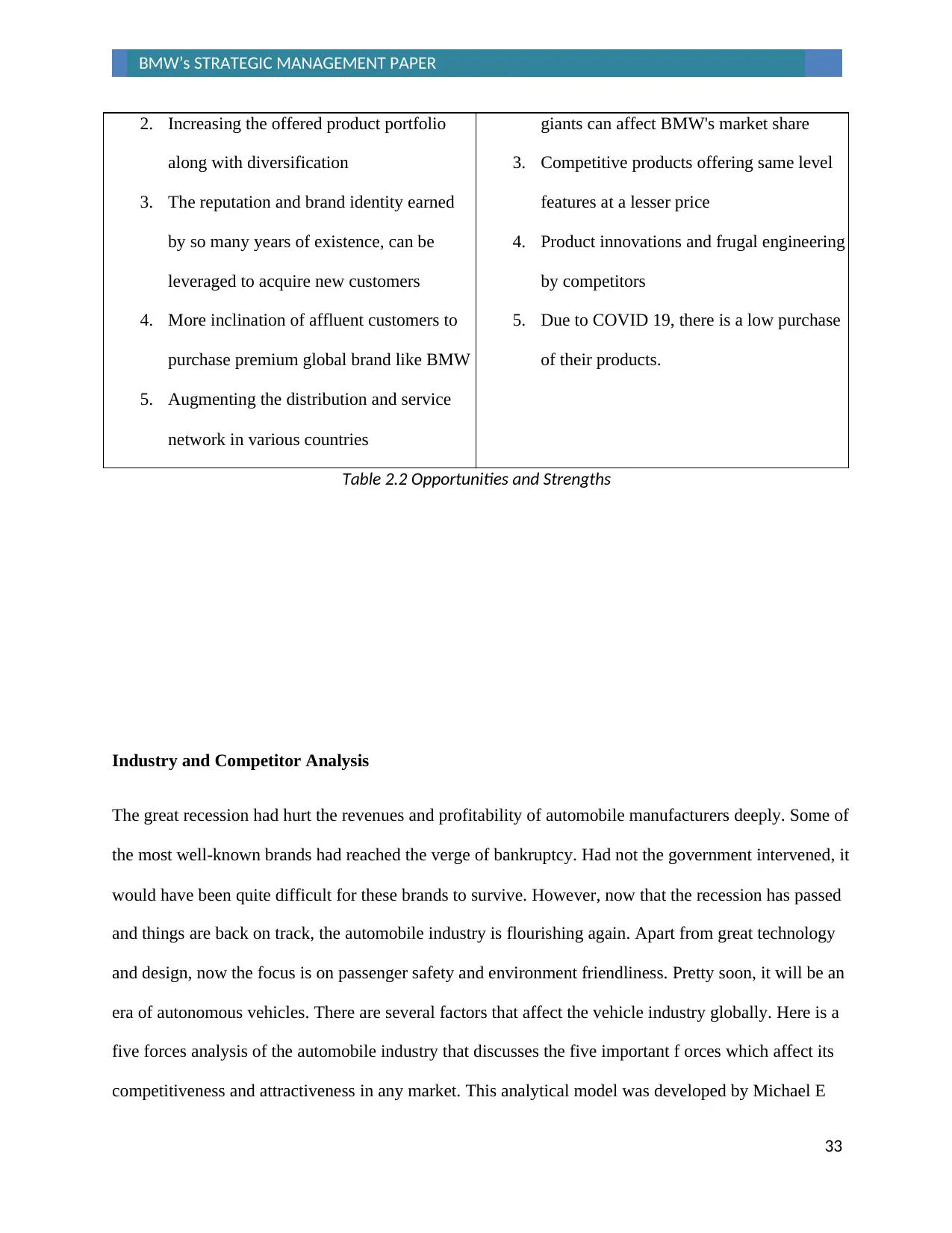
33
BMW’s STRATEGIC MANAGEMENT PAPER
Table 2.2 Opportunities and Strengths
Industry and Competitor Analysis
The great recession had hurt the revenues and profitability of automobile manufacturers deeply. Some of
the most well-known brands had reached the verge of bankruptcy. Had not the government intervened, it
would have been quite difficult for these brands to survive. However, now that the recession has passed
and things are back on track, the automobile industry is flourishing again. Apart from great technology
and design, now the focus is on passenger safety and environment friendliness. Pretty soon, it will be an
era of autonomous vehicles. There are several factors that affect the vehicle industry globally. Here is a
five forces analysis of the automobile industry that discusses the five important f orces which affect its
competitiveness and attractiveness in any market. This analytical model was developed by Michael E
2. Increasing the offered product portfolio
along with diversification
3. The reputation and brand identity earned
by so many years of existence, can be
leveraged to acquire new customers
4. More inclination of affluent customers to
purchase premium global brand like BMW
5. Augmenting the distribution and service
network in various countries
giants can affect BMW's market share
3. Competitive products offering same level
features at a lesser price
4. Product innovations and frugal engineering
by competitors
5. Due to COVID 19, there is a low purchase
of their products.
BMW’s STRATEGIC MANAGEMENT PAPER
Table 2.2 Opportunities and Strengths
Industry and Competitor Analysis
The great recession had hurt the revenues and profitability of automobile manufacturers deeply. Some of
the most well-known brands had reached the verge of bankruptcy. Had not the government intervened, it
would have been quite difficult for these brands to survive. However, now that the recession has passed
and things are back on track, the automobile industry is flourishing again. Apart from great technology
and design, now the focus is on passenger safety and environment friendliness. Pretty soon, it will be an
era of autonomous vehicles. There are several factors that affect the vehicle industry globally. Here is a
five forces analysis of the automobile industry that discusses the five important f orces which affect its
competitiveness and attractiveness in any market. This analytical model was developed by Michael E
2. Increasing the offered product portfolio
along with diversification
3. The reputation and brand identity earned
by so many years of existence, can be
leveraged to acquire new customers
4. More inclination of affluent customers to
purchase premium global brand like BMW
5. Augmenting the distribution and service
network in various countries
giants can affect BMW's market share
3. Competitive products offering same level
features at a lesser price
4. Product innovations and frugal engineering
by competitors
5. Due to COVID 19, there is a low purchase
of their products.
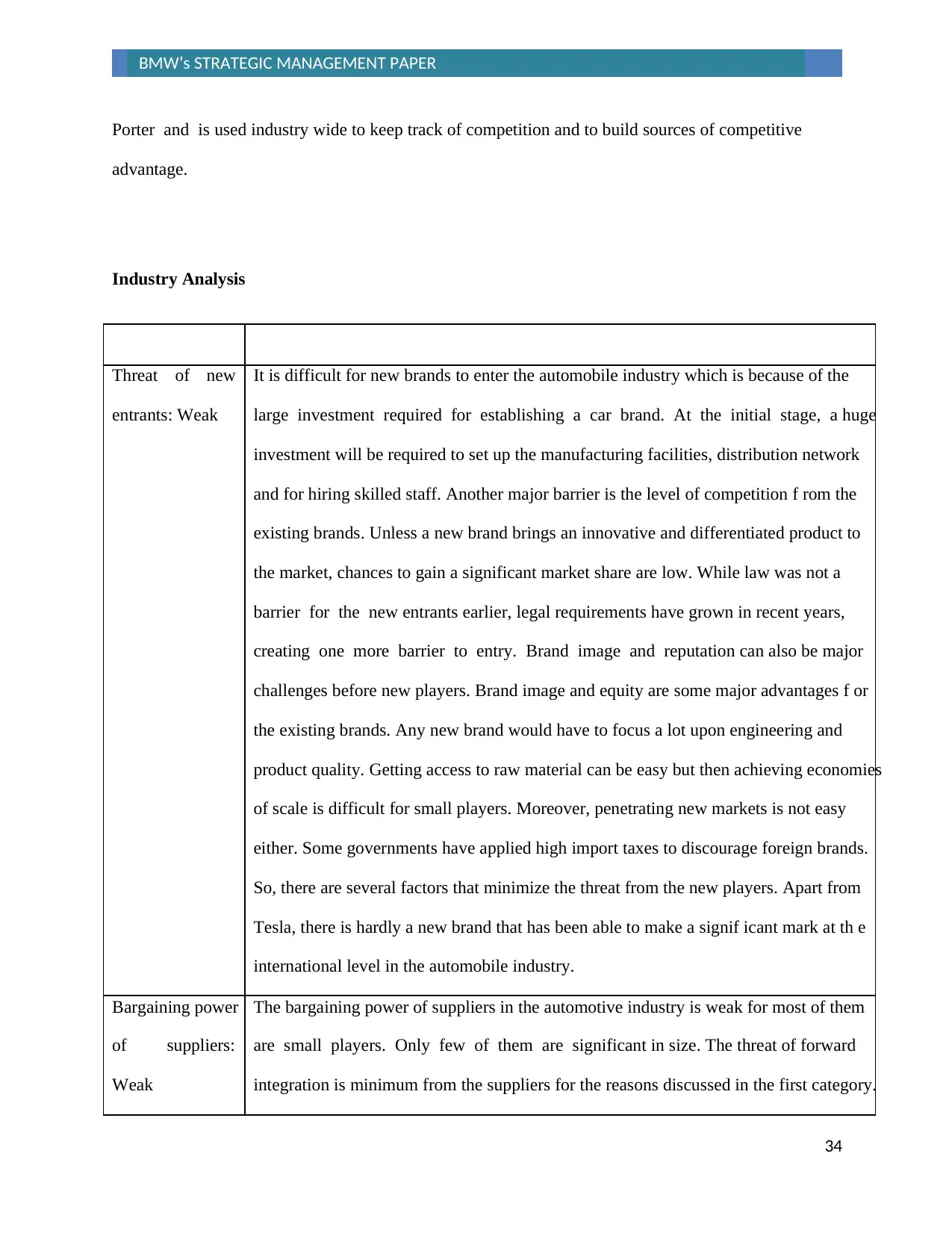
34
BMW’s STRATEGIC MANAGEMENT PAPER
Porter and is used industry wide to keep track of competition and to build sources of competitive
advantage.
Industry Analysis
Threat of new
entrants: Weak
It is difficult for new brands to enter the automobile industry which is because of the
large investment required for establishing a car brand. At the initial stage, a huge
investment will be required to set up the manufacturing facilities, distribution network
and for hiring skilled staff. Another major barrier is the level of competition f rom the
existing brands. Unless a new brand brings an innovative and differentiated product to
the market, chances to gain a significant market share are low. While law was not a
barrier for the new entrants earlier, legal requirements have grown in recent years,
creating one more barrier to entry. Brand image and reputation can also be major
challenges before new players. Brand image and equity are some major advantages f or
the existing brands. Any new brand would have to focus a lot upon engineering and
product quality. Getting access to raw material can be easy but then achieving economies
of scale is difficult for small players. Moreover, penetrating new markets is not easy
either. Some governments have applied high import taxes to discourage foreign brands.
So, there are several factors that minimize the threat from the new players. Apart from
Tesla, there is hardly a new brand that has been able to make a signif icant mark at th e
international level in the automobile industry.
Bargaining power
of suppliers:
Weak
The bargaining power of suppliers in the automotive industry is weak for most of them
are small players. Only few of them are significant in size. The threat of forward
integration is minimum from the suppliers for the reasons discussed in the first category.
BMW’s STRATEGIC MANAGEMENT PAPER
Porter and is used industry wide to keep track of competition and to build sources of competitive
advantage.
Industry Analysis
Threat of new
entrants: Weak
It is difficult for new brands to enter the automobile industry which is because of the
large investment required for establishing a car brand. At the initial stage, a huge
investment will be required to set up the manufacturing facilities, distribution network
and for hiring skilled staff. Another major barrier is the level of competition f rom the
existing brands. Unless a new brand brings an innovative and differentiated product to
the market, chances to gain a significant market share are low. While law was not a
barrier for the new entrants earlier, legal requirements have grown in recent years,
creating one more barrier to entry. Brand image and reputation can also be major
challenges before new players. Brand image and equity are some major advantages f or
the existing brands. Any new brand would have to focus a lot upon engineering and
product quality. Getting access to raw material can be easy but then achieving economies
of scale is difficult for small players. Moreover, penetrating new markets is not easy
either. Some governments have applied high import taxes to discourage foreign brands.
So, there are several factors that minimize the threat from the new players. Apart from
Tesla, there is hardly a new brand that has been able to make a signif icant mark at th e
international level in the automobile industry.
Bargaining power
of suppliers:
Weak
The bargaining power of suppliers in the automotive industry is weak for most of them
are small players. Only few of them are significant in size. The threat of forward
integration is minimum from the suppliers for the reasons discussed in the first category.
Secure Best Marks with AI Grader
Need help grading? Try our AI Grader for instant feedback on your assignments.
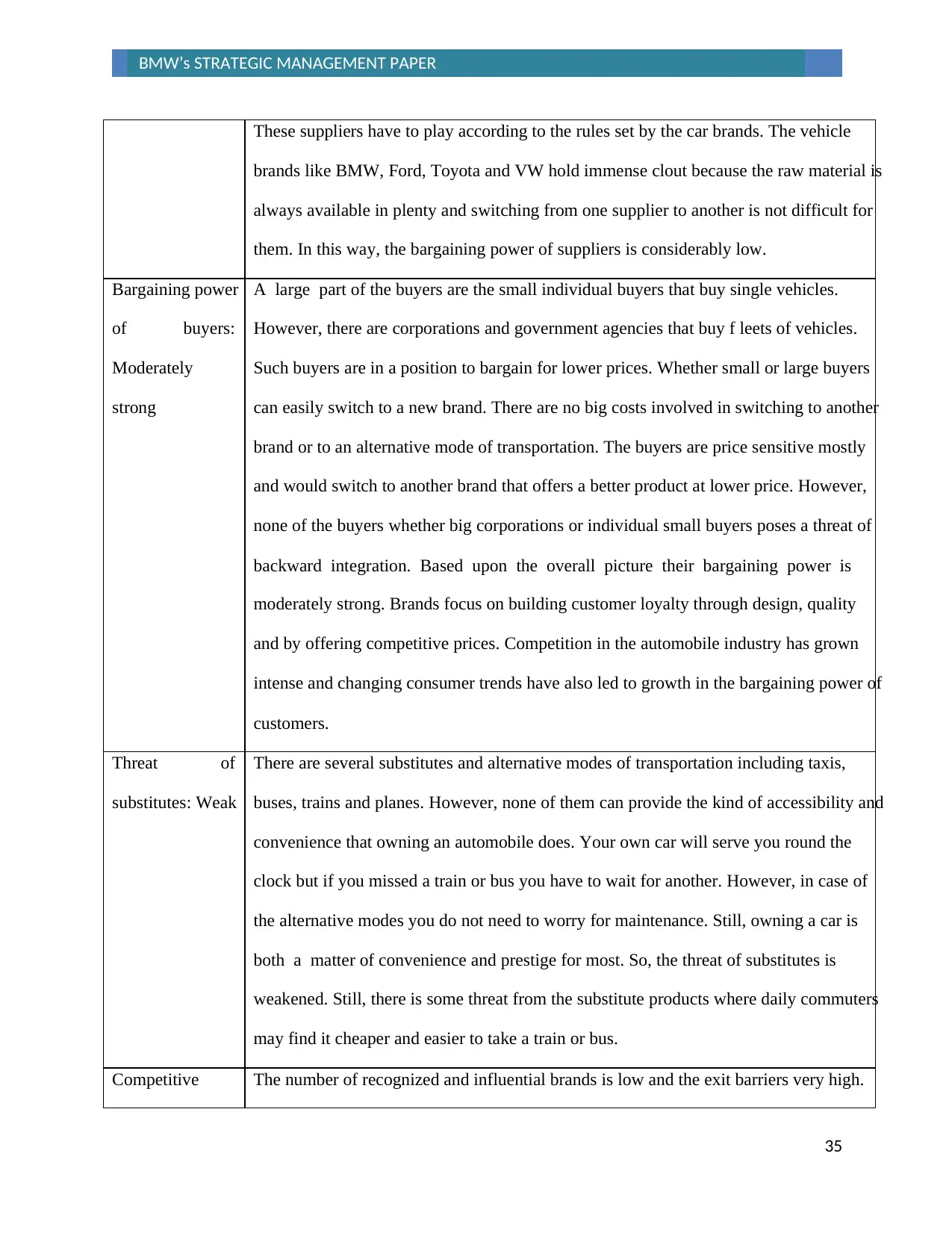
35
BMW’s STRATEGIC MANAGEMENT PAPER
These suppliers have to play according to the rules set by the car brands. The vehicle
brands like BMW, Ford, Toyota and VW hold immense clout because the raw material is
always available in plenty and switching from one supplier to another is not difficult for
them. In this way, the bargaining power of suppliers is considerably low.
Bargaining power
of buyers:
Moderately
strong
A large part of the buyers are the small individual buyers that buy single vehicles.
However, there are corporations and government agencies that buy f leets of vehicles.
Such buyers are in a position to bargain for lower prices. Whether small or large buyers
can easily switch to a new brand. There are no big costs involved in switching to another
brand or to an alternative mode of transportation. The buyers are price sensitive mostly
and would switch to another brand that offers a better product at lower price. However,
none of the buyers whether big corporations or individual small buyers poses a threat of
backward integration. Based upon the overall picture their bargaining power is
moderately strong. Brands focus on building customer loyalty through design, quality
and by offering competitive prices. Competition in the automobile industry has grown
intense and changing consumer trends have also led to growth in the bargaining power of
customers.
Threat of
substitutes: Weak
There are several substitutes and alternative modes of transportation including taxis,
buses, trains and planes. However, none of them can provide the kind of accessibility and
convenience that owning an automobile does. Your own car will serve you round the
clock but if you missed a train or bus you have to wait for another. However, in case of
the alternative modes you do not need to worry for maintenance. Still, owning a car is
both a matter of convenience and prestige for most. So, the threat of substitutes is
weakened. Still, there is some threat from the substitute products where daily commuters
may find it cheaper and easier to take a train or bus.
Competitive The number of recognized and influential brands is low and the exit barriers very high.
BMW’s STRATEGIC MANAGEMENT PAPER
These suppliers have to play according to the rules set by the car brands. The vehicle
brands like BMW, Ford, Toyota and VW hold immense clout because the raw material is
always available in plenty and switching from one supplier to another is not difficult for
them. In this way, the bargaining power of suppliers is considerably low.
Bargaining power
of buyers:
Moderately
strong
A large part of the buyers are the small individual buyers that buy single vehicles.
However, there are corporations and government agencies that buy f leets of vehicles.
Such buyers are in a position to bargain for lower prices. Whether small or large buyers
can easily switch to a new brand. There are no big costs involved in switching to another
brand or to an alternative mode of transportation. The buyers are price sensitive mostly
and would switch to another brand that offers a better product at lower price. However,
none of the buyers whether big corporations or individual small buyers poses a threat of
backward integration. Based upon the overall picture their bargaining power is
moderately strong. Brands focus on building customer loyalty through design, quality
and by offering competitive prices. Competition in the automobile industry has grown
intense and changing consumer trends have also led to growth in the bargaining power of
customers.
Threat of
substitutes: Weak
There are several substitutes and alternative modes of transportation including taxis,
buses, trains and planes. However, none of them can provide the kind of accessibility and
convenience that owning an automobile does. Your own car will serve you round the
clock but if you missed a train or bus you have to wait for another. However, in case of
the alternative modes you do not need to worry for maintenance. Still, owning a car is
both a matter of convenience and prestige for most. So, the threat of substitutes is
weakened. Still, there is some threat from the substitute products where daily commuters
may find it cheaper and easier to take a train or bus.
Competitive The number of recognized and influential brands is low and the exit barriers very high.
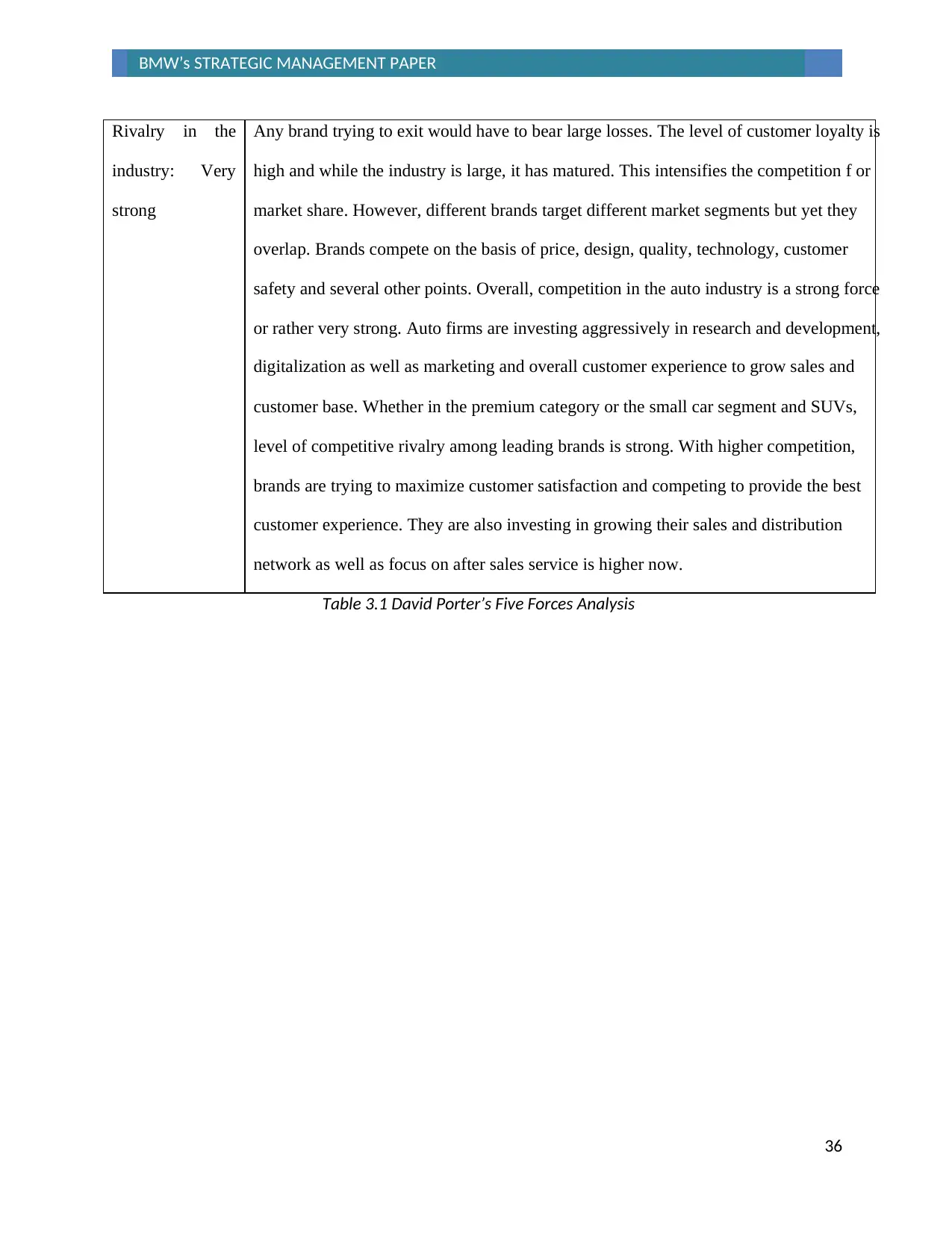
36
BMW’s STRATEGIC MANAGEMENT PAPER
Rivalry in the
industry: Very
strong
Any brand trying to exit would have to bear large losses. The level of customer loyalty is
high and while the industry is large, it has matured. This intensifies the competition f or
market share. However, different brands target different market segments but yet they
overlap. Brands compete on the basis of price, design, quality, technology, customer
safety and several other points. Overall, competition in the auto industry is a strong force
or rather very strong. Auto firms are investing aggressively in research and development,
digitalization as well as marketing and overall customer experience to grow sales and
customer base. Whether in the premium category or the small car segment and SUVs,
level of competitive rivalry among leading brands is strong. With higher competition,
brands are trying to maximize customer satisfaction and competing to provide the best
customer experience. They are also investing in growing their sales and distribution
network as well as focus on after sales service is higher now.
Table 3.1 David Porter’s Five Forces Analysis
BMW’s STRATEGIC MANAGEMENT PAPER
Rivalry in the
industry: Very
strong
Any brand trying to exit would have to bear large losses. The level of customer loyalty is
high and while the industry is large, it has matured. This intensifies the competition f or
market share. However, different brands target different market segments but yet they
overlap. Brands compete on the basis of price, design, quality, technology, customer
safety and several other points. Overall, competition in the auto industry is a strong force
or rather very strong. Auto firms are investing aggressively in research and development,
digitalization as well as marketing and overall customer experience to grow sales and
customer base. Whether in the premium category or the small car segment and SUVs,
level of competitive rivalry among leading brands is strong. With higher competition,
brands are trying to maximize customer satisfaction and competing to provide the best
customer experience. They are also investing in growing their sales and distribution
network as well as focus on after sales service is higher now.
Table 3.1 David Porter’s Five Forces Analysis
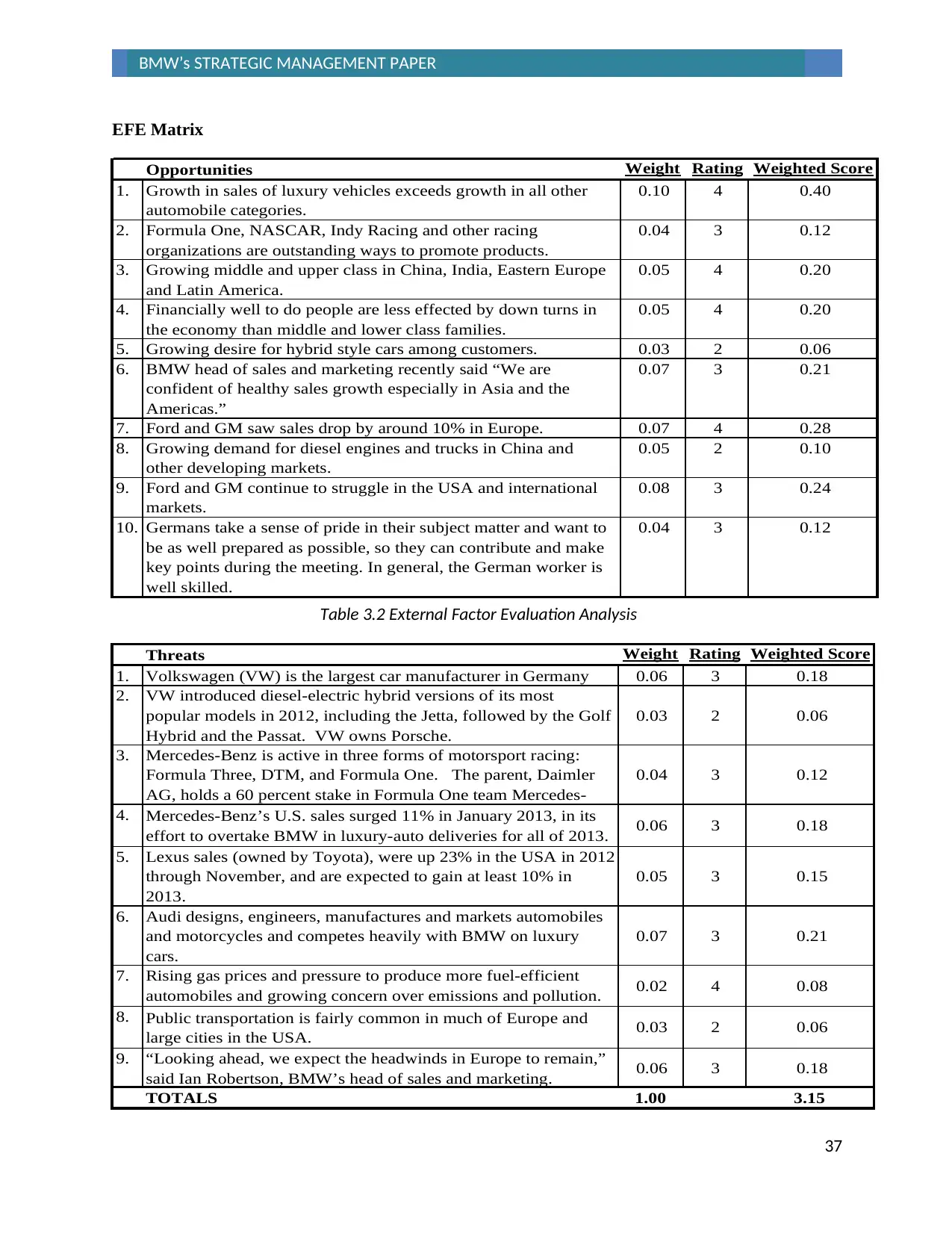
37
BMW’s STRATEGIC MANAGEMENT PAPER
Opportunities Weight Rating Weighted Score
1. Growth in sales of luxury vehicles exceeds growth in all other
automobile categories.
0.10 4 0.40
2. Formula One, NASCAR, Indy Racing and other racing
organizations are outstanding ways to promote products.
0.04 3 0.12
3. Growing middle and upper class in China, India, Eastern Europe
and Latin America.
0.05 4 0.20
4. Financially well to do people are less effected by down turns in
the economy than middle and lower class families.
0.05 4 0.20
5. Growing desire for hybrid style cars among customers. 0.03 2 0.06
6. BMW head of sales and marketing recently said “We are
confident of healthy sales growth especially in Asia and the
Americas.”
0.07 3 0.21
7. Ford and GM saw sales drop by around 10% in Europe. 0.07 4 0.28
8. Growing demand for diesel engines and trucks in China and
other developing markets.
0.05 2 0.10
9. Ford and GM continue to struggle in the USA and international
markets.
0.08 3 0.24
10. Germans take a sense of pride in their subject matter and want to
be as well prepared as possible, so they can contribute and make
key points during the meeting. In general, the German worker is
well skilled.
0.04 3 0.12
EFE Matrix
Table 3.2 External Factor Evaluation Analysis
Threats Weight Rating Weighted Score
1. Volkswagen (VW) is the largest car manufacturer in Germany 0.06 3 0.18
2. VW introduced diesel-electric hybrid versions of its most
popular models in 2012, including the Jetta, followed by the Golf
Hybrid and the Passat. VW owns Porsche.
0.03 2 0.06
3. Mercedes-Benz is active in three forms of motorsport racing:
Formula Three, DTM, and Formula One. The parent, Daimler
AG, holds a 60 percent stake in Formula One team Mercedes-
0.04 3 0.12
4. Mercedes-Benz’s U.S. sales surged 11% in January 2013, in its
effort to overtake BMW in luxury-auto deliveries for all of 2013. 0.06 3 0.18
5. Lexus sales (owned by Toyota), were up 23% in the USA in 2012
through November, and are expected to gain at least 10% in
2013.
0.05 3 0.15
6. Audi designs, engineers, manufactures and markets automobiles
and motorcycles and competes heavily with BMW on luxury
cars.
0.07 3 0.21
7. Rising gas prices and pressure to produce more fuel-efficient
automobiles and growing concern over emissions and pollution. 0.02 4 0.08
8. Public transportation is fairly common in much of Europe and
large cities in the USA. 0.03 2 0.06
9. “Looking ahead, we expect the headwinds in Europe to remain,”
said Ian Robertson, BMW’s head of sales and marketing. 0.06 3 0.18
TOTALS 1.00 3.15
BMW’s STRATEGIC MANAGEMENT PAPER
Opportunities Weight Rating Weighted Score
1. Growth in sales of luxury vehicles exceeds growth in all other
automobile categories.
0.10 4 0.40
2. Formula One, NASCAR, Indy Racing and other racing
organizations are outstanding ways to promote products.
0.04 3 0.12
3. Growing middle and upper class in China, India, Eastern Europe
and Latin America.
0.05 4 0.20
4. Financially well to do people are less effected by down turns in
the economy than middle and lower class families.
0.05 4 0.20
5. Growing desire for hybrid style cars among customers. 0.03 2 0.06
6. BMW head of sales and marketing recently said “We are
confident of healthy sales growth especially in Asia and the
Americas.”
0.07 3 0.21
7. Ford and GM saw sales drop by around 10% in Europe. 0.07 4 0.28
8. Growing demand for diesel engines and trucks in China and
other developing markets.
0.05 2 0.10
9. Ford and GM continue to struggle in the USA and international
markets.
0.08 3 0.24
10. Germans take a sense of pride in their subject matter and want to
be as well prepared as possible, so they can contribute and make
key points during the meeting. In general, the German worker is
well skilled.
0.04 3 0.12
EFE Matrix
Table 3.2 External Factor Evaluation Analysis
Threats Weight Rating Weighted Score
1. Volkswagen (VW) is the largest car manufacturer in Germany 0.06 3 0.18
2. VW introduced diesel-electric hybrid versions of its most
popular models in 2012, including the Jetta, followed by the Golf
Hybrid and the Passat. VW owns Porsche.
0.03 2 0.06
3. Mercedes-Benz is active in three forms of motorsport racing:
Formula Three, DTM, and Formula One. The parent, Daimler
AG, holds a 60 percent stake in Formula One team Mercedes-
0.04 3 0.12
4. Mercedes-Benz’s U.S. sales surged 11% in January 2013, in its
effort to overtake BMW in luxury-auto deliveries for all of 2013. 0.06 3 0.18
5. Lexus sales (owned by Toyota), were up 23% in the USA in 2012
through November, and are expected to gain at least 10% in
2013.
0.05 3 0.15
6. Audi designs, engineers, manufactures and markets automobiles
and motorcycles and competes heavily with BMW on luxury
cars.
0.07 3 0.21
7. Rising gas prices and pressure to produce more fuel-efficient
automobiles and growing concern over emissions and pollution. 0.02 4 0.08
8. Public transportation is fairly common in much of Europe and
large cities in the USA. 0.03 2 0.06
9. “Looking ahead, we expect the headwinds in Europe to remain,”
said Ian Robertson, BMW’s head of sales and marketing. 0.06 3 0.18
TOTALS 1.00 3.15
Paraphrase This Document
Need a fresh take? Get an instant paraphrase of this document with our AI Paraphraser
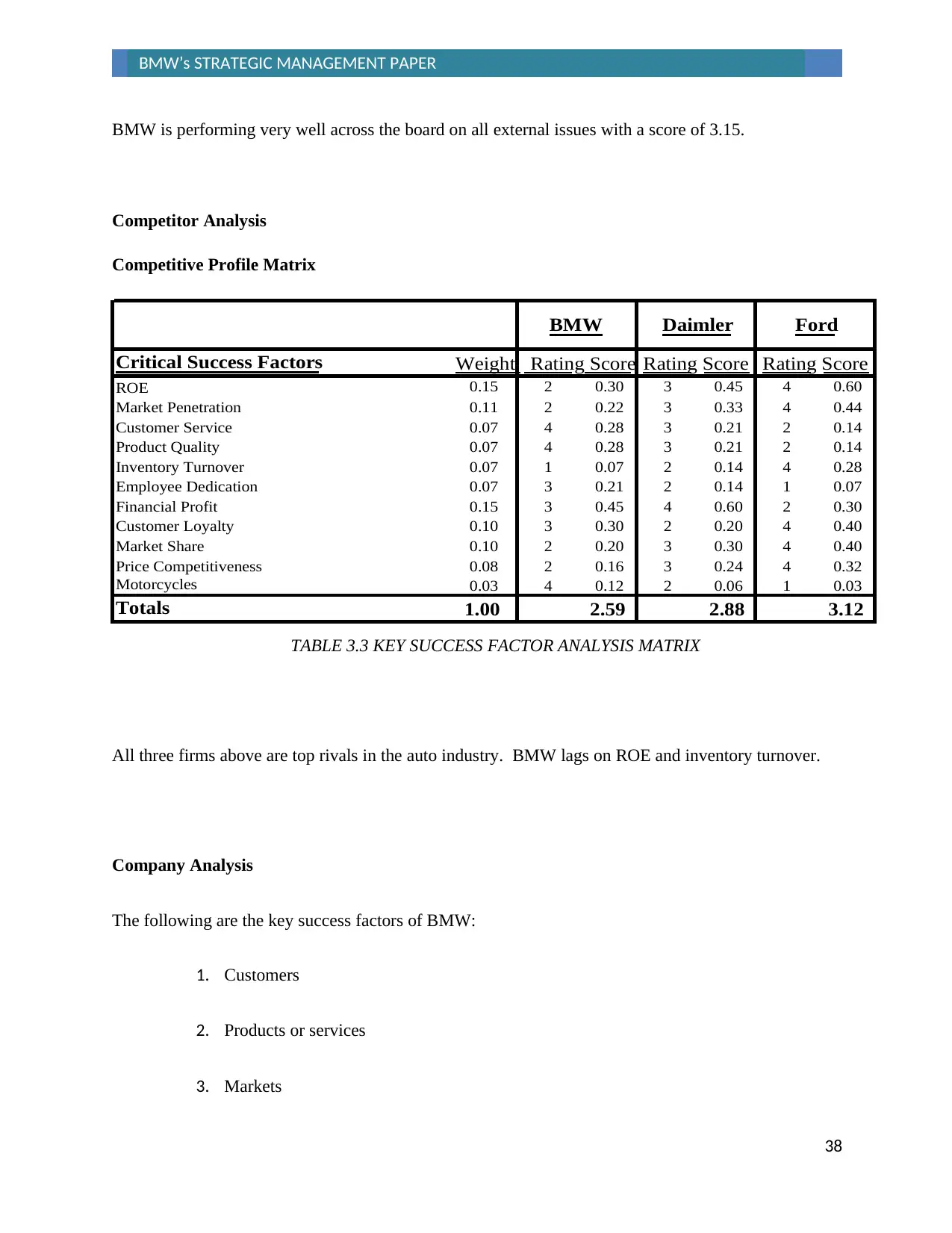
38
BMW’s STRATEGIC MANAGEMENT PAPER
Weight Rating Score Rating Score Rating Score
0.15 2 0.30 3 0.45 4 0.60
0.11 2 0.22 3 0.33 4 0.44
0.07 4 0.28 3 0.21 2 0.14
0.07 4 0.28 3 0.21 2 0.14
0.07 1 0.07 2 0.14 4 0.28
0.07 3 0.21 2 0.14 1 0.07
0.15 3 0.45 4 0.60 2 0.30
0.10 3 0.30 2 0.20 4 0.40
0.10 2 0.20 3 0.30 4 0.40
0.08 2 0.16 3 0.24 4 0.32
0.03 4 0.12 2 0.06 1 0.03
1.00 2.59 2.88 3.12
Financial Profit
ROE
Market Penetration
Customer Service
Product Quality
Inventory Turnover
Totals
Customer Loyalty
Market Share
Price Competitiveness
Motorcycles
Critical Success Factors
BMW Daimler Ford
Employee Dedication
BMW is performing very well across the board on all external issues with a score of 3.15.
Competitor Analysis
Competitive Profile Matrix
TABLE 3.3 KEY SUCCESS FACTOR ANALYSIS MATRIX
All three firms above are top rivals in the auto industry. BMW lags on ROE and inventory turnover.
Company Analysis
The following are the key success factors of BMW:
1. Customers
2. Products or services
3. Markets
BMW’s STRATEGIC MANAGEMENT PAPER
Weight Rating Score Rating Score Rating Score
0.15 2 0.30 3 0.45 4 0.60
0.11 2 0.22 3 0.33 4 0.44
0.07 4 0.28 3 0.21 2 0.14
0.07 4 0.28 3 0.21 2 0.14
0.07 1 0.07 2 0.14 4 0.28
0.07 3 0.21 2 0.14 1 0.07
0.15 3 0.45 4 0.60 2 0.30
0.10 3 0.30 2 0.20 4 0.40
0.10 2 0.20 3 0.30 4 0.40
0.08 2 0.16 3 0.24 4 0.32
0.03 4 0.12 2 0.06 1 0.03
1.00 2.59 2.88 3.12
Financial Profit
ROE
Market Penetration
Customer Service
Product Quality
Inventory Turnover
Totals
Customer Loyalty
Market Share
Price Competitiveness
Motorcycles
Critical Success Factors
BMW Daimler Ford
Employee Dedication
BMW is performing very well across the board on all external issues with a score of 3.15.
Competitor Analysis
Competitive Profile Matrix
TABLE 3.3 KEY SUCCESS FACTOR ANALYSIS MATRIX
All three firms above are top rivals in the auto industry. BMW lags on ROE and inventory turnover.
Company Analysis
The following are the key success factors of BMW:
1. Customers
2. Products or services
3. Markets
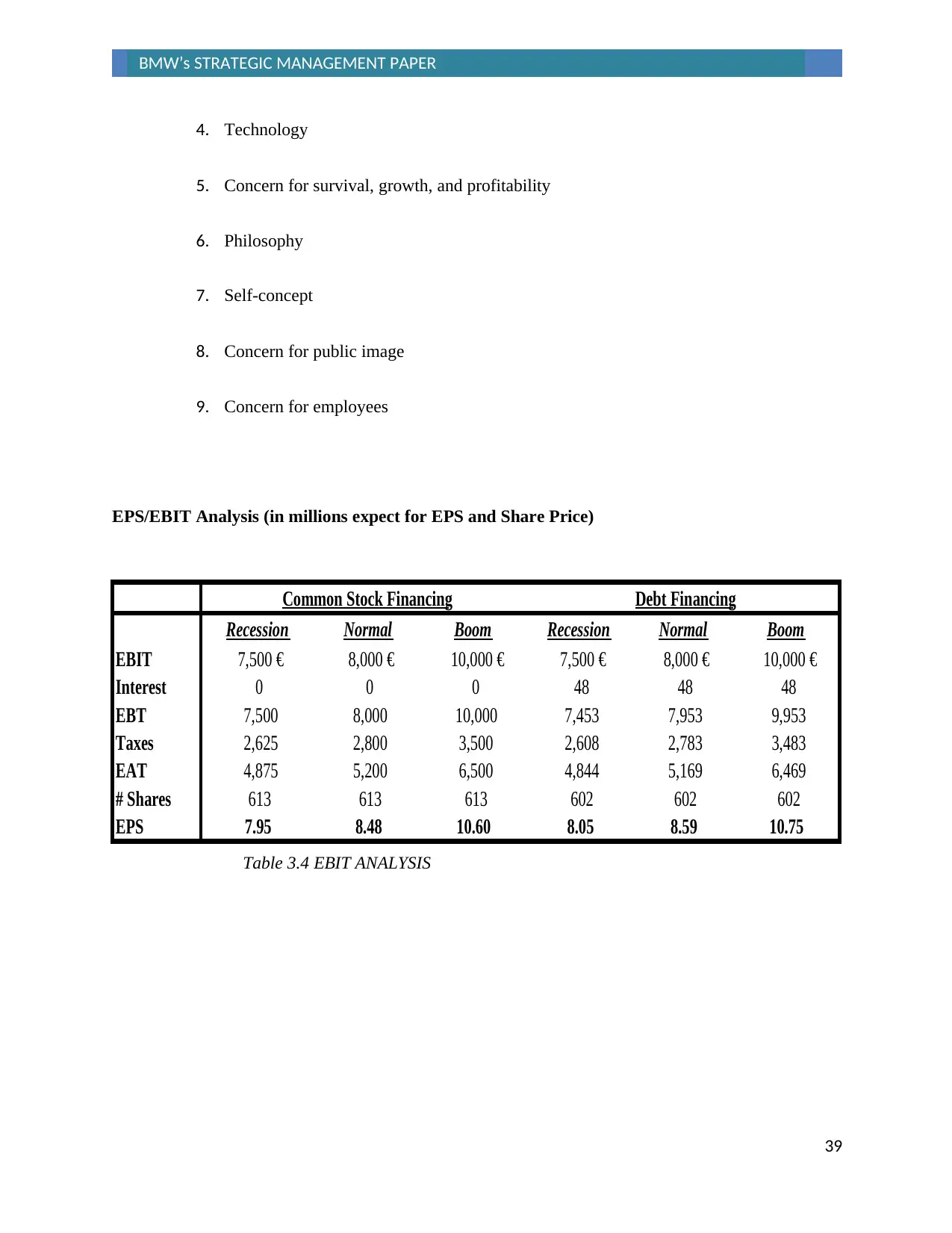
39
BMW’s STRATEGIC MANAGEMENT PAPER
Recession Normal Boom Recession Normal Boom
EBIT 7,500 € 8,000 € 10,000 € 7,500 € 8,000 € 10,000 €
Interest 0 0 0 48 48 48
EBT 7,500 8,000 10,000 7,453 7,953 9,953
Taxes 2,625 2,800 3,500 2,608 2,783 3,483
EAT 4,875 5,200 6,500 4,844 5,169 6,469
# Shares 613 613 613 602 602 602
EPS 7.95 8.48 10.60 8.05 8.59 10.75
Common Stock Financing Debt Financing
4. Technology
5. Concern for survival, growth, and profitability
6. Philosophy
7. Self-concept
8. Concern for public image
9. Concern for employees
EPS/EBIT Analysis (in millions expect for EPS and Share Price)
Table 3.4 EBIT ANALYSIS
BMW’s STRATEGIC MANAGEMENT PAPER
Recession Normal Boom Recession Normal Boom
EBIT 7,500 € 8,000 € 10,000 € 7,500 € 8,000 € 10,000 €
Interest 0 0 0 48 48 48
EBT 7,500 8,000 10,000 7,453 7,953 9,953
Taxes 2,625 2,800 3,500 2,608 2,783 3,483
EAT 4,875 5,200 6,500 4,844 5,169 6,469
# Shares 613 613 613 602 602 602
EPS 7.95 8.48 10.60 8.05 8.59 10.75
Common Stock Financing Debt Financing
4. Technology
5. Concern for survival, growth, and profitability
6. Philosophy
7. Self-concept
8. Concern for public image
9. Concern for employees
EPS/EBIT Analysis (in millions expect for EPS and Share Price)
Table 3.4 EBIT ANALYSIS
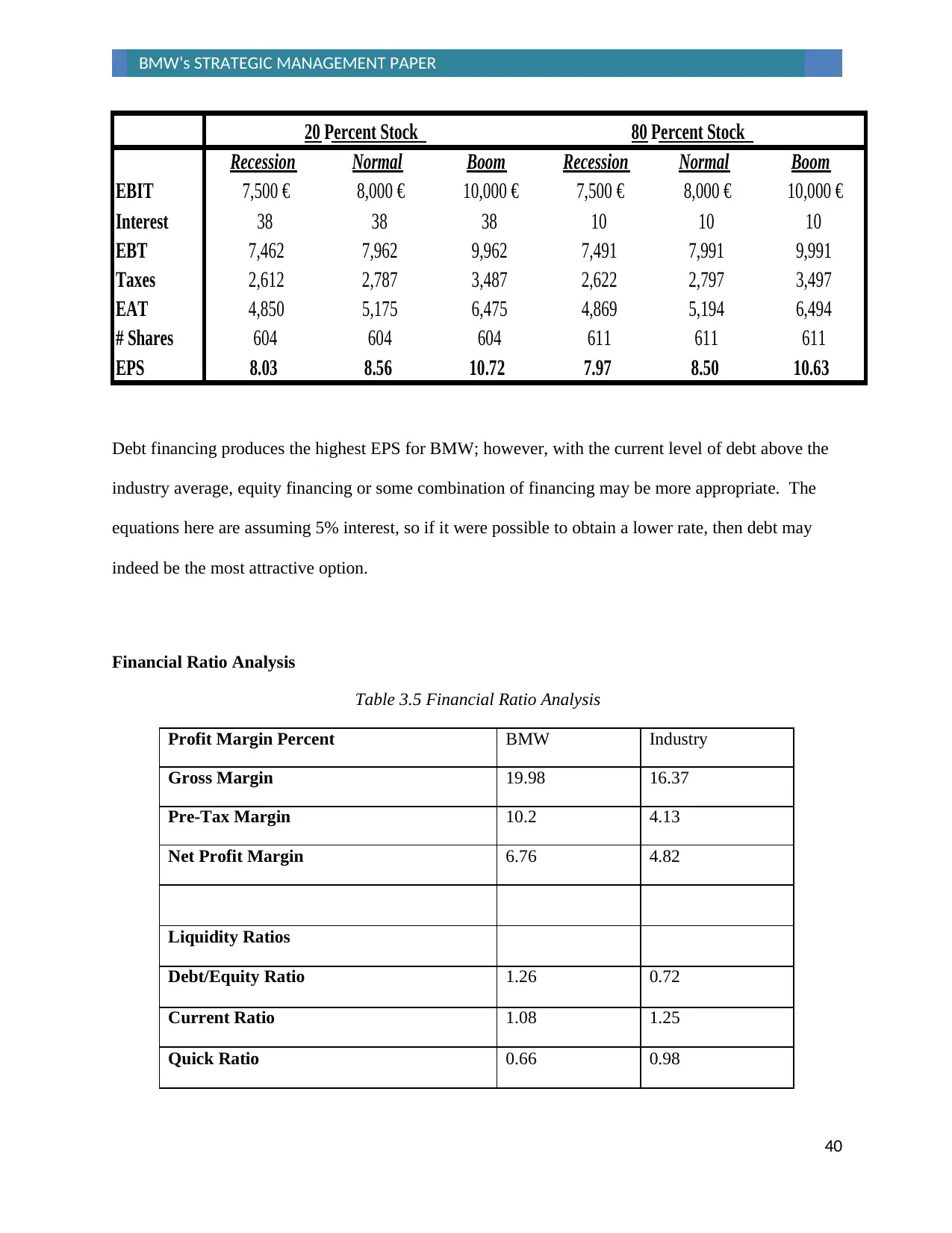
40
BMW’s STRATEGIC MANAGEMENT PAPER
20 Percent Stock 80 Percent Stock
Recession Normal Boom Recession Normal Boom
EBIT 7,500 € 8,000 € 10,000 € 7,500 € 8,000 € 10,000 €
Interest 38 38 38 10 10 10
EBT 7,462 7,962 9,962 7,491 7,991 9,991
Taxes 2,612 2,787 3,487 2,622 2,797 3,497
EAT 4,850 5,175 6,475 4,869 5,194 6,494
# Shares 604 604 604 611 611 611
EPS 8.03 8.56 10.72 7.97 8.50 10.63
Debt financing produces the highest EPS for BMW; however, with the current level of debt above the
industry average, equity financing or some combination of financing may be more appropriate. The
equations here are assuming 5% interest, so if it were possible to obtain a lower rate, then debt may
indeed be the most attractive option.
Financial Ratio Analysis
Table 3.5 Financial Ratio Analysis
Profit Margin Percent BMW Industry
Gross Margin 19.98 16.37
Pre-Tax Margin 10.2 4.13
Net Profit Margin 6.76 4.82
Liquidity Ratios
Debt/Equity Ratio 1.26 0.72
Current Ratio 1.08 1.25
Quick Ratio 0.66 0.98
BMW’s STRATEGIC MANAGEMENT PAPER
20 Percent Stock 80 Percent Stock
Recession Normal Boom Recession Normal Boom
EBIT 7,500 € 8,000 € 10,000 € 7,500 € 8,000 € 10,000 €
Interest 38 38 38 10 10 10
EBT 7,462 7,962 9,962 7,491 7,991 9,991
Taxes 2,612 2,787 3,487 2,622 2,797 3,497
EAT 4,850 5,175 6,475 4,869 5,194 6,494
# Shares 604 604 604 611 611 611
EPS 8.03 8.56 10.72 7.97 8.50 10.63
Debt financing produces the highest EPS for BMW; however, with the current level of debt above the
industry average, equity financing or some combination of financing may be more appropriate. The
equations here are assuming 5% interest, so if it were possible to obtain a lower rate, then debt may
indeed be the most attractive option.
Financial Ratio Analysis
Table 3.5 Financial Ratio Analysis
Profit Margin Percent BMW Industry
Gross Margin 19.98 16.37
Pre-Tax Margin 10.2 4.13
Net Profit Margin 6.76 4.82
Liquidity Ratios
Debt/Equity Ratio 1.26 0.72
Current Ratio 1.08 1.25
Quick Ratio 0.66 0.98
Secure Best Marks with AI Grader
Need help grading? Try our AI Grader for instant feedback on your assignments.
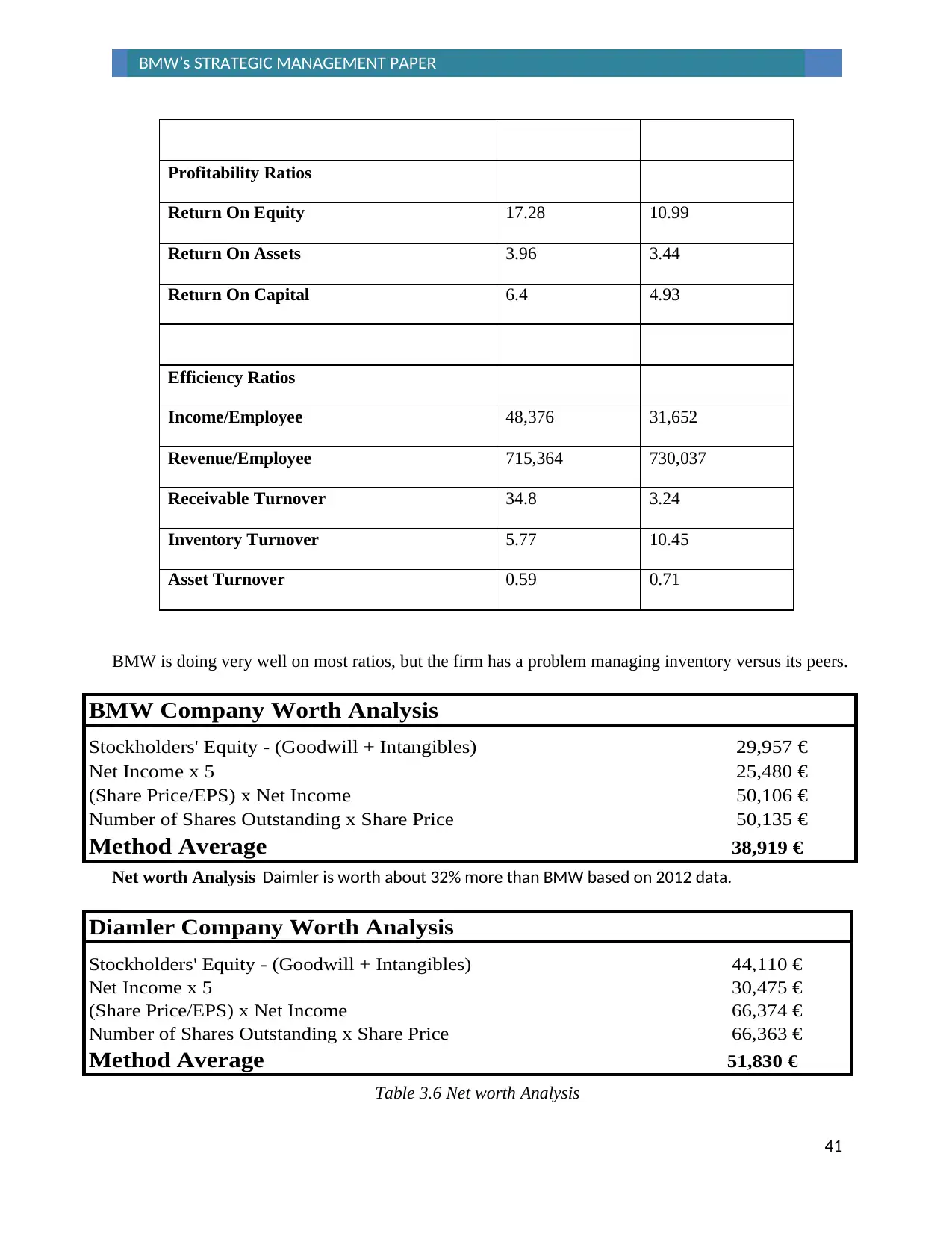
41
BMW’s STRATEGIC MANAGEMENT PAPER
BMW Company Worth Analysis
Stockholders' Equity - (Goodwill + Intangibles) 29,957 €
Net Income x 5 25,480 €
(Share Price/EPS) x Net Income 50,106 €
Number of Shares Outstanding x Share Price 50,135 €
Method Average 38,919 €
Diamler Company Worth Analysis
Stockholders' Equity - (Goodwill + Intangibles) 44,110 €
Net Income x 5 30,475 €
(Share Price/EPS) x Net Income 66,374 €
Number of Shares Outstanding x Share Price 66,363 €
Method Average 51,830 €
Profitability Ratios
Return On Equity 17.28 10.99
Return On Assets 3.96 3.44
Return On Capital 6.4 4.93
Efficiency Ratios
Income/Employee 48,376 31,652
Revenue/Employee 715,364 730,037
Receivable Turnover 34.8 3.24
Inventory Turnover 5.77 10.45
Asset Turnover 0.59 0.71
BMW is doing very well on most ratios, but the firm has a problem managing inventory versus its peers.
Net worth Analysis Daimler is worth about 32% more than BMW based on 2012 data.
Table 3.6 Net worth Analysis
BMW’s STRATEGIC MANAGEMENT PAPER
BMW Company Worth Analysis
Stockholders' Equity - (Goodwill + Intangibles) 29,957 €
Net Income x 5 25,480 €
(Share Price/EPS) x Net Income 50,106 €
Number of Shares Outstanding x Share Price 50,135 €
Method Average 38,919 €
Diamler Company Worth Analysis
Stockholders' Equity - (Goodwill + Intangibles) 44,110 €
Net Income x 5 30,475 €
(Share Price/EPS) x Net Income 66,374 €
Number of Shares Outstanding x Share Price 66,363 €
Method Average 51,830 €
Profitability Ratios
Return On Equity 17.28 10.99
Return On Assets 3.96 3.44
Return On Capital 6.4 4.93
Efficiency Ratios
Income/Employee 48,376 31,652
Revenue/Employee 715,364 730,037
Receivable Turnover 34.8 3.24
Inventory Turnover 5.77 10.45
Asset Turnover 0.59 0.71
BMW is doing very well on most ratios, but the firm has a problem managing inventory versus its peers.
Net worth Analysis Daimler is worth about 32% more than BMW based on 2012 data.
Table 3.6 Net worth Analysis
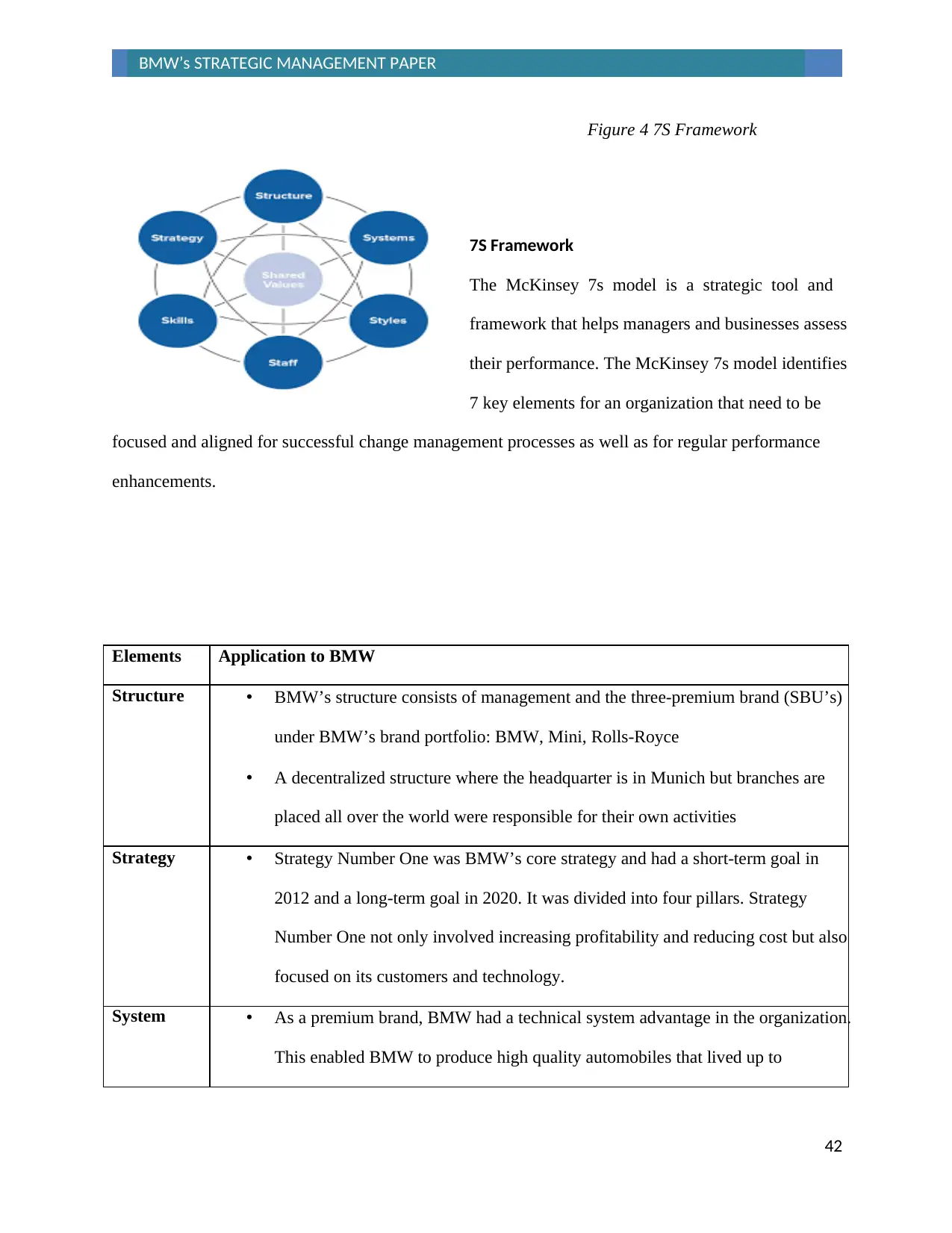
42
BMW’s STRATEGIC MANAGEMENT PAPER
Figure 4 7S Framework
7S Framework
The McKinsey 7s model is a strategic tool and
framework that helps managers and businesses assess
their performance. The McKinsey 7s model identifies
7 key elements for an organization that need to be
focused and aligned for successful change management processes as well as for regular performance
enhancements.
Elements Application to BMW
Structure • BMW’s structure consists of management and the three-premium brand (SBU’s)
under BMW’s brand portfolio: BMW, Mini, Rolls-Royce
• A decentralized structure where the headquarter is in Munich but branches are
placed all over the world were responsible for their own activities
Strategy • Strategy Number One was BMW’s core strategy and had a short-term goal in
2012 and a long-term goal in 2020. It was divided into four pillars. Strategy
Number One not only involved increasing profitability and reducing cost but also
focused on its customers and technology.
System • As a premium brand, BMW had a technical system advantage in the organization.
This enabled BMW to produce high quality automobiles that lived up to
BMW’s STRATEGIC MANAGEMENT PAPER
Figure 4 7S Framework
7S Framework
The McKinsey 7s model is a strategic tool and
framework that helps managers and businesses assess
their performance. The McKinsey 7s model identifies
7 key elements for an organization that need to be
focused and aligned for successful change management processes as well as for regular performance
enhancements.
Elements Application to BMW
Structure • BMW’s structure consists of management and the three-premium brand (SBU’s)
under BMW’s brand portfolio: BMW, Mini, Rolls-Royce
• A decentralized structure where the headquarter is in Munich but branches are
placed all over the world were responsible for their own activities
Strategy • Strategy Number One was BMW’s core strategy and had a short-term goal in
2012 and a long-term goal in 2020. It was divided into four pillars. Strategy
Number One not only involved increasing profitability and reducing cost but also
focused on its customers and technology.
System • As a premium brand, BMW had a technical system advantage in the organization.
This enabled BMW to produce high quality automobiles that lived up to
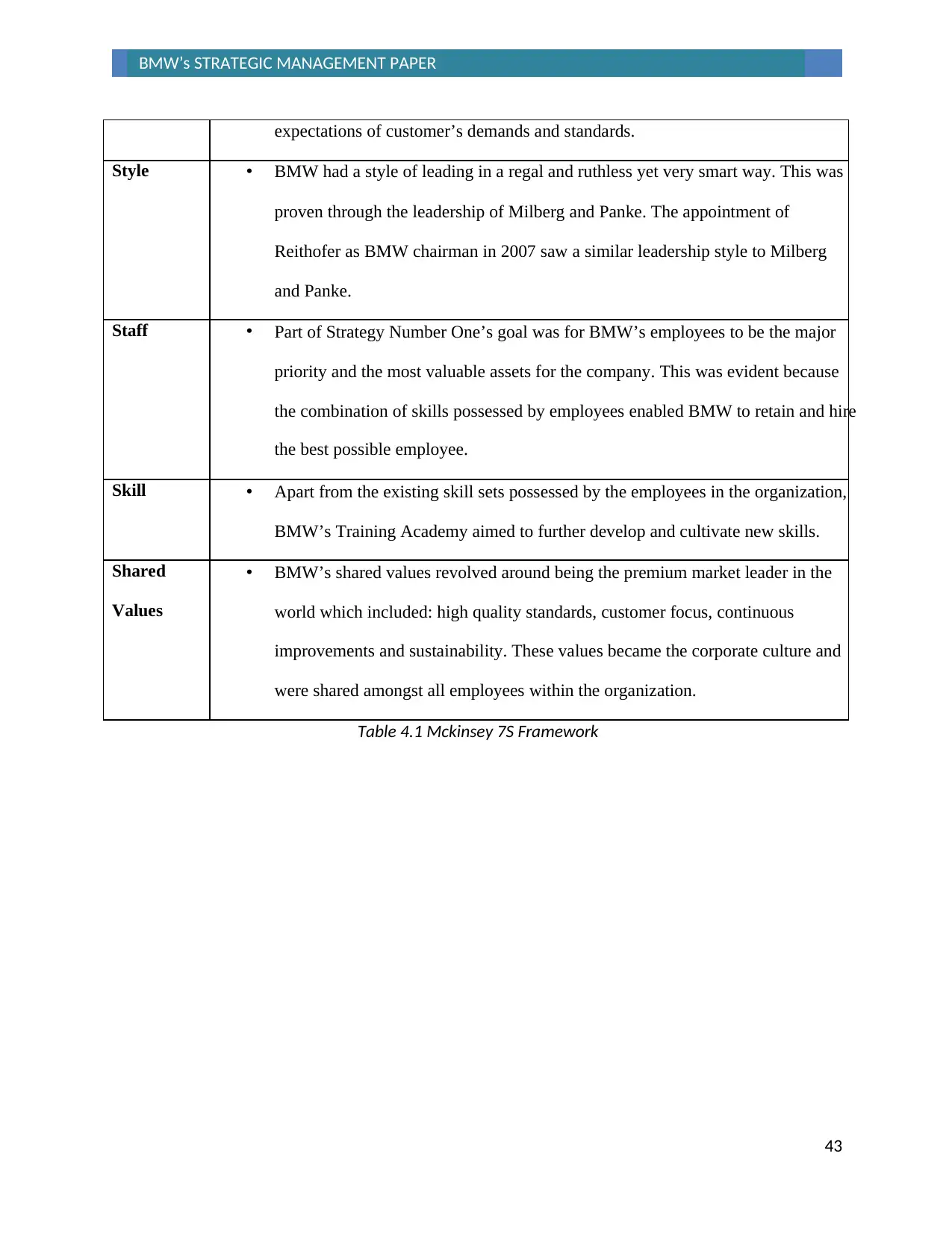
43
BMW’s STRATEGIC MANAGEMENT PAPER
expectations of customer’s demands and standards.
Style • BMW had a style of leading in a regal and ruthless yet very smart way. This was
proven through the leadership of Milberg and Panke. The appointment of
Reithofer as BMW chairman in 2007 saw a similar leadership style to Milberg
and Panke.
Staff • Part of Strategy Number One’s goal was for BMW’s employees to be the major
priority and the most valuable assets for the company. This was evident because
the combination of skills possessed by employees enabled BMW to retain and hire
the best possible employee.
Skill • Apart from the existing skill sets possessed by the employees in the organization,
BMW’s Training Academy aimed to further develop and cultivate new skills.
Shared
Values
• BMW’s shared values revolved around being the premium market leader in the
world which included: high quality standards, customer focus, continuous
improvements and sustainability. These values became the corporate culture and
were shared amongst all employees within the organization.
Table 4.1 Mckinsey 7S Framework
BMW’s STRATEGIC MANAGEMENT PAPER
expectations of customer’s demands and standards.
Style • BMW had a style of leading in a regal and ruthless yet very smart way. This was
proven through the leadership of Milberg and Panke. The appointment of
Reithofer as BMW chairman in 2007 saw a similar leadership style to Milberg
and Panke.
Staff • Part of Strategy Number One’s goal was for BMW’s employees to be the major
priority and the most valuable assets for the company. This was evident because
the combination of skills possessed by employees enabled BMW to retain and hire
the best possible employee.
Skill • Apart from the existing skill sets possessed by the employees in the organization,
BMW’s Training Academy aimed to further develop and cultivate new skills.
Shared
Values
• BMW’s shared values revolved around being the premium market leader in the
world which included: high quality standards, customer focus, continuous
improvements and sustainability. These values became the corporate culture and
were shared amongst all employees within the organization.
Table 4.1 Mckinsey 7S Framework
Paraphrase This Document
Need a fresh take? Get an instant paraphrase of this document with our AI Paraphraser
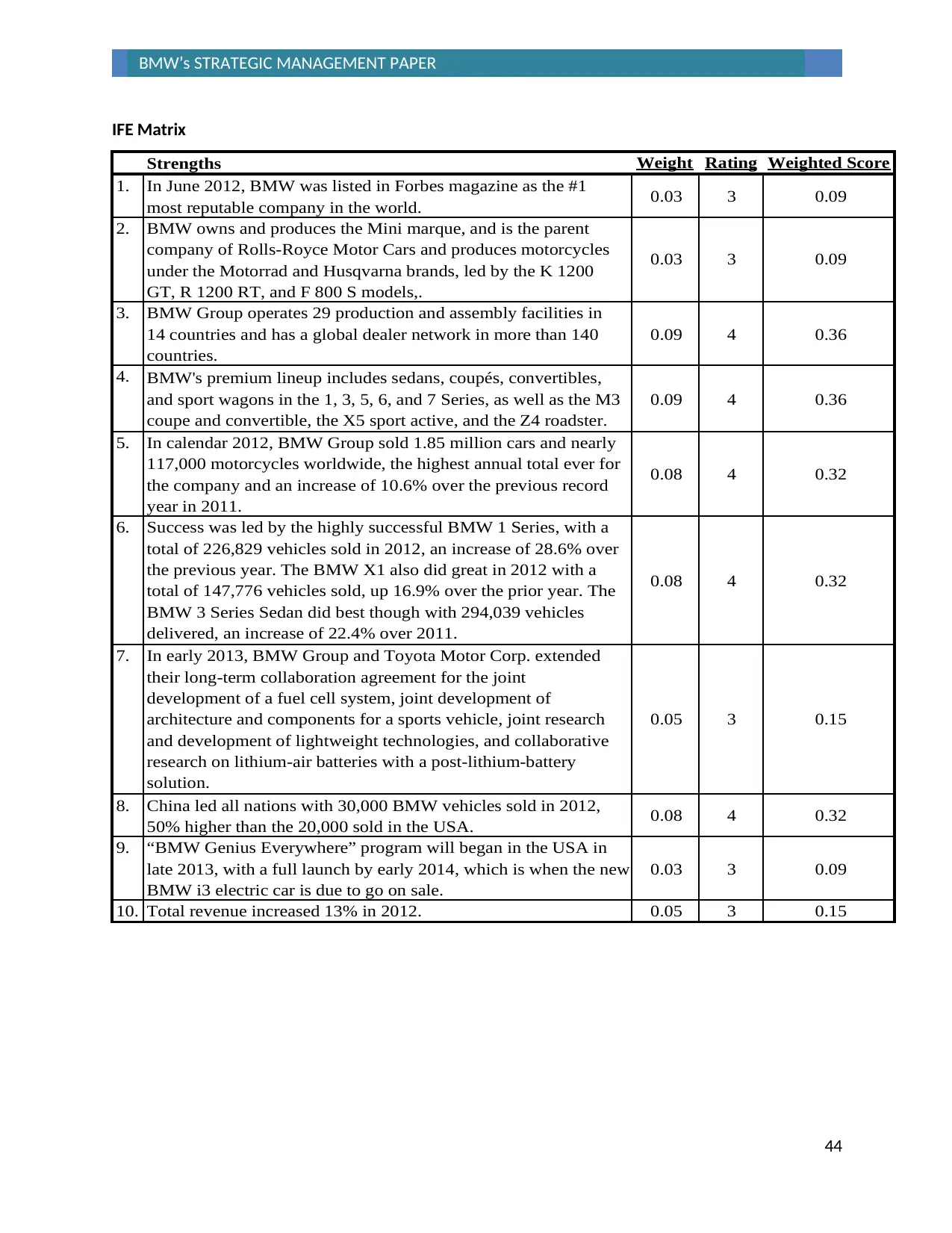
44
BMW’s STRATEGIC MANAGEMENT PAPER
Strengths Weight Rating Weighted Score
1. In June 2012, BMW was listed in Forbes magazine as the #1
most reputable company in the world. 0.03 3 0.09
2. BMW owns and produces the Mini marque, and is the parent
company of Rolls-Royce Motor Cars and produces motorcycles
under the Motorrad and Husqvarna brands, led by the K 1200
GT, R 1200 RT, and F 800 S models,.
0.03 3 0.09
3. BMW Group operates 29 production and assembly facilities in
14 countries and has a global dealer network in more than 140
countries.
0.09 4 0.36
4. BMW's premium lineup includes sedans, coupés, convertibles,
and sport wagons in the 1, 3, 5, 6, and 7 Series, as well as the M3
coupe and convertible, the X5 sport active, and the Z4 roadster.
0.09 4 0.36
5. In calendar 2012, BMW Group sold 1.85 million cars and nearly
117,000 motorcycles worldwide, the highest annual total ever for
the company and an increase of 10.6% over the previous record
year in 2011.
0.08 4 0.32
6. Success was led by the highly successful BMW 1 Series, with a
total of 226,829 vehicles sold in 2012, an increase of 28.6% over
the previous year. The BMW X1 also did great in 2012 with a
total of 147,776 vehicles sold, up 16.9% over the prior year. The
BMW 3 Series Sedan did best though with 294,039 vehicles
delivered, an increase of 22.4% over 2011.
0.08 4 0.32
7. In early 2013, BMW Group and Toyota Motor Corp. extended
their long-term collaboration agreement for the joint
development of a fuel cell system, joint development of
architecture and components for a sports vehicle, joint research
and development of lightweight technologies, and collaborative
research on lithium-air batteries with a post-lithium-battery
solution.
0.05 3 0.15
8. China led all nations with 30,000 BMW vehicles sold in 2012,
50% higher than the 20,000 sold in the USA. 0.08 4 0.32
9. “BMW Genius Everywhere” program will began in the USA in
late 2013, with a full launch by early 2014, which is when the new
BMW i3 electric car is due to go on sale.
0.03 3 0.09
10. Total revenue increased 13% in 2012. 0.05 3 0.15
IFE Matrix
BMW’s STRATEGIC MANAGEMENT PAPER
Strengths Weight Rating Weighted Score
1. In June 2012, BMW was listed in Forbes magazine as the #1
most reputable company in the world. 0.03 3 0.09
2. BMW owns and produces the Mini marque, and is the parent
company of Rolls-Royce Motor Cars and produces motorcycles
under the Motorrad and Husqvarna brands, led by the K 1200
GT, R 1200 RT, and F 800 S models,.
0.03 3 0.09
3. BMW Group operates 29 production and assembly facilities in
14 countries and has a global dealer network in more than 140
countries.
0.09 4 0.36
4. BMW's premium lineup includes sedans, coupés, convertibles,
and sport wagons in the 1, 3, 5, 6, and 7 Series, as well as the M3
coupe and convertible, the X5 sport active, and the Z4 roadster.
0.09 4 0.36
5. In calendar 2012, BMW Group sold 1.85 million cars and nearly
117,000 motorcycles worldwide, the highest annual total ever for
the company and an increase of 10.6% over the previous record
year in 2011.
0.08 4 0.32
6. Success was led by the highly successful BMW 1 Series, with a
total of 226,829 vehicles sold in 2012, an increase of 28.6% over
the previous year. The BMW X1 also did great in 2012 with a
total of 147,776 vehicles sold, up 16.9% over the prior year. The
BMW 3 Series Sedan did best though with 294,039 vehicles
delivered, an increase of 22.4% over 2011.
0.08 4 0.32
7. In early 2013, BMW Group and Toyota Motor Corp. extended
their long-term collaboration agreement for the joint
development of a fuel cell system, joint development of
architecture and components for a sports vehicle, joint research
and development of lightweight technologies, and collaborative
research on lithium-air batteries with a post-lithium-battery
solution.
0.05 3 0.15
8. China led all nations with 30,000 BMW vehicles sold in 2012,
50% higher than the 20,000 sold in the USA. 0.08 4 0.32
9. “BMW Genius Everywhere” program will began in the USA in
late 2013, with a full launch by early 2014, which is when the new
BMW i3 electric car is due to go on sale.
0.03 3 0.09
10. Total revenue increased 13% in 2012. 0.05 3 0.15
IFE Matrix
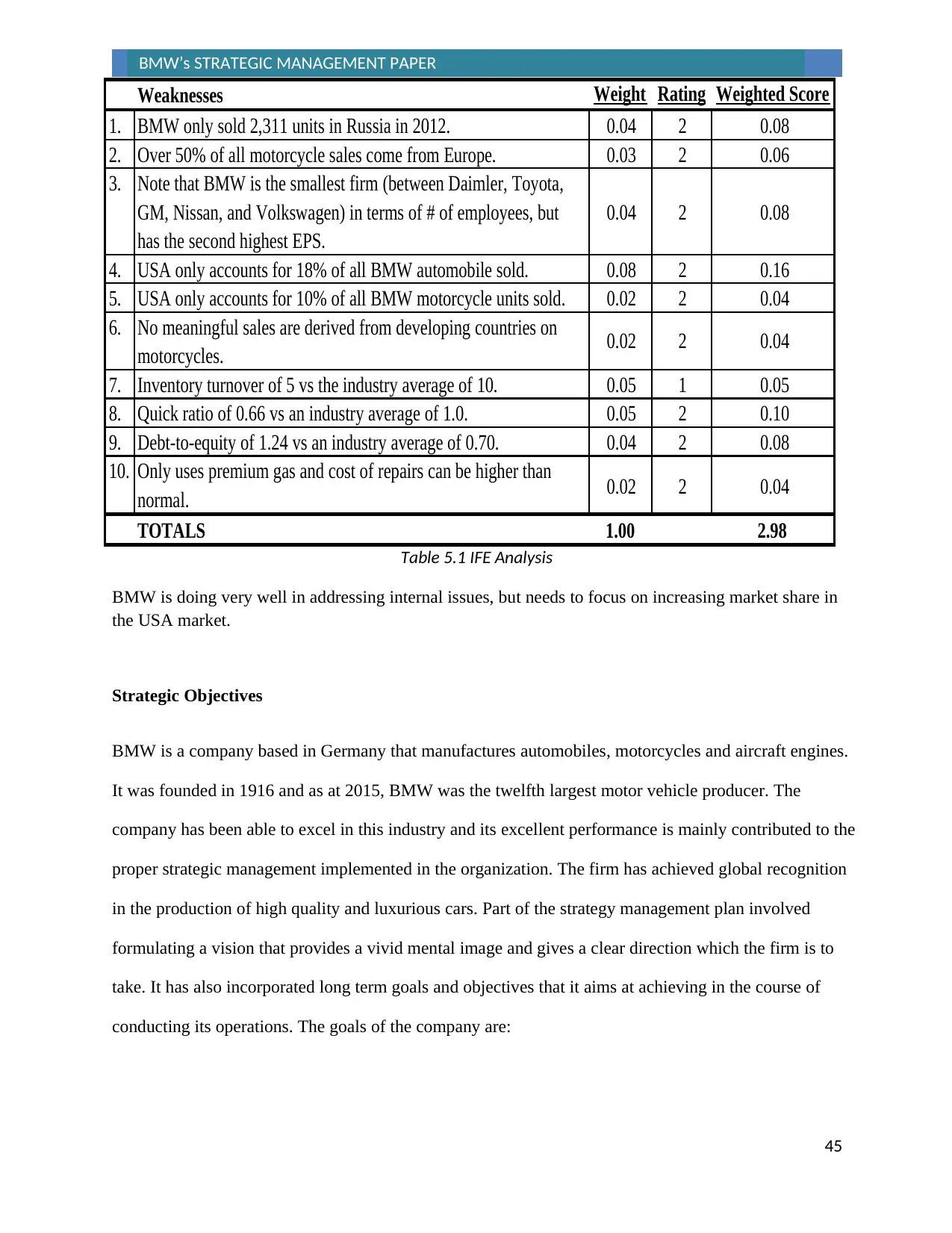
45
BMW’s STRATEGIC MANAGEMENT PAPER
Table 5.1 IFE Analysis
BMW is doing very well in addressing internal issues, but needs to focus on increasing market share in
the USA market.
Strategic Objectives
BMW is a company based in Germany that manufactures automobiles, motorcycles and aircraft engines.
It was founded in 1916 and as at 2015, BMW was the twelfth largest motor vehicle producer. The
company has been able to excel in this industry and its excellent performance is mainly contributed to the
proper strategic management implemented in the organization. The firm has achieved global recognition
in the production of high quality and luxurious cars. Part of the strategy management plan involved
formulating a vision that provides a vivid mental image and gives a clear direction which the firm is to
take. It has also incorporated long term goals and objectives that it aims at achieving in the course of
conducting its operations. The goals of the company are:
Weaknesses Weight Rating Weighted Score
1. BMW only sold 2,311 units in Russia in 2012. 0.04 2 0.08
2. Over 50% of all motorcycle sales come from Europe. 0.03 2 0.06
3. Note that BMW is the smallest firm (between Daimler, Toyota,
GM, Nissan, and Volkswagen) in terms of # of employees, but
has the second highest EPS.
0.04 2 0.08
4. USA only accounts for 18% of all BMW automobile sold. 0.08 2 0.16
5. USA only accounts for 10% of all BMW motorcycle units sold. 0.02 2 0.04
6. No meaningful sales are derived from developing countries on
motorcycles. 0.02 2 0.04
7. Inventory turnover of 5 vs the industry average of 10. 0.05 1 0.05
8. Quick ratio of 0.66 vs an industry average of 1.0. 0.05 2 0.10
9. Debt-to-equity of 1.24 vs an industry average of 0.70. 0.04 2 0.08
10. Only uses premium gas and cost of repairs can be higher than
normal. 0.02 2 0.04
TOTALS 1.00 2.98
BMW’s STRATEGIC MANAGEMENT PAPER
Table 5.1 IFE Analysis
BMW is doing very well in addressing internal issues, but needs to focus on increasing market share in
the USA market.
Strategic Objectives
BMW is a company based in Germany that manufactures automobiles, motorcycles and aircraft engines.
It was founded in 1916 and as at 2015, BMW was the twelfth largest motor vehicle producer. The
company has been able to excel in this industry and its excellent performance is mainly contributed to the
proper strategic management implemented in the organization. The firm has achieved global recognition
in the production of high quality and luxurious cars. Part of the strategy management plan involved
formulating a vision that provides a vivid mental image and gives a clear direction which the firm is to
take. It has also incorporated long term goals and objectives that it aims at achieving in the course of
conducting its operations. The goals of the company are:
Weaknesses Weight Rating Weighted Score
1. BMW only sold 2,311 units in Russia in 2012. 0.04 2 0.08
2. Over 50% of all motorcycle sales come from Europe. 0.03 2 0.06
3. Note that BMW is the smallest firm (between Daimler, Toyota,
GM, Nissan, and Volkswagen) in terms of # of employees, but
has the second highest EPS.
0.04 2 0.08
4. USA only accounts for 18% of all BMW automobile sold. 0.08 2 0.16
5. USA only accounts for 10% of all BMW motorcycle units sold. 0.02 2 0.04
6. No meaningful sales are derived from developing countries on
motorcycles. 0.02 2 0.04
7. Inventory turnover of 5 vs the industry average of 10. 0.05 1 0.05
8. Quick ratio of 0.66 vs an industry average of 1.0. 0.05 2 0.10
9. Debt-to-equity of 1.24 vs an industry average of 0.70. 0.04 2 0.08
10. Only uses premium gas and cost of repairs can be higher than
normal. 0.02 2 0.04
TOTALS 1.00 2.98
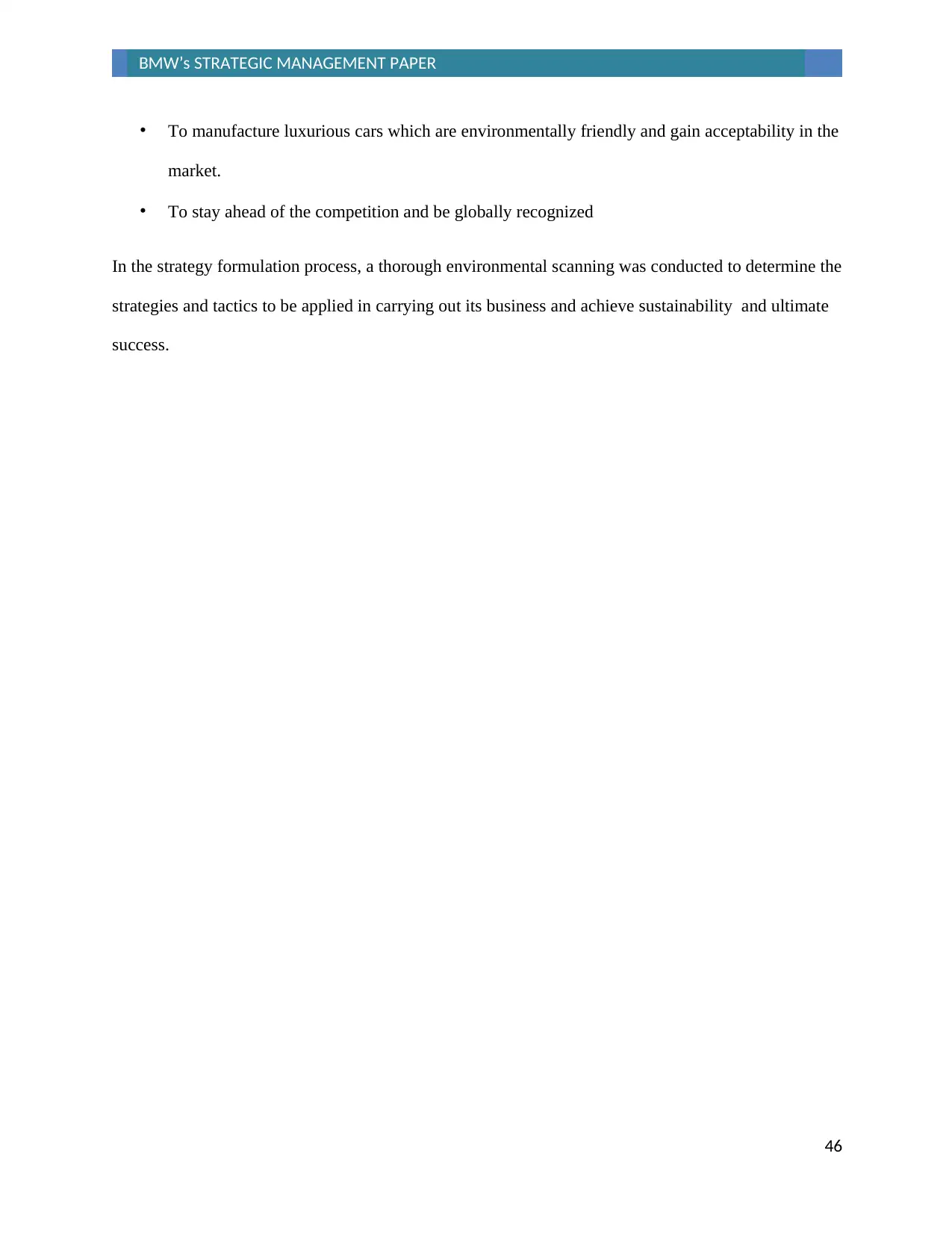
46
BMW’s STRATEGIC MANAGEMENT PAPER
• To manufacture luxurious cars which are environmentally friendly and gain acceptability in the
market.
• To stay ahead of the competition and be globally recognized
In the strategy formulation process, a thorough environmental scanning was conducted to determine the
strategies and tactics to be applied in carrying out its business and achieve sustainability and ultimate
success.
BMW’s STRATEGIC MANAGEMENT PAPER
• To manufacture luxurious cars which are environmentally friendly and gain acceptability in the
market.
• To stay ahead of the competition and be globally recognized
In the strategy formulation process, a thorough environmental scanning was conducted to determine the
strategies and tactics to be applied in carrying out its business and achieve sustainability and ultimate
success.
Secure Best Marks with AI Grader
Need help grading? Try our AI Grader for instant feedback on your assignments.
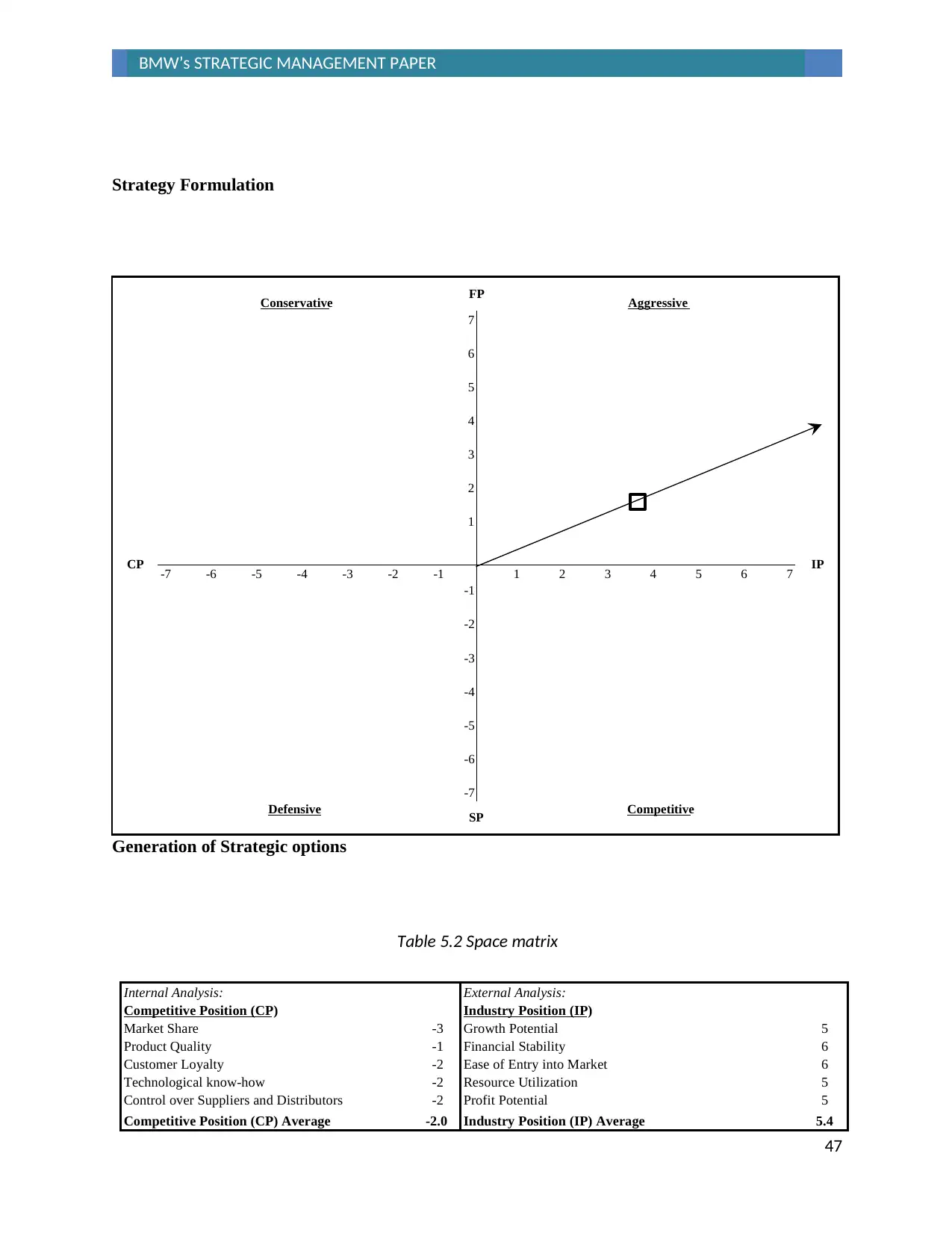
47
BMW’s STRATEGIC MANAGEMENT PAPER
7
6
5
4
3
2
1
-7 -6 -5 -4 -3 -2 -1 1 2 3 4 5 6 7
-1
-2
-3
-4
-5
-6
-7
CP
Defensive
AggressiveConservative FP
Competitive
SP
IP
Internal Analysis: External Analysis:
Competitive Position (CP) Industry Position (IP)
-3 5
-1 6
-2 6
-2 5
-2 5
Competitive Position (CP) Average -2.0 Industry Position (IP) Average 5.4
Growth Potential
Financial Stability
Ease of Entry into Market
Resource Utilization
Profit Potential
Market Share
Product Quality
Customer Loyalty
Technological know-how
Control over Suppliers and Distributors
Strategy Formulation
Generation of Strategic options
Table 5.2 Space matrix
BMW’s STRATEGIC MANAGEMENT PAPER
7
6
5
4
3
2
1
-7 -6 -5 -4 -3 -2 -1 1 2 3 4 5 6 7
-1
-2
-3
-4
-5
-6
-7
CP
Defensive
AggressiveConservative FP
Competitive
SP
IP
Internal Analysis: External Analysis:
Competitive Position (CP) Industry Position (IP)
-3 5
-1 6
-2 6
-2 5
-2 5
Competitive Position (CP) Average -2.0 Industry Position (IP) Average 5.4
Growth Potential
Financial Stability
Ease of Entry into Market
Resource Utilization
Profit Potential
Market Share
Product Quality
Customer Loyalty
Technological know-how
Control over Suppliers and Distributors
Strategy Formulation
Generation of Strategic options
Table 5.2 Space matrix
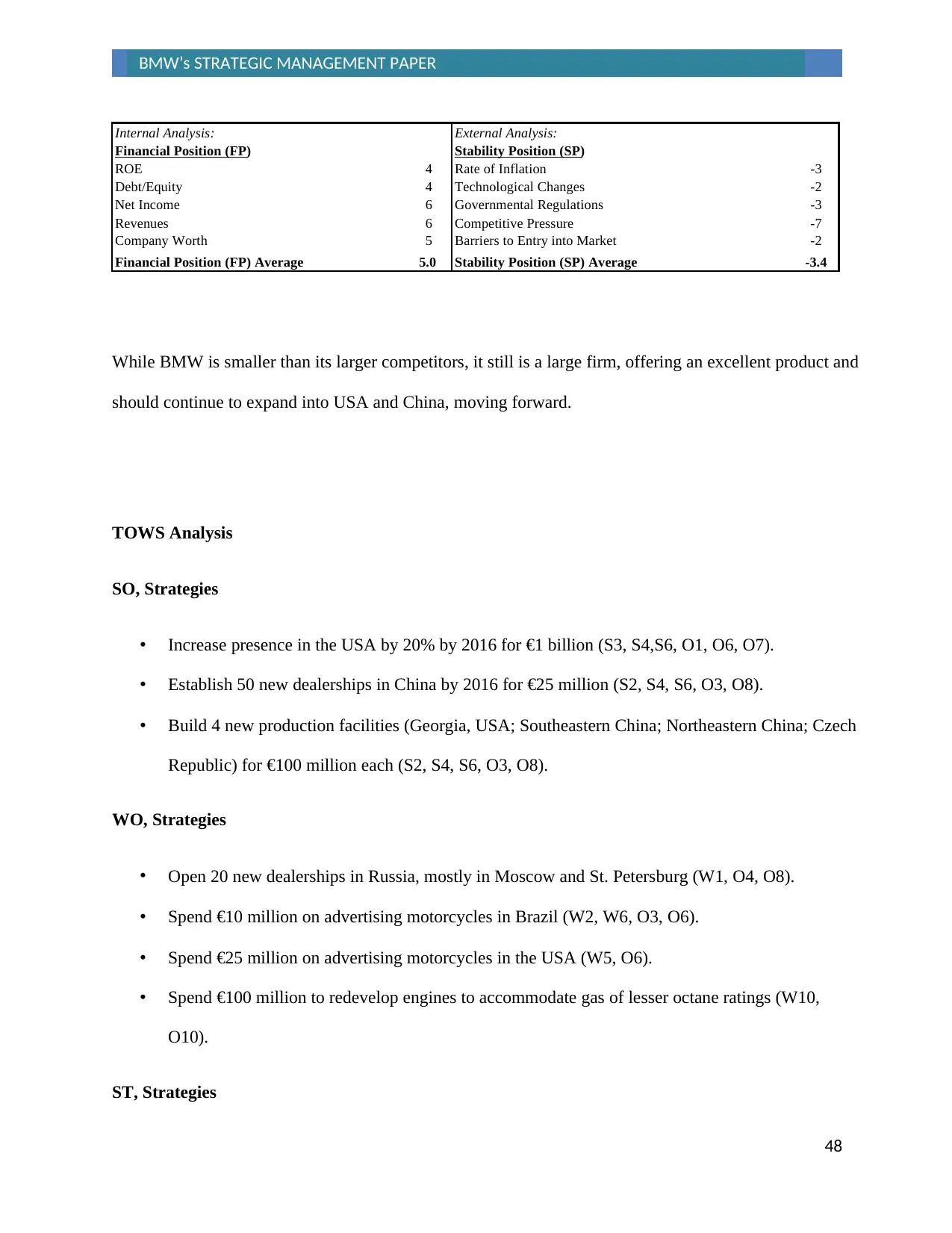
48
BMW’s STRATEGIC MANAGEMENT PAPER
While BMW is smaller than its larger competitors, it still is a large firm, offering an excellent product and
should continue to expand into USA and China, moving forward.
TOWS Analysis
SO, Strategies
• Increase presence in the USA by 20% by 2016 for €1 billion (S3, S4,S6, O1, O6, O7).
• Establish 50 new dealerships in China by 2016 for €25 million (S2, S4, S6, O3, O8).
• Build 4 new production facilities (Georgia, USA; Southeastern China; Northeastern China; Czech
Republic) for €100 million each (S2, S4, S6, O3, O8).
WO, Strategies
• Open 20 new dealerships in Russia, mostly in Moscow and St. Petersburg (W1, O4, O8).
• Spend €10 million on advertising motorcycles in Brazil (W2, W6, O3, O6).
• Spend €25 million on advertising motorcycles in the USA (W5, O6).
• Spend €100 million to redevelop engines to accommodate gas of lesser octane ratings (W10,
O10).
ST, Strategies
Internal Analysis: External Analysis:
Financial Position (FP) Stability Position (SP)
4 -3
4 -2
6 -3
6 -7
5 -2
Financial Position (FP) Average 5.0 Stability Position (SP) Average -3.4
ROE
Debt/Equity
Net Income
Revenues
Company Worth Barriers to Entry into Market
Rate of Inflation
Technological Changes
Governmental Regulations
Competitive Pressure
BMW’s STRATEGIC MANAGEMENT PAPER
While BMW is smaller than its larger competitors, it still is a large firm, offering an excellent product and
should continue to expand into USA and China, moving forward.
TOWS Analysis
SO, Strategies
• Increase presence in the USA by 20% by 2016 for €1 billion (S3, S4,S6, O1, O6, O7).
• Establish 50 new dealerships in China by 2016 for €25 million (S2, S4, S6, O3, O8).
• Build 4 new production facilities (Georgia, USA; Southeastern China; Northeastern China; Czech
Republic) for €100 million each (S2, S4, S6, O3, O8).
WO, Strategies
• Open 20 new dealerships in Russia, mostly in Moscow and St. Petersburg (W1, O4, O8).
• Spend €10 million on advertising motorcycles in Brazil (W2, W6, O3, O6).
• Spend €25 million on advertising motorcycles in the USA (W5, O6).
• Spend €100 million to redevelop engines to accommodate gas of lesser octane ratings (W10,
O10).
ST, Strategies
Internal Analysis: External Analysis:
Financial Position (FP) Stability Position (SP)
4 -3
4 -2
6 -3
6 -7
5 -2
Financial Position (FP) Average 5.0 Stability Position (SP) Average -3.4
ROE
Debt/Equity
Net Income
Revenues
Company Worth Barriers to Entry into Market
Rate of Inflation
Technological Changes
Governmental Regulations
Competitive Pressure
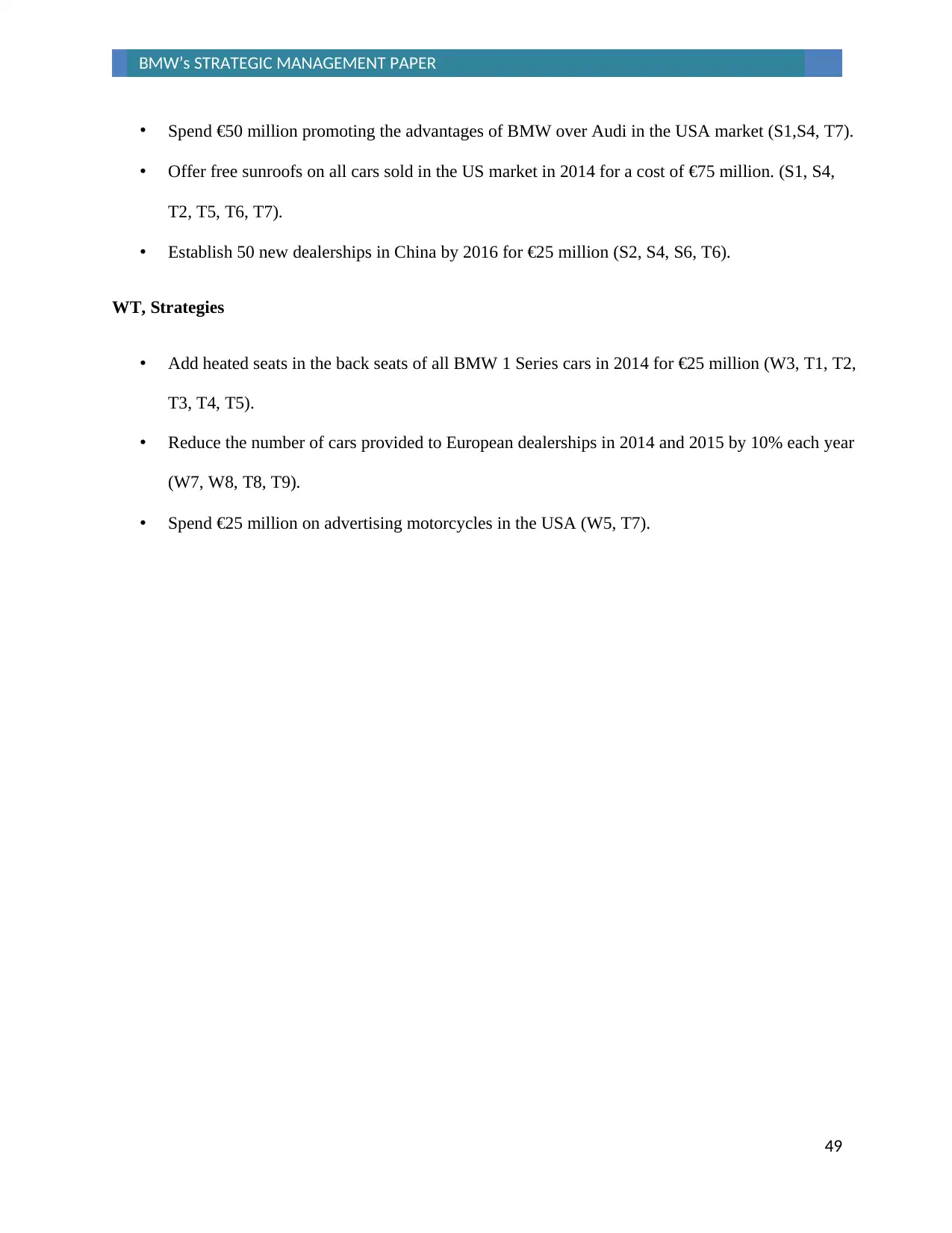
49
BMW’s STRATEGIC MANAGEMENT PAPER
• Spend €50 million promoting the advantages of BMW over Audi in the USA market (S1,S4, T7).
• Offer free sunroofs on all cars sold in the US market in 2014 for a cost of €75 million. (S1, S4,
T2, T5, T6, T7).
• Establish 50 new dealerships in China by 2016 for €25 million (S2, S4, S6, T6).
WT, Strategies
• Add heated seats in the back seats of all BMW 1 Series cars in 2014 for €25 million (W3, T1, T2,
T3, T4, T5).
• Reduce the number of cars provided to European dealerships in 2014 and 2015 by 10% each year
(W7, W8, T8, T9).
• Spend €25 million on advertising motorcycles in the USA (W5, T7).
BMW’s STRATEGIC MANAGEMENT PAPER
• Spend €50 million promoting the advantages of BMW over Audi in the USA market (S1,S4, T7).
• Offer free sunroofs on all cars sold in the US market in 2014 for a cost of €75 million. (S1, S4,
T2, T5, T6, T7).
• Establish 50 new dealerships in China by 2016 for €25 million (S2, S4, S6, T6).
WT, Strategies
• Add heated seats in the back seats of all BMW 1 Series cars in 2014 for €25 million (W3, T1, T2,
T3, T4, T5).
• Reduce the number of cars provided to European dealerships in 2014 and 2015 by 10% each year
(W7, W8, T8, T9).
• Spend €25 million on advertising motorcycles in the USA (W5, T7).
Paraphrase This Document
Need a fresh take? Get an instant paraphrase of this document with our AI Paraphraser
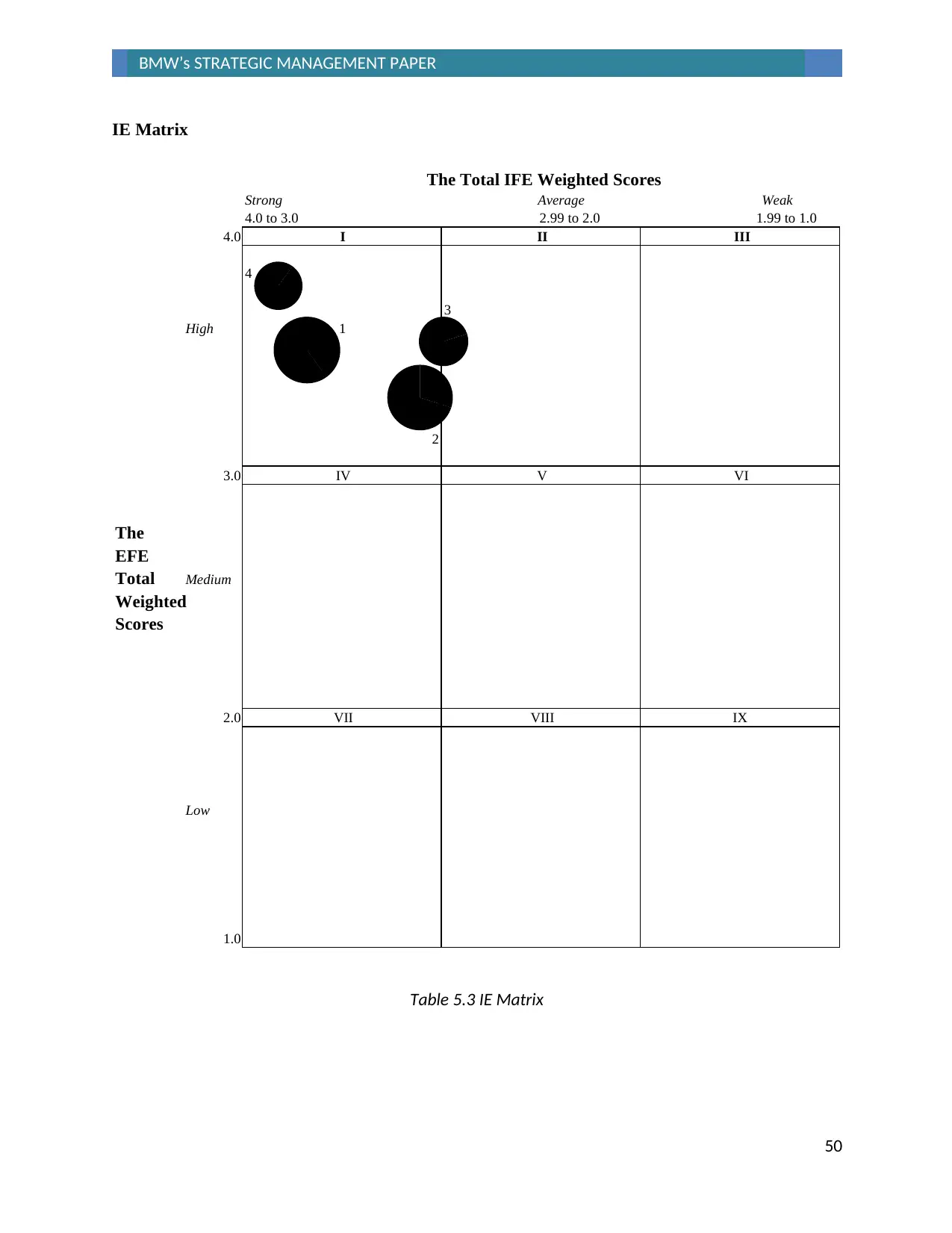
50
BMW’s STRATEGIC MANAGEMENT PAPER
4.0 I II III
4
3
High 1
2
3.0 IV V VI
The
EFE
Total Medium
Weighted
Scores
2.0 VII VIII IX
Low
1.0
Strong Average Weak
4.0 to 3.0 2.99 to 2.0 1.99 to 1.0
The Total IFE Weighted Scores
IE Matrix
Table 5.3 IE Matrix
BMW’s STRATEGIC MANAGEMENT PAPER
4.0 I II III
4
3
High 1
2
3.0 IV V VI
The
EFE
Total Medium
Weighted
Scores
2.0 VII VIII IX
Low
1.0
Strong Average Weak
4.0 to 3.0 2.99 to 2.0 1.99 to 1.0
The Total IFE Weighted Scores
IE Matrix
Table 5.3 IE Matrix
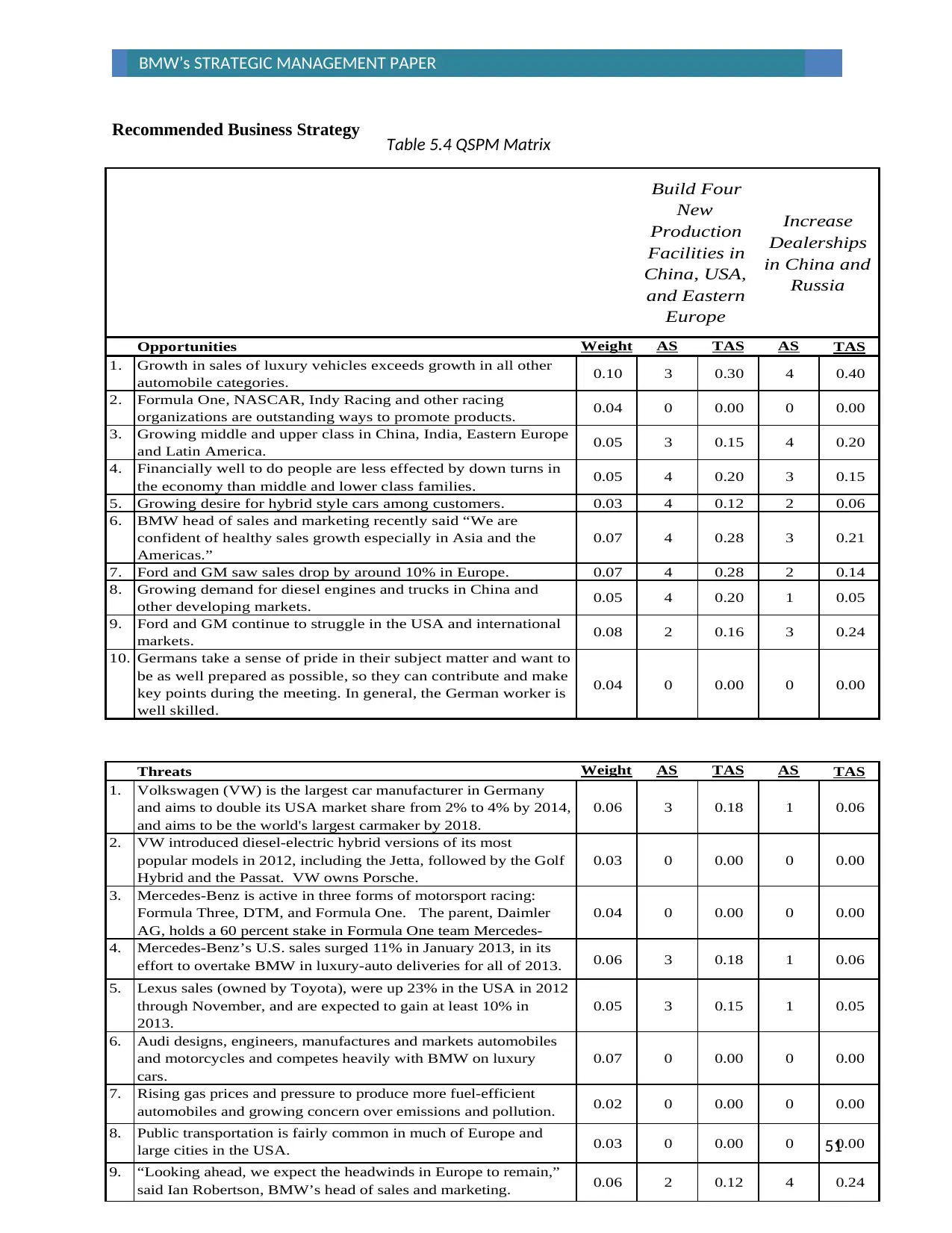
51
BMW’s STRATEGIC MANAGEMENT PAPER
Opportunities Weight AS TAS AS TAS
1. Growth in sales of luxury vehicles exceeds growth in all other
automobile categories. 0.10 3 0.30 4 0.40
2. Formula One, NASCAR, Indy Racing and other racing
organizations are outstanding ways to promote products. 0.04 0 0.00 0 0.00
3. Growing middle and upper class in China, India, Eastern Europe
and Latin America. 0.05 3 0.15 4 0.20
4. Financially well to do people are less effected by down turns in
the economy than middle and lower class families. 0.05 4 0.20 3 0.15
5. Growing desire for hybrid style cars among customers. 0.03 4 0.12 2 0.06
6. BMW head of sales and marketing recently said “We are
confident of healthy sales growth especially in Asia and the
Americas.”
0.07 4 0.28 3 0.21
7. Ford and GM saw sales drop by around 10% in Europe. 0.07 4 0.28 2 0.14
8. Growing demand for diesel engines and trucks in China and
other developing markets. 0.05 4 0.20 1 0.05
9. Ford and GM continue to struggle in the USA and international
markets. 0.08 2 0.16 3 0.24
10. Germans take a sense of pride in their subject matter and want to
be as well prepared as possible, so they can contribute and make
key points during the meeting. In general, the German worker is
well skilled.
0.04 0 0.00 0 0.00
Increase
Dealerships
in China and
Russia
Build Four
New
Production
Facilities in
China, USA,
and Eastern
Europe
Recommended Business Strategy
Threats Weight AS TAS AS TAS
1. Volkswagen (VW) is the largest car manufacturer in Germany
and aims to double its USA market share from 2% to 4% by 2014,
and aims to be the world's largest carmaker by 2018.
0.06 3 0.18 1 0.06
2. VW introduced diesel-electric hybrid versions of its most
popular models in 2012, including the Jetta, followed by the Golf
Hybrid and the Passat. VW owns Porsche.
0.03 0 0.00 0 0.00
3. Mercedes-Benz is active in three forms of motorsport racing:
Formula Three, DTM, and Formula One. The parent, Daimler
AG, holds a 60 percent stake in Formula One team Mercedes-
0.04 0 0.00 0 0.00
4. Mercedes-Benz’s U.S. sales surged 11% in January 2013, in its
effort to overtake BMW in luxury-auto deliveries for all of 2013. 0.06 3 0.18 1 0.06
5. Lexus sales (owned by Toyota), were up 23% in the USA in 2012
through November, and are expected to gain at least 10% in
2013.
0.05 3 0.15 1 0.05
6. Audi designs, engineers, manufactures and markets automobiles
and motorcycles and competes heavily with BMW on luxury
cars.
0.07 0 0.00 0 0.00
7. Rising gas prices and pressure to produce more fuel-efficient
automobiles and growing concern over emissions and pollution. 0.02 0 0.00 0 0.00
8. Public transportation is fairly common in much of Europe and
large cities in the USA. 0.03 0 0.00 0 0.00
9. “Looking ahead, we expect the headwinds in Europe to remain,”
said Ian Robertson, BMW’s head of sales and marketing. 0.06 2 0.12 4 0.24
Table 5.4 QSPM Matrix
BMW’s STRATEGIC MANAGEMENT PAPER
Opportunities Weight AS TAS AS TAS
1. Growth in sales of luxury vehicles exceeds growth in all other
automobile categories. 0.10 3 0.30 4 0.40
2. Formula One, NASCAR, Indy Racing and other racing
organizations are outstanding ways to promote products. 0.04 0 0.00 0 0.00
3. Growing middle and upper class in China, India, Eastern Europe
and Latin America. 0.05 3 0.15 4 0.20
4. Financially well to do people are less effected by down turns in
the economy than middle and lower class families. 0.05 4 0.20 3 0.15
5. Growing desire for hybrid style cars among customers. 0.03 4 0.12 2 0.06
6. BMW head of sales and marketing recently said “We are
confident of healthy sales growth especially in Asia and the
Americas.”
0.07 4 0.28 3 0.21
7. Ford and GM saw sales drop by around 10% in Europe. 0.07 4 0.28 2 0.14
8. Growing demand for diesel engines and trucks in China and
other developing markets. 0.05 4 0.20 1 0.05
9. Ford and GM continue to struggle in the USA and international
markets. 0.08 2 0.16 3 0.24
10. Germans take a sense of pride in their subject matter and want to
be as well prepared as possible, so they can contribute and make
key points during the meeting. In general, the German worker is
well skilled.
0.04 0 0.00 0 0.00
Increase
Dealerships
in China and
Russia
Build Four
New
Production
Facilities in
China, USA,
and Eastern
Europe
Recommended Business Strategy
Threats Weight AS TAS AS TAS
1. Volkswagen (VW) is the largest car manufacturer in Germany
and aims to double its USA market share from 2% to 4% by 2014,
and aims to be the world's largest carmaker by 2018.
0.06 3 0.18 1 0.06
2. VW introduced diesel-electric hybrid versions of its most
popular models in 2012, including the Jetta, followed by the Golf
Hybrid and the Passat. VW owns Porsche.
0.03 0 0.00 0 0.00
3. Mercedes-Benz is active in three forms of motorsport racing:
Formula Three, DTM, and Formula One. The parent, Daimler
AG, holds a 60 percent stake in Formula One team Mercedes-
0.04 0 0.00 0 0.00
4. Mercedes-Benz’s U.S. sales surged 11% in January 2013, in its
effort to overtake BMW in luxury-auto deliveries for all of 2013. 0.06 3 0.18 1 0.06
5. Lexus sales (owned by Toyota), were up 23% in the USA in 2012
through November, and are expected to gain at least 10% in
2013.
0.05 3 0.15 1 0.05
6. Audi designs, engineers, manufactures and markets automobiles
and motorcycles and competes heavily with BMW on luxury
cars.
0.07 0 0.00 0 0.00
7. Rising gas prices and pressure to produce more fuel-efficient
automobiles and growing concern over emissions and pollution. 0.02 0 0.00 0 0.00
8. Public transportation is fairly common in much of Europe and
large cities in the USA. 0.03 0 0.00 0 0.00
9. “Looking ahead, we expect the headwinds in Europe to remain,”
said Ian Robertson, BMW’s head of sales and marketing. 0.06 2 0.12 4 0.24
Table 5.4 QSPM Matrix
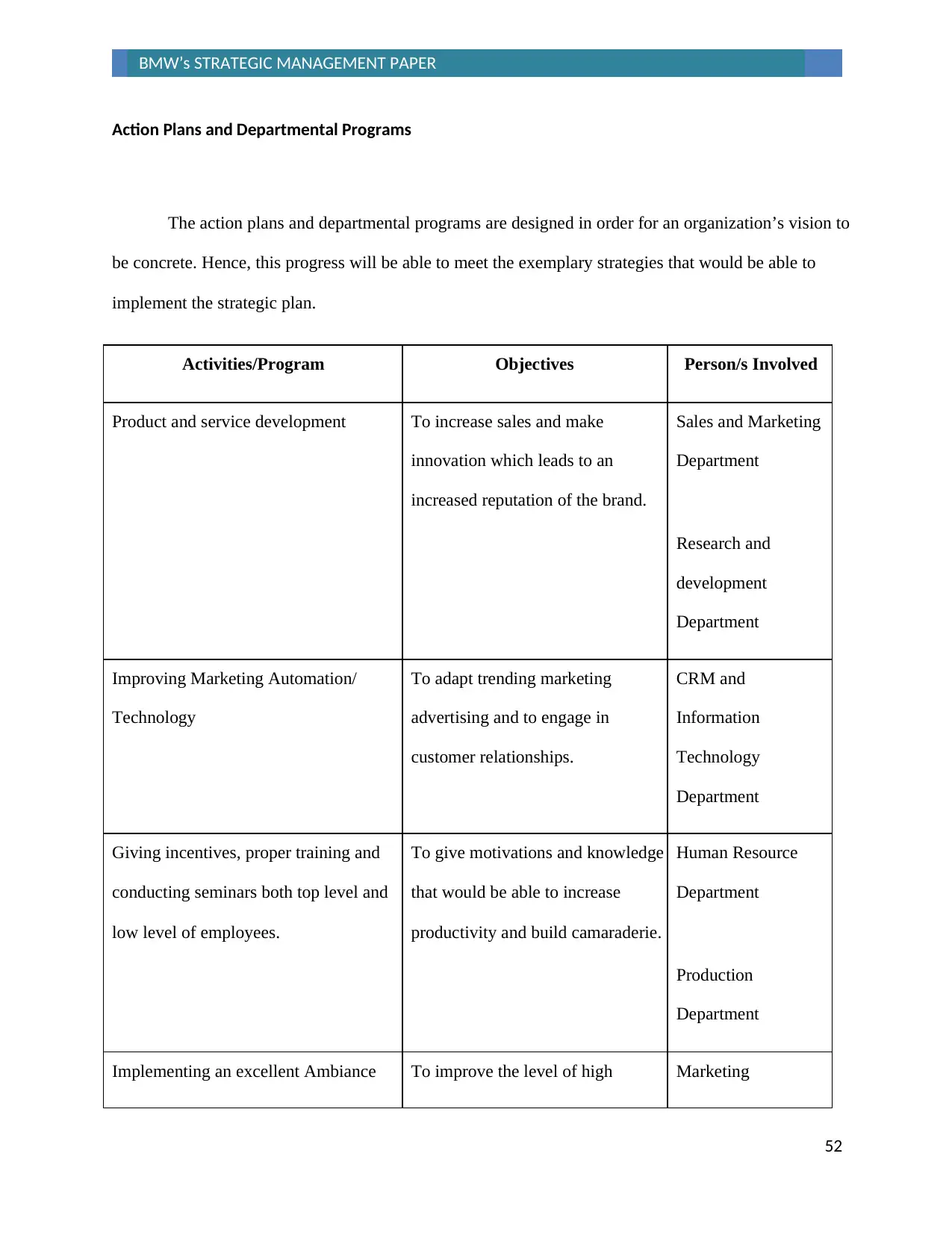
52
BMW’s STRATEGIC MANAGEMENT PAPER
Action Plans and Departmental Programs
The action plans and departmental programs are designed in order for an organization’s vision to
be concrete. Hence, this progress will be able to meet the exemplary strategies that would be able to
implement the strategic plan.
Activities/Program Objectives Person/s Involved
Product and service development To increase sales and make
innovation which leads to an
increased reputation of the brand.
Sales and Marketing
Department
Research and
development
Department
Improving Marketing Automation/
Technology
To adapt trending marketing
advertising and to engage in
customer relationships.
CRM and
Information
Technology
Department
Giving incentives, proper training and
conducting seminars both top level and
low level of employees.
To give motivations and knowledge
that would be able to increase
productivity and build camaraderie.
Human Resource
Department
Production
Department
Implementing an excellent Ambiance To improve the level of high Marketing
BMW’s STRATEGIC MANAGEMENT PAPER
Action Plans and Departmental Programs
The action plans and departmental programs are designed in order for an organization’s vision to
be concrete. Hence, this progress will be able to meet the exemplary strategies that would be able to
implement the strategic plan.
Activities/Program Objectives Person/s Involved
Product and service development To increase sales and make
innovation which leads to an
increased reputation of the brand.
Sales and Marketing
Department
Research and
development
Department
Improving Marketing Automation/
Technology
To adapt trending marketing
advertising and to engage in
customer relationships.
CRM and
Information
Technology
Department
Giving incentives, proper training and
conducting seminars both top level and
low level of employees.
To give motivations and knowledge
that would be able to increase
productivity and build camaraderie.
Human Resource
Department
Production
Department
Implementing an excellent Ambiance To improve the level of high Marketing
Secure Best Marks with AI Grader
Need help grading? Try our AI Grader for instant feedback on your assignments.
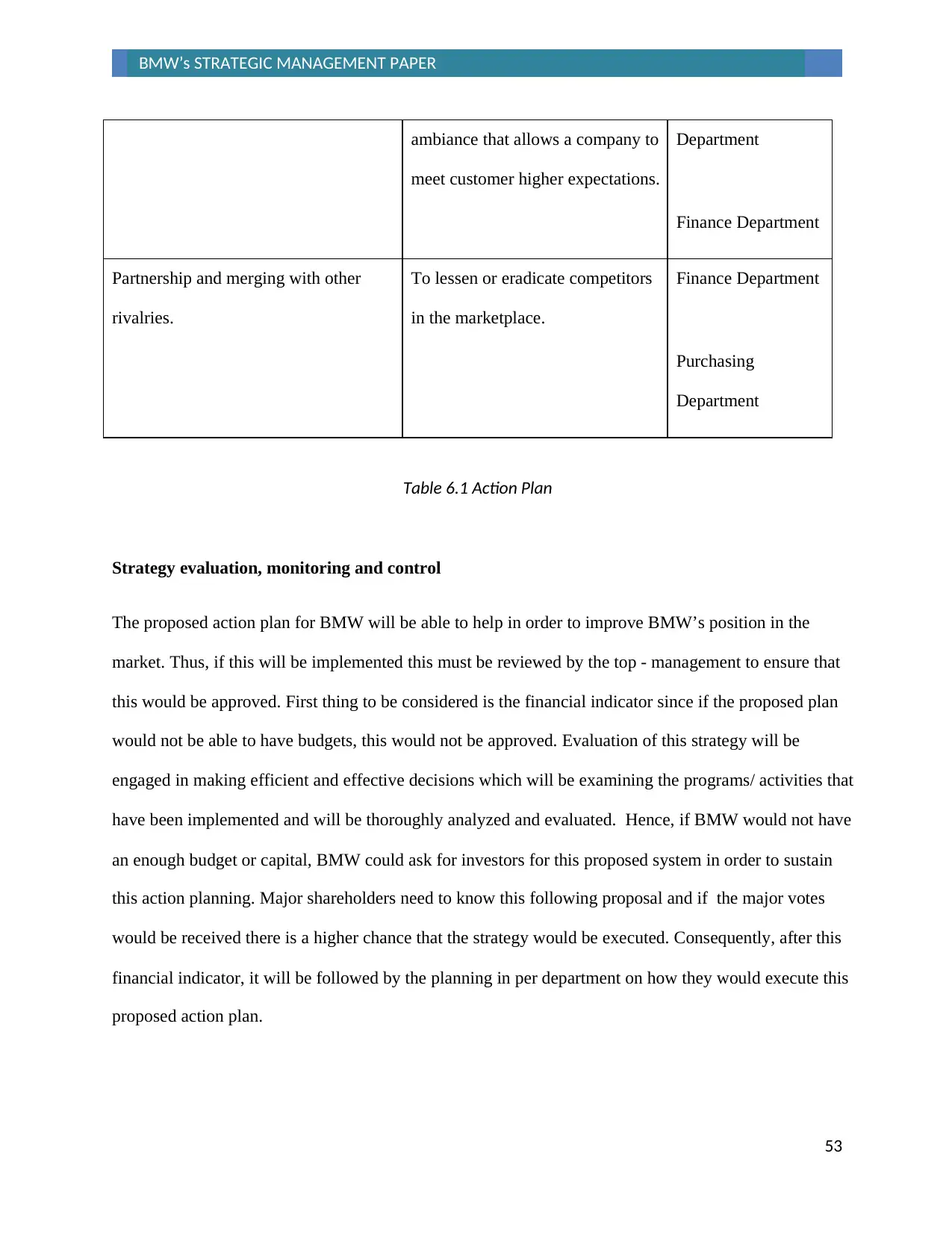
53
BMW’s STRATEGIC MANAGEMENT PAPER
ambiance that allows a company to
meet customer higher expectations.
Department
Finance Department
Partnership and merging with other
rivalries.
To lessen or eradicate competitors
in the marketplace.
Finance Department
Purchasing
Department
Table 6.1 Action Plan
Strategy evaluation, monitoring and control
The proposed action plan for BMW will be able to help in order to improve BMW’s position in the
market. Thus, if this will be implemented this must be reviewed by the top - management to ensure that
this would be approved. First thing to be considered is the financial indicator since if the proposed plan
would not be able to have budgets, this would not be approved. Evaluation of this strategy will be
engaged in making efficient and effective decisions which will be examining the programs/ activities that
have been implemented and will be thoroughly analyzed and evaluated. Hence, if BMW would not have
an enough budget or capital, BMW could ask for investors for this proposed system in order to sustain
this action planning. Major shareholders need to know this following proposal and if the major votes
would be received there is a higher chance that the strategy would be executed. Consequently, after this
financial indicator, it will be followed by the planning in per department on how they would execute this
proposed action plan.
BMW’s STRATEGIC MANAGEMENT PAPER
ambiance that allows a company to
meet customer higher expectations.
Department
Finance Department
Partnership and merging with other
rivalries.
To lessen or eradicate competitors
in the marketplace.
Finance Department
Purchasing
Department
Table 6.1 Action Plan
Strategy evaluation, monitoring and control
The proposed action plan for BMW will be able to help in order to improve BMW’s position in the
market. Thus, if this will be implemented this must be reviewed by the top - management to ensure that
this would be approved. First thing to be considered is the financial indicator since if the proposed plan
would not be able to have budgets, this would not be approved. Evaluation of this strategy will be
engaged in making efficient and effective decisions which will be examining the programs/ activities that
have been implemented and will be thoroughly analyzed and evaluated. Hence, if BMW would not have
an enough budget or capital, BMW could ask for investors for this proposed system in order to sustain
this action planning. Major shareholders need to know this following proposal and if the major votes
would be received there is a higher chance that the strategy would be executed. Consequently, after this
financial indicator, it will be followed by the planning in per department on how they would execute this
proposed action plan.
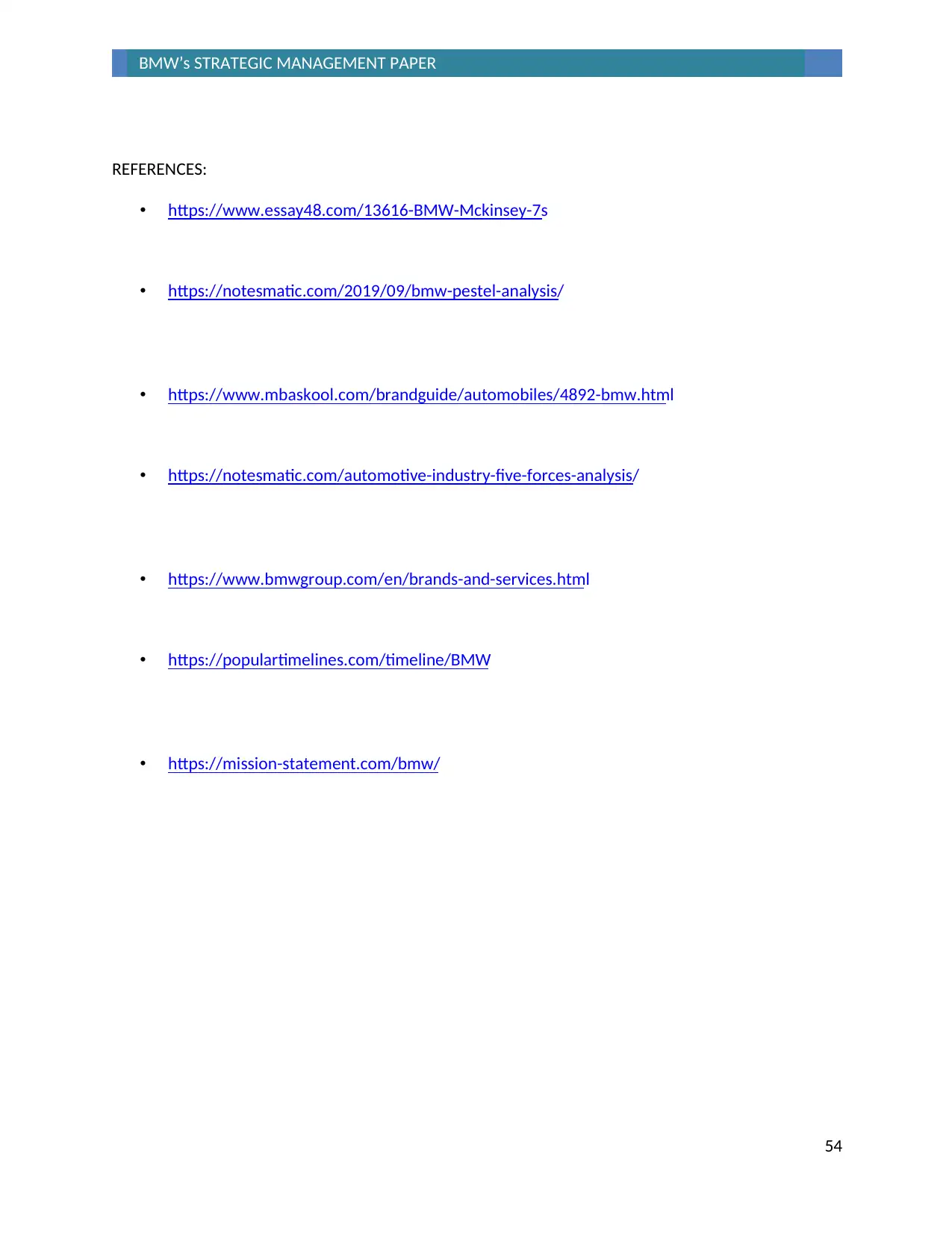
54
BMW’s STRATEGIC MANAGEMENT PAPER
REFERENCES:
• https://www.essay48.com/13616-BMW-Mckinsey-7s
• https://notesmatic.com/2019/09/bmw-pestel-analysis/
• https://www.mbaskool.com/brandguide/automobiles/4892-bmw.html
• https://notesmatic.com/automotive-industry-five-forces-analysis/
• https://www.bmwgroup.com/en/brands-and-services.html
• https://populartimelines.com/timeline/BMW
• https://mission-statement.com/bmw/
BMW’s STRATEGIC MANAGEMENT PAPER
REFERENCES:
• https://www.essay48.com/13616-BMW-Mckinsey-7s
• https://notesmatic.com/2019/09/bmw-pestel-analysis/
• https://www.mbaskool.com/brandguide/automobiles/4892-bmw.html
• https://notesmatic.com/automotive-industry-five-forces-analysis/
• https://www.bmwgroup.com/en/brands-and-services.html
• https://populartimelines.com/timeline/BMW
• https://mission-statement.com/bmw/
1 out of 54
Related Documents
Your All-in-One AI-Powered Toolkit for Academic Success.
+13062052269
info@desklib.com
Available 24*7 on WhatsApp / Email
![[object Object]](/_next/static/media/star-bottom.7253800d.svg)
Unlock your academic potential
© 2024 | Zucol Services PVT LTD | All rights reserved.





